Athens very own Forró band, Bichos Vivos, has ventured to Brazil’s Nordeste for Festa São João. Follow along through the band’s tour diary below as members dive headfirst into a world of music, dancing, food and culture.
Sunday, June 2
“Dawn of the First Day” – Entry by Philip Kohnen
We have arrived in Brazil! It took us 36 hours of constant travel until we reached our first rental house in Gravatá. We will be traveling to Caruaru today to a São João Music Festival, and will have a few performances in the next few days.
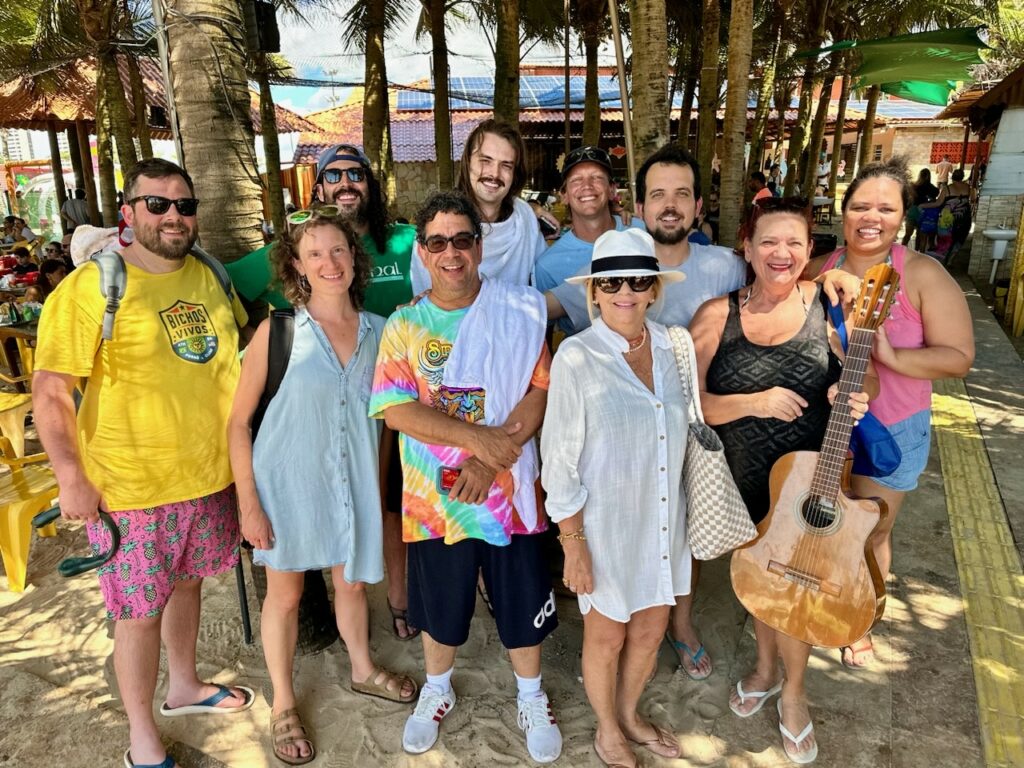
Update: Tuesday, June 4
“Day 2: Monday, June 3″ – Entry by Philip Kohnen
We arrived late the night before and didn’t truly see the landscape around our rental home in Gravatá. We rose to coffee, breakfast and misty hills surrounding us in every direction. There was a rain shower, and then sunshine. Rinse and repeat. We soon learned that we were here in the rainy season which is why all the flora, fauna and grass around us was in full bloom.
Breakfast was served by Rosa, a native of Gravatá and an employee of the home owner. Rosa not only made the most amazing breakfast, but her sense of humor and silliness made our morning even more special. She laughed at us as we recorded and re-recorded a promo video for our Brazilian tour coordinator, PC.
We gathered everybody and hit the road to Caruaru to meet Herbert Lucena, an accomplished vocalist, percussionist and producer in Caruaru and throughout Brazil. Herbert (Ehr – beht – chee as pronounced in Portuguese) led us though the frenetic streets of central Caruaru to a small hill town outside of the city called Alto do Moura.
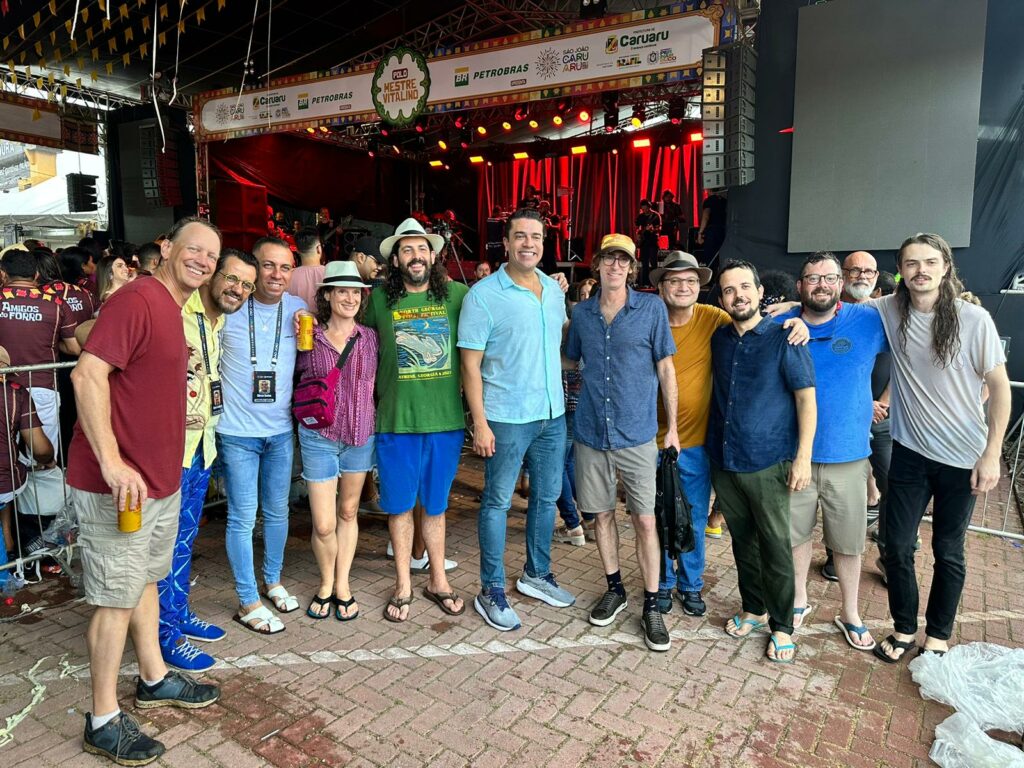
As we approached the town gate, we saw thousands of people buying grilled corn, hats, Devassa, Coca-Cola, fresh fruits, grilled sausages, more hats and more grilled corn. Once through the gate, we were exposed to an unparalleled cultural experience. It was like drinking from a fire hose.
Walking along the road up the hill leading to the town center, we passed vendors and performers offering authentic music and food. We made our way through the ever-growing crowd to a Bode Asado restaurant, where we enjoyed a truly Brazilian lunch of Churrasco style goat, rice, black eyed peas, goat stock, goat butter, fried yucca, tomato salad, farofa (toasted cassava flour) and two hours plus. Cold Cerveja in abundance.
Back on the street, we soon met a man with a microphone, a fake mustache and a personality the size of Saturn. He was filming a segment on the festival and offered us an interview, which was an experience that we revisited throughout the day, quoting his dirty jokes in Portuguese.
Entering Vitalino’s small adobo house transported us back through time to 1909, giving us a peek into the life of one of Brazil’s greatest master flautists. His life and story was on display in the tiny museum, bringing the house to life in our imagination. Once the rain started, we decided to head down to the main stage to see the music. Herbert walked briskly toward the back of the stage and leaned close to the security guard. A moment later, the concert organizer appeared and gave Herbert a big hug and a smile. Then the gates opened and we shuffled into the VIP area, our minds blown that Herbert just performed a miracle before our very eyes.
As we were enjoying the music, Herbert introduced us to the Mayor of Caruaru! Following the Mayor was a crew from TV Cultura, a national news broadcast in Brazil. Herbert, the ever resourceful guide, spoke to the host and all of a sudden we were walking to a quieter place for another press interview!
After the interview and more live music, we said goodbye to the Mayor and the concert organizer and left for more live music on a massive hill in the center of Caruaru. We finally decided to head back to Gravatá to get some dinner and rest, concluding our first full day in Brazil.







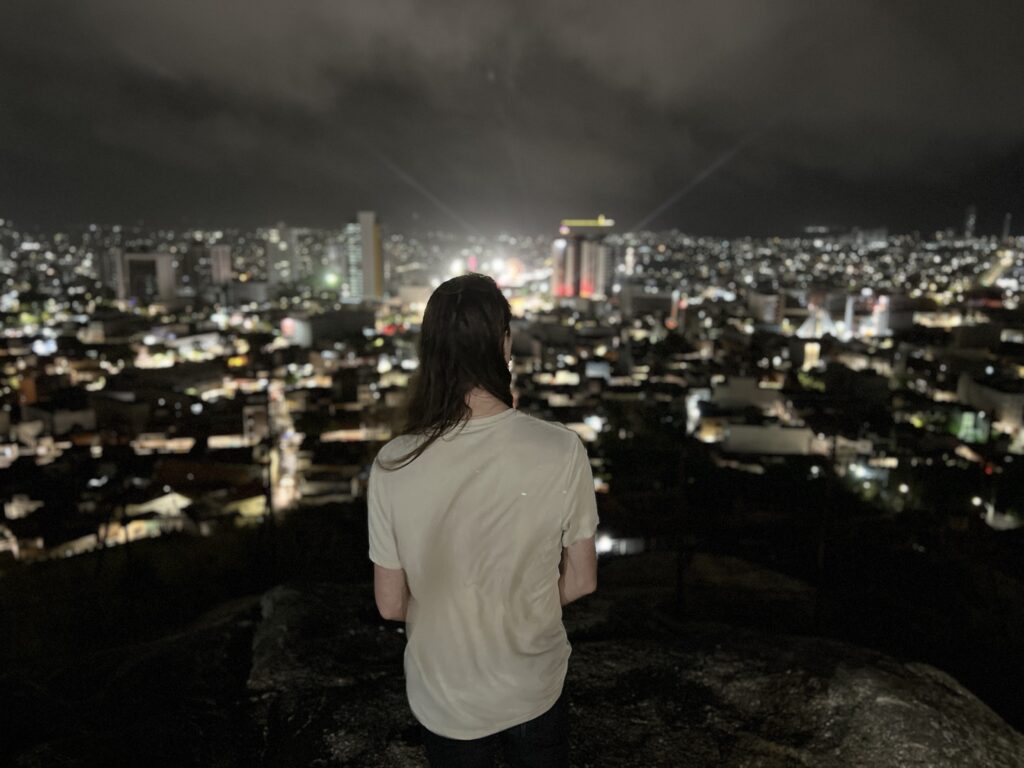
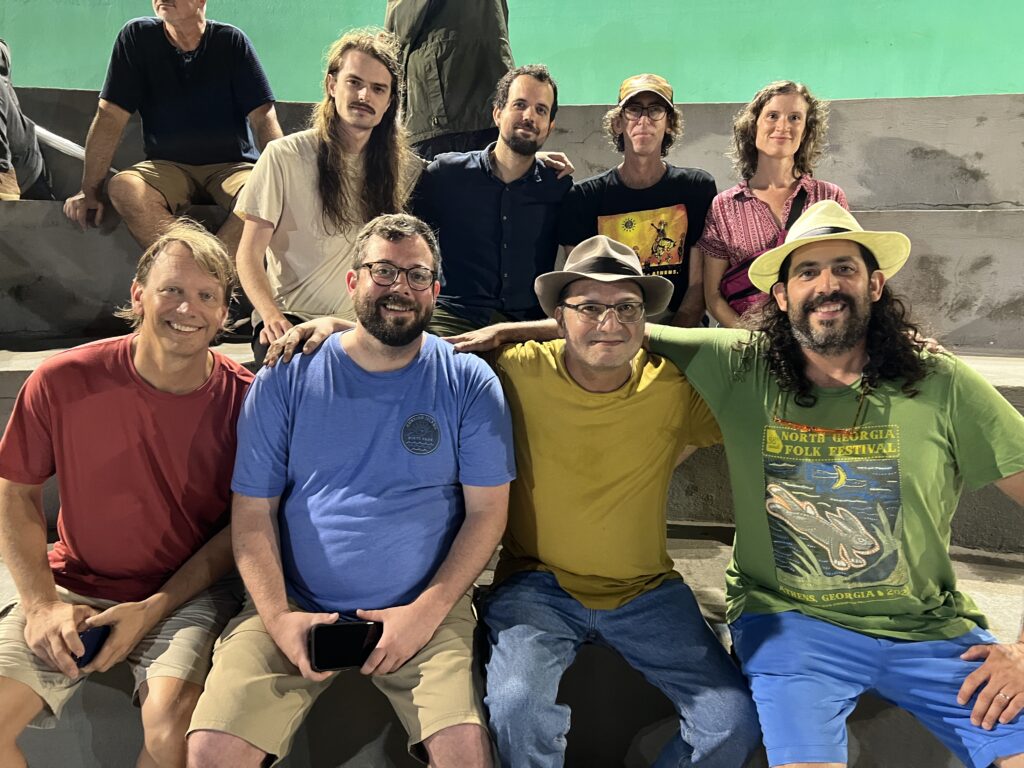
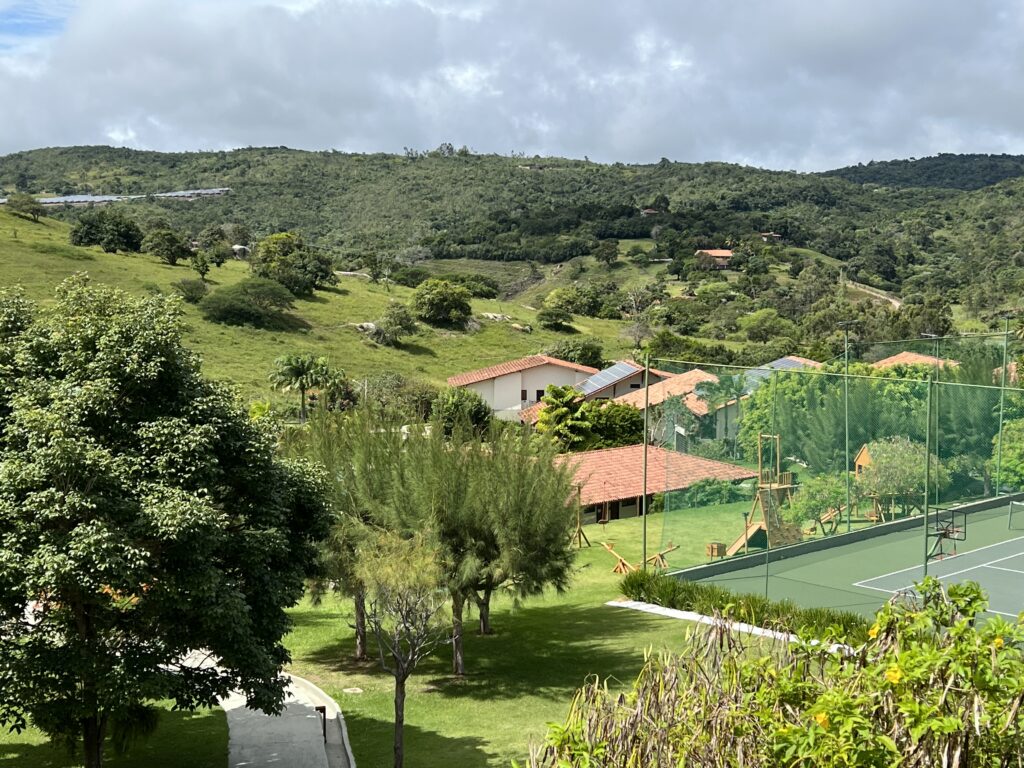

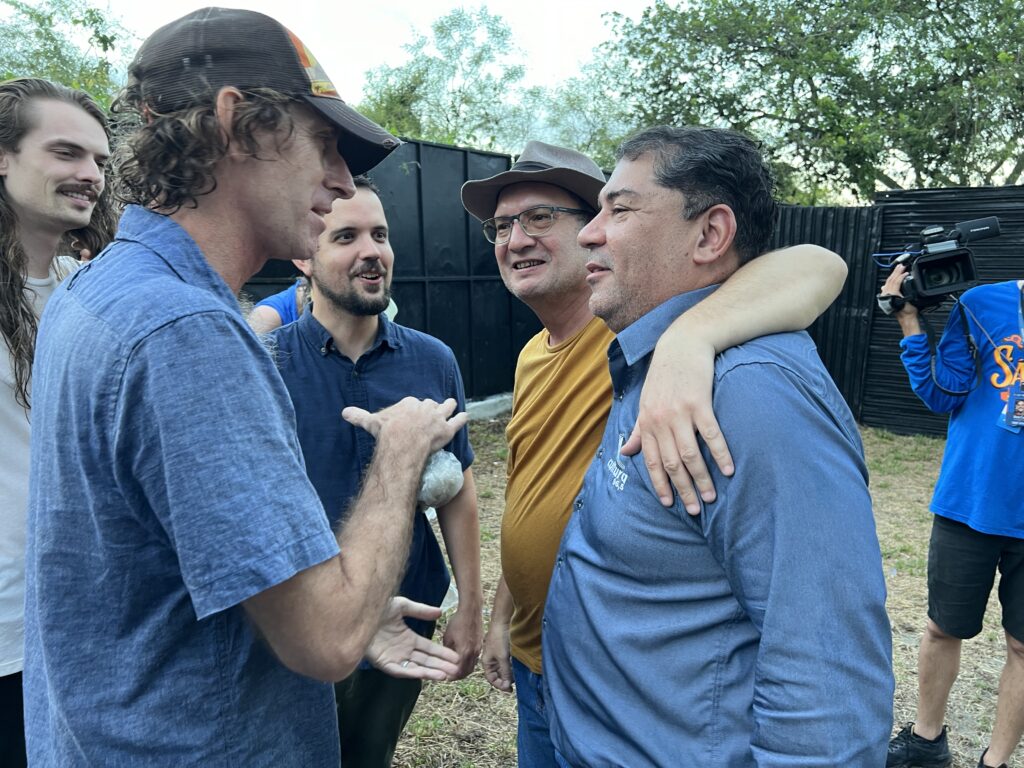


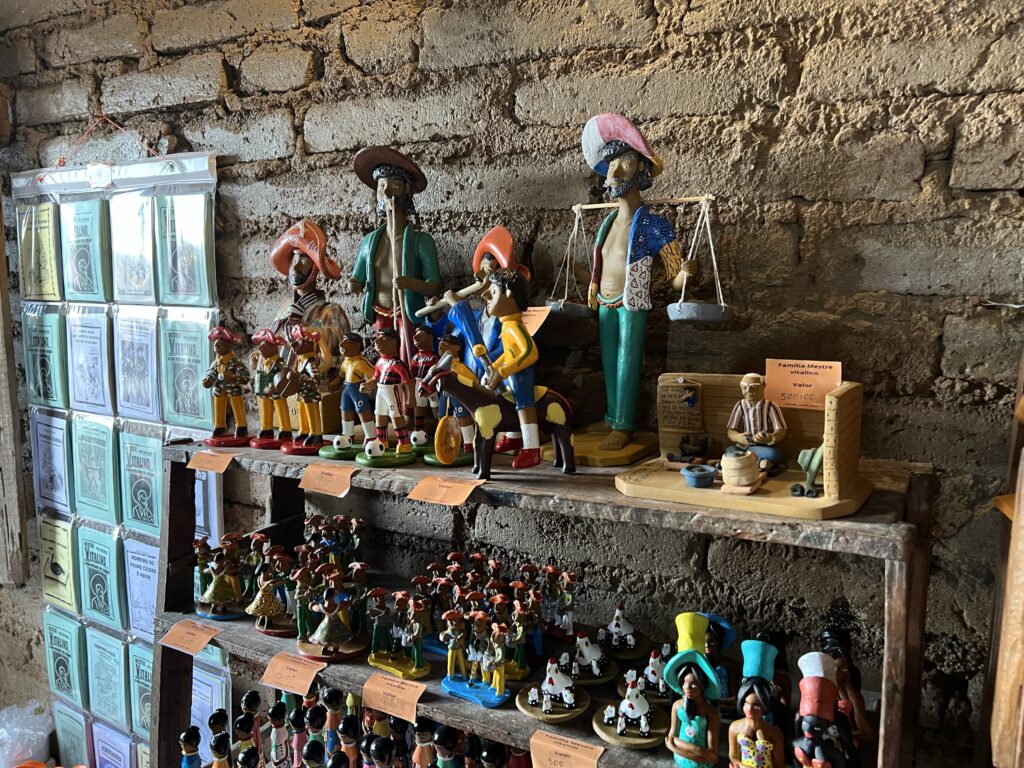
Update: Friday, June 7
“Day 2: Monday, June 3” – Entry by Philip Kohnen
I woke up to rain and birds outside of my window, the wind blowing a shutter back and forth rhythmically, musically. Anxiety and excitement commingled in my thoughts. We were headed back into Caruaru with a full agenda. First, our morning ritual. Yellow watermelon, guava, papaya, mango, bananas, eggs, corn couscous, sweet corn, fresh rolls, butter, sweet potatoes, fried cheese, manioc and hot black coffee.
Some of our Bichos were still in hibernation, so I took a walk around “Valle Verde,” our private compound in Gravatá. On this quiet Monday morning almost all of the guests of the other homes had gone back to Caruaru or Recife for their work week. I meandered along the perimeter road, taking pictures of flowers and cows. A light rain dusted my back, and I decided to walk up the hill to our house before the rain truly started. On the last step leading up to the patio, the sky opened up and dumped giant buckets of water. I barely made it.
As soon as the rain started, it slowed down and stopped. Our crew was all up, and we were deciding who was going to stay in the house and who would venture in to Caruaru again. A band meeting was called, intent upon discussing our upcoming performances, set lists, new song additions and scheduling. Jokes and silly stories pulled us off track; our modus operandi thankfully intact across international borders. However, we had the opportunity to practice more than we ever have before and we were going to take full advantage. Some snaps and claps mobilized our musical Voltron back into action.
Two hours and 22 songs later, the car to Caruaru was packed and we watched “Verde Valle” disappear in our rearview. Braving the hillside winding dirt road in a 4 cylinder Peugeot, we struggled up a hill when a guy in a 1983 Suzuki blew past us, kicking up a cloud of dust. He smiled and gave us the thumbs up, silently saying “Thanks.” Everytime we reached another peak, we saw the edges of Gravatá below, more cows and more granite outcroppings.
Our first stop was in Bezerros at the Jorge Borges Art Museum and Shop. This was my first visit to this magical place, and it would not be my last. The museum was dedicated José Francisco Borges, also known as J. Borges. He’s a pretty big deal in the Brazilian folk art scene, particularly when it comes to woodcut prints. Born in 1935 in the village of Bezerros, Pernambuco state, Borges has shared his unique art with the world for quite some time.
His work is rooted in the tradition of Cordel literature, which are these kitschy little folk poetry pamphlets that people used to sell by hanging them on strings. Over the years, Borges has become Brazil’s most famous folk artist in this medium, and his art has been exhibited all over the world. He is truly a living legend when it comes to Brazilian folk art. His art depicts popular poetry, local legends, and infamous love affairs. Throughout his career, Borges has received numerous awards, including the Order of Merit from Brazilian President Fernando Henrique Cardoso and the UNESCO award in Educational/Cultural Action.
After buying as many prints as I could get my hands on, we packed up and kept driving to pick up Herbert in Caruaru. Greetings and hugs, then back into the car. All of the details of the day were described to us, however I could only understand roughly 40% of what Herbert was saying. After the prior day, I was willing to follow Herbert anywhere that he led us, so comprehension was irrelevant.
Driving up winding roads in the hills of Caruaru was a cultural experience by itself. The car came to a slow stop and I heard the parking brake pulled up to its limit. On this tiny road surrounded by small brick row houses, we saw the mural and a small man standing in the doorway. It was him.
João do Pife, born João Alfredo Marques dos Santos, is a significant figure in the cultural scene of Caruaru, Brazil. Known for his mastery of the pife, a traditional Brazilian fife, he has performed both nationally and internationally, spreading the unique sounds of Brazilian folk music. João do Pife is part of the band “Dois Irmãos” along with fellow musician Marcos, and they have traveled extensively, sharing their music with audiences around the world. As a respected artist in his field, João do Pife has contributed to the preservation and celebration of Brazilian cultural heritage.

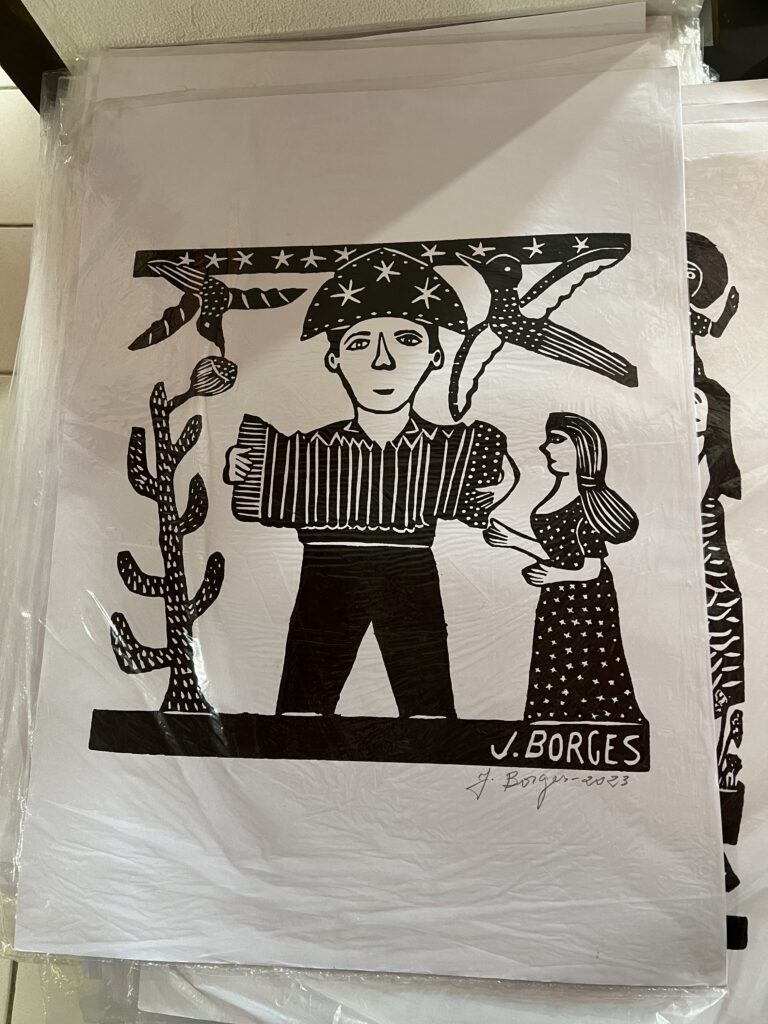
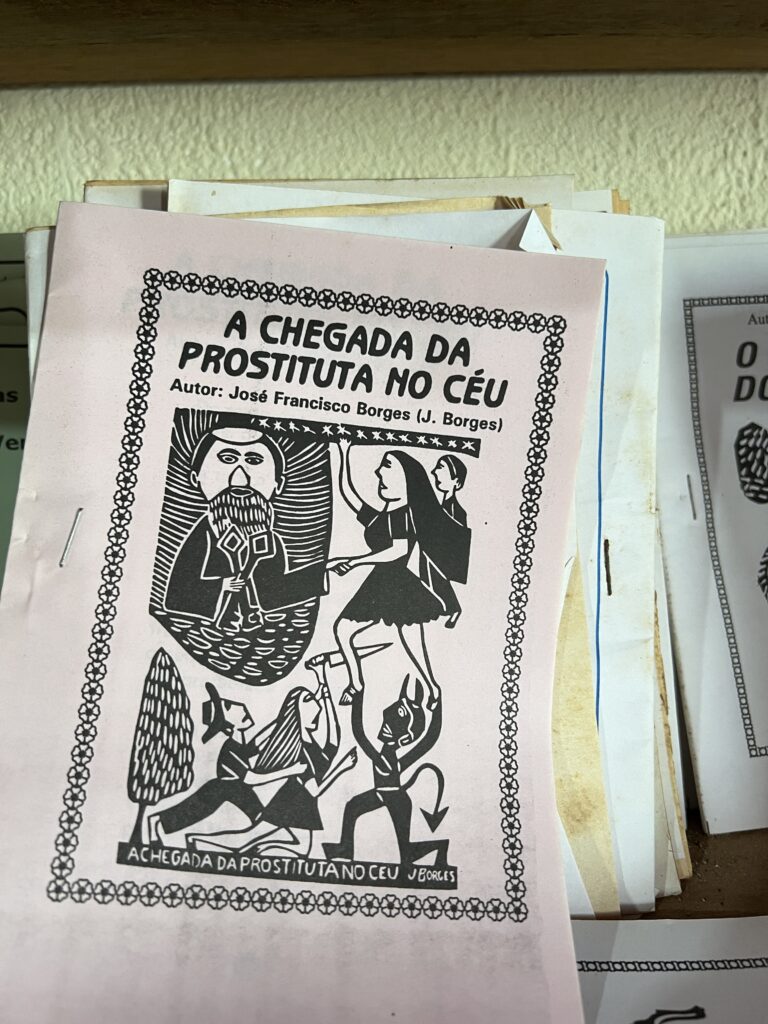
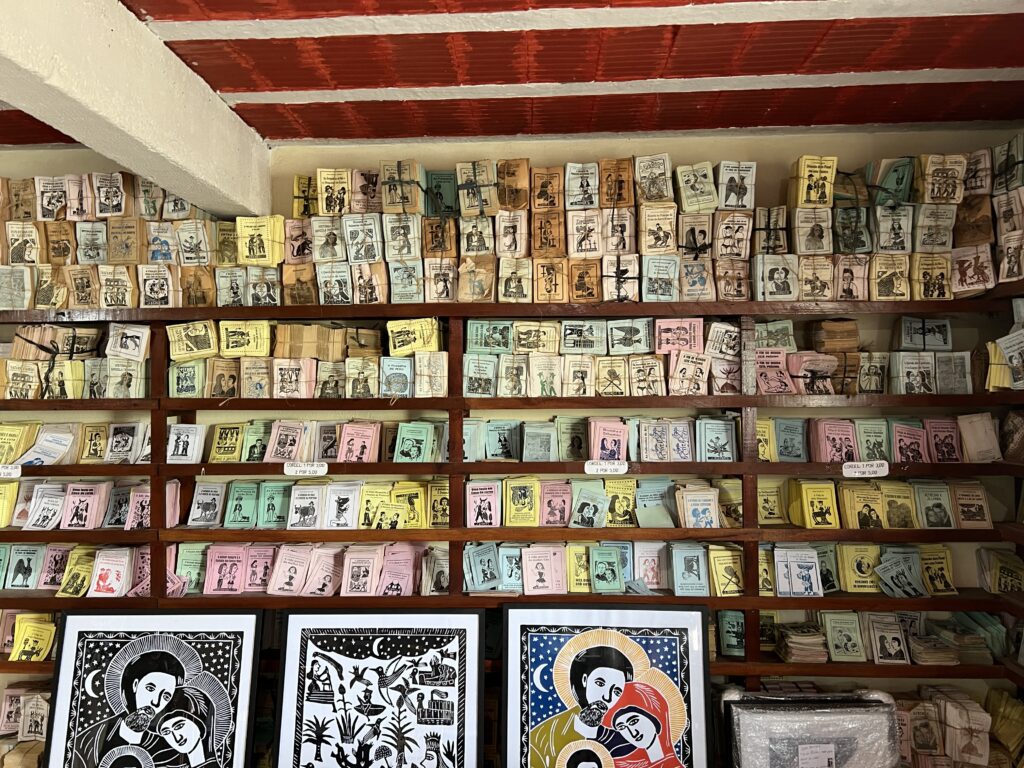
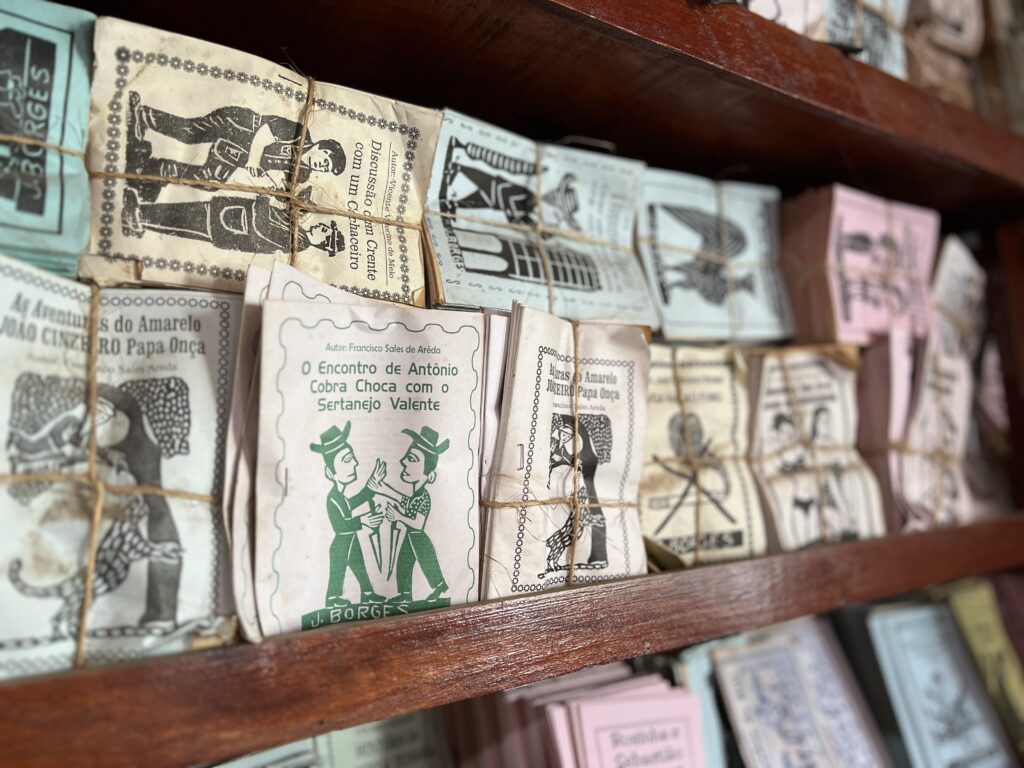
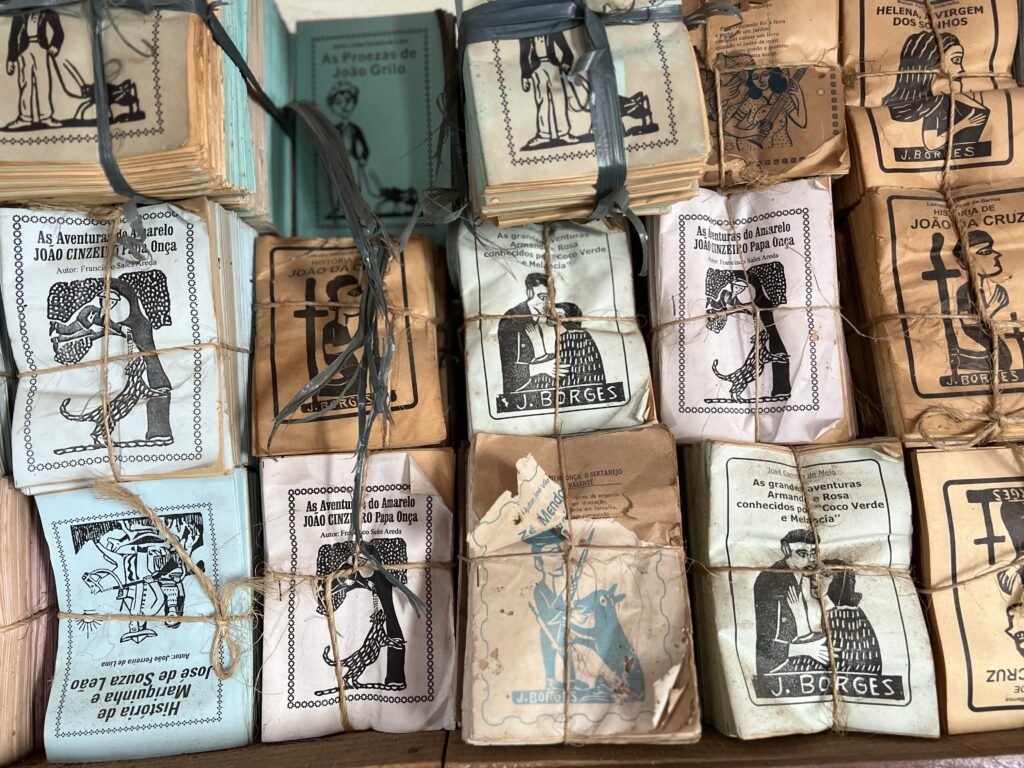
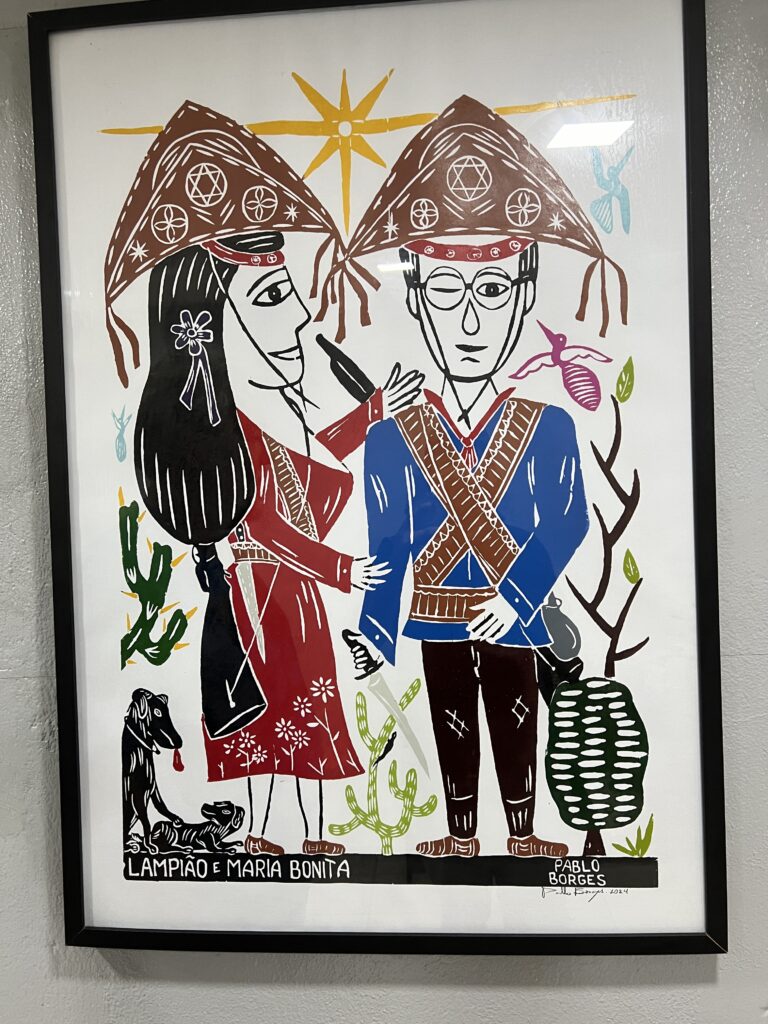
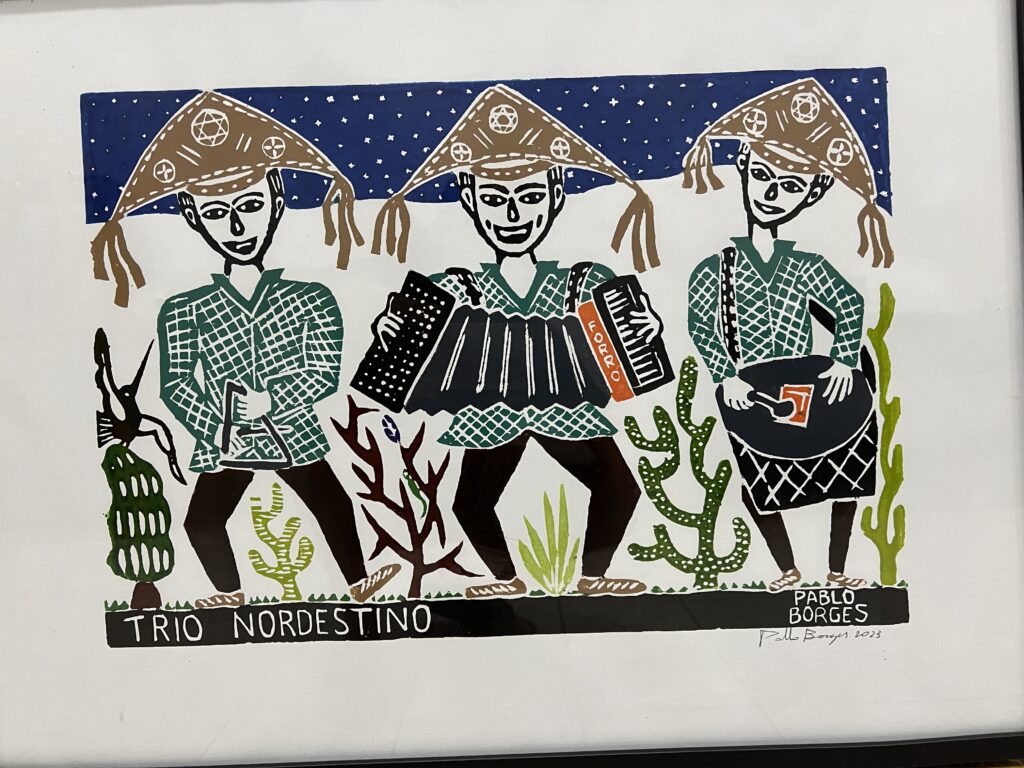


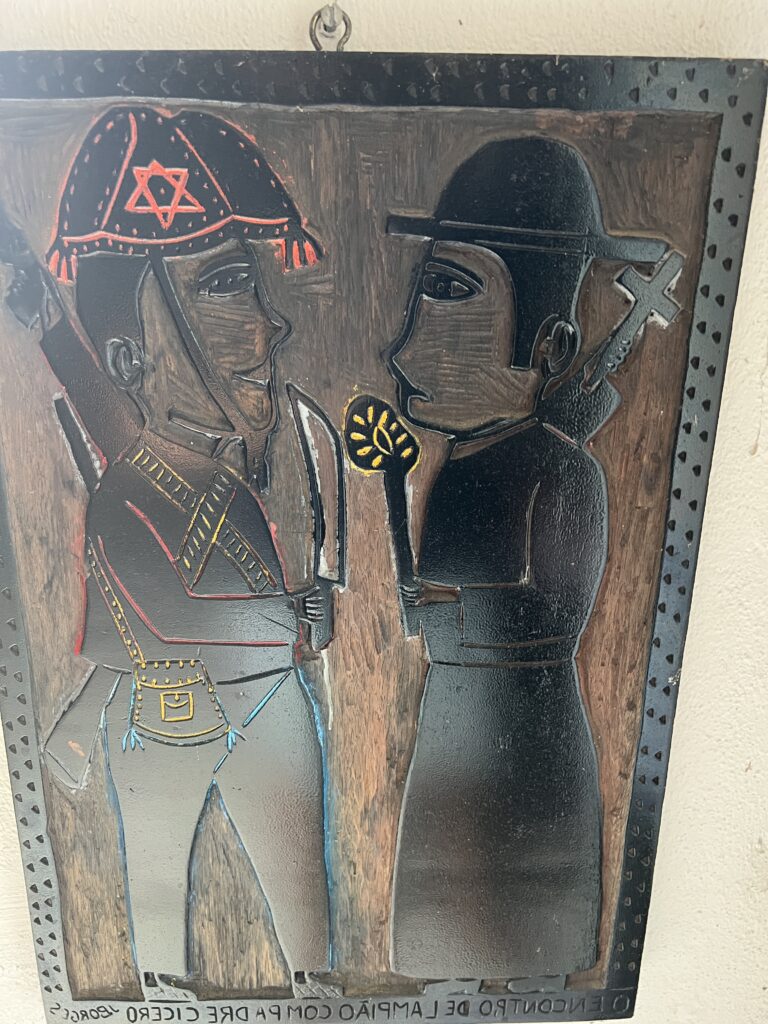
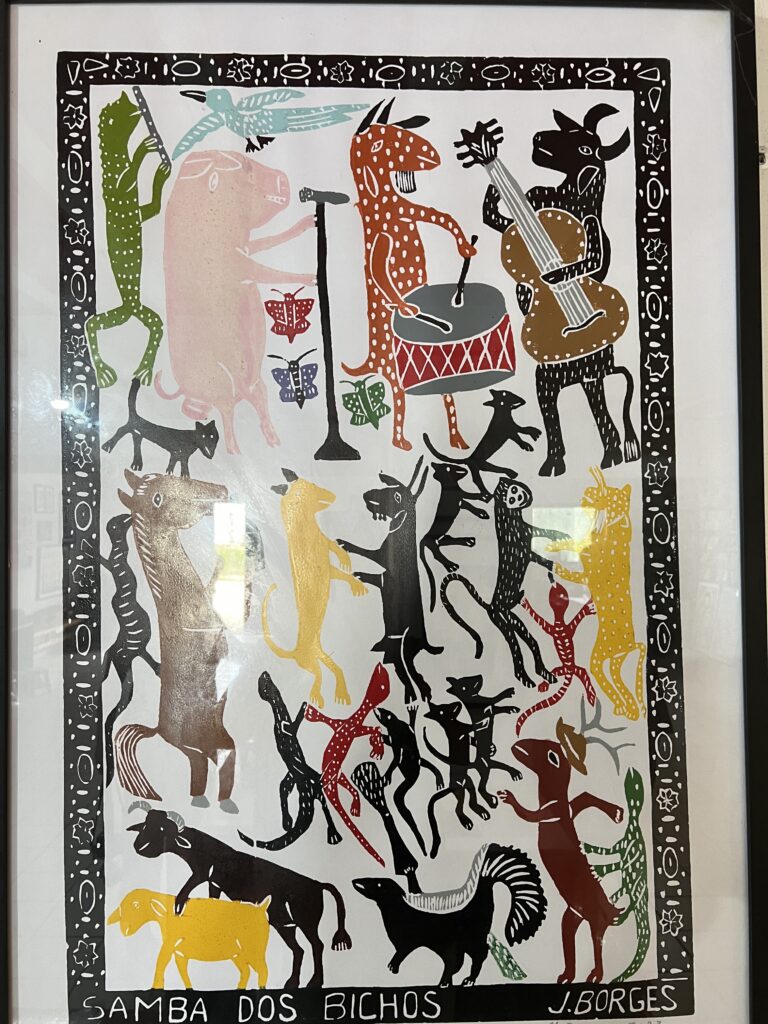
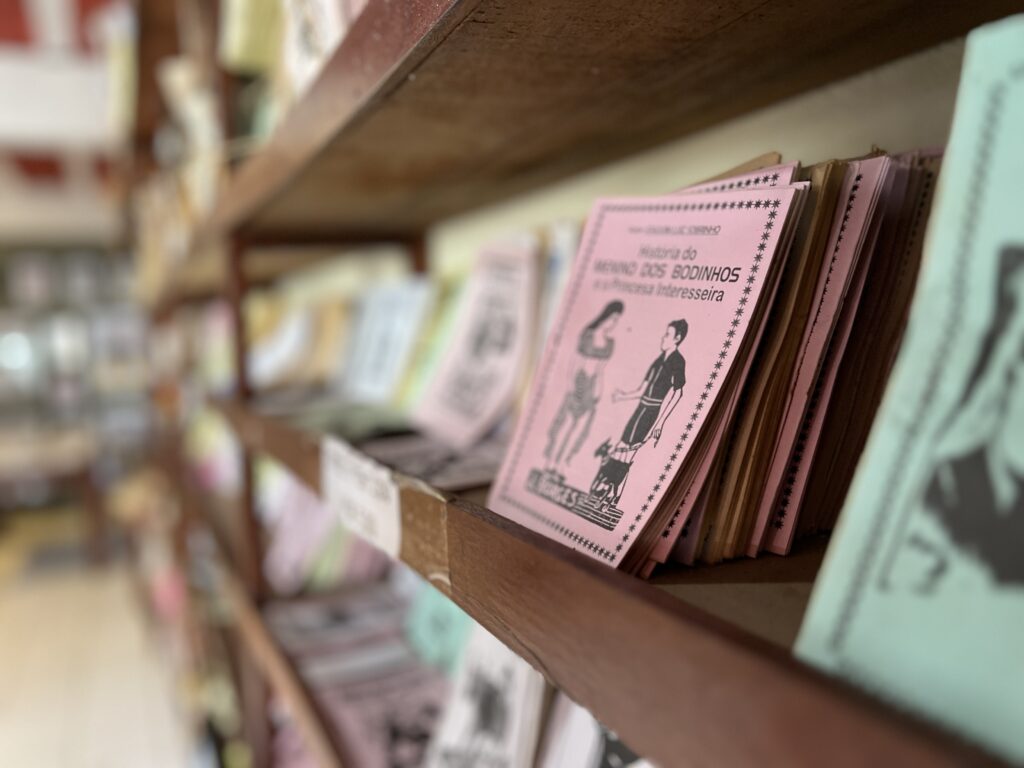
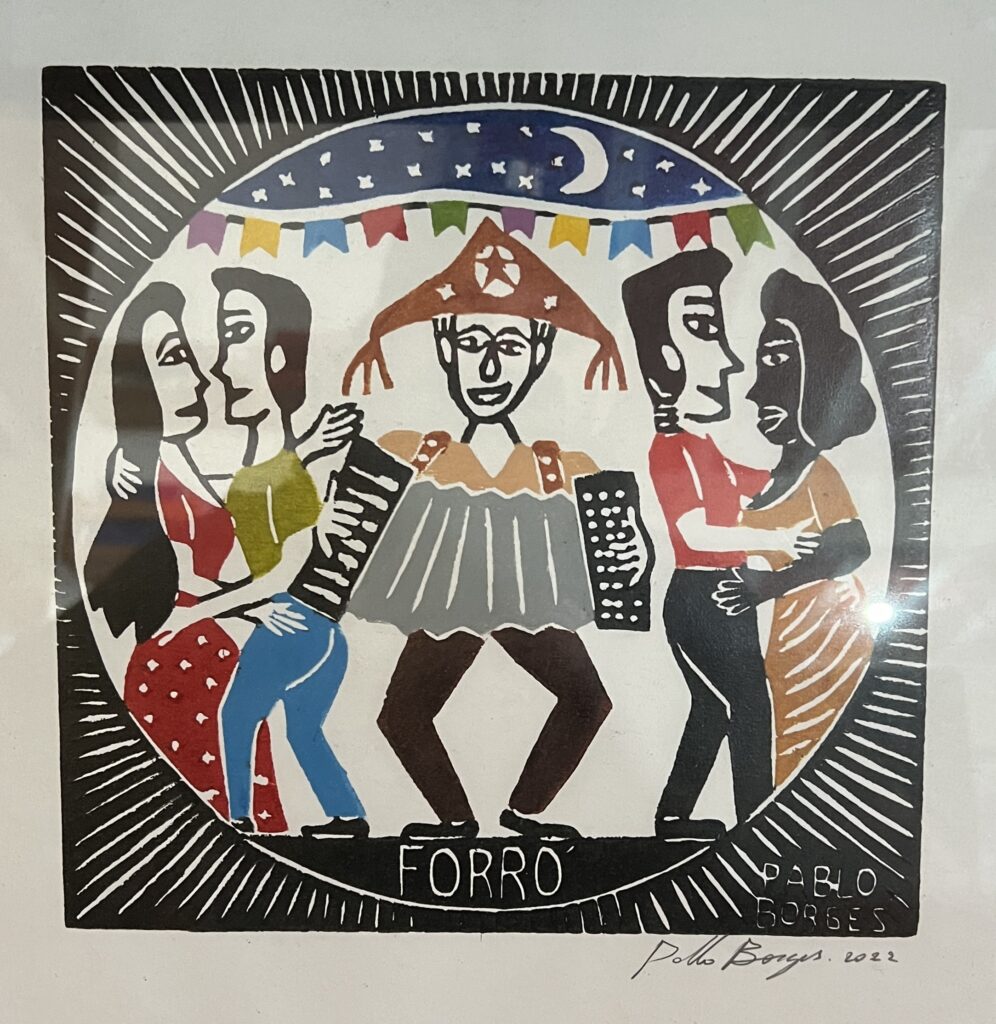
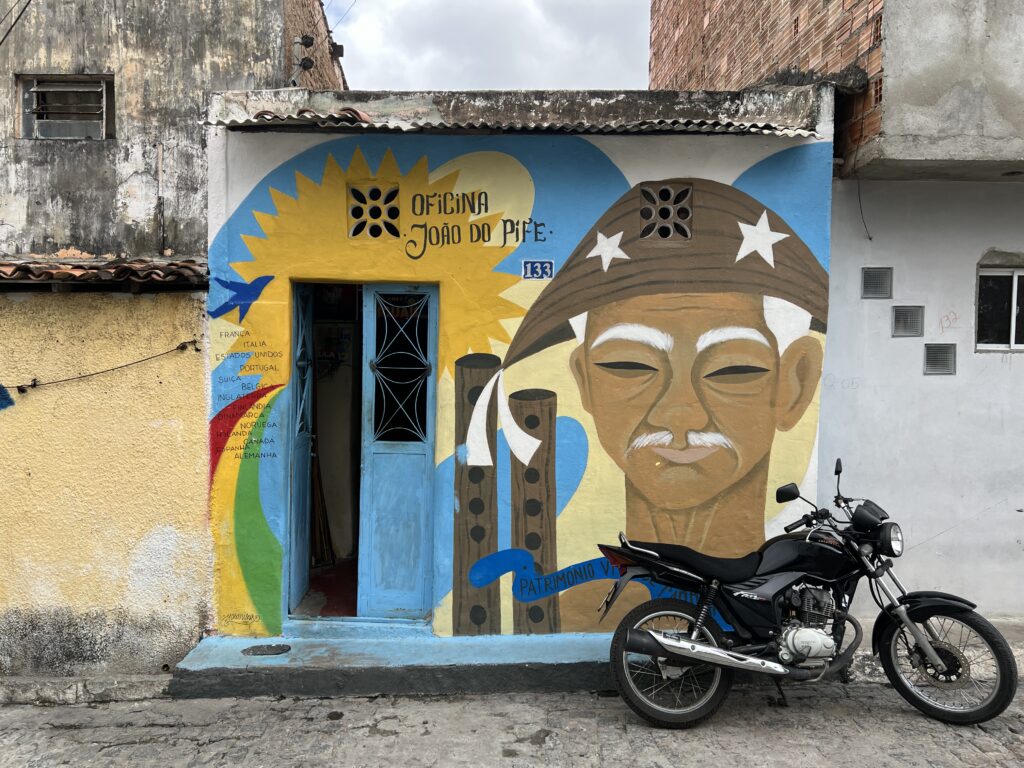
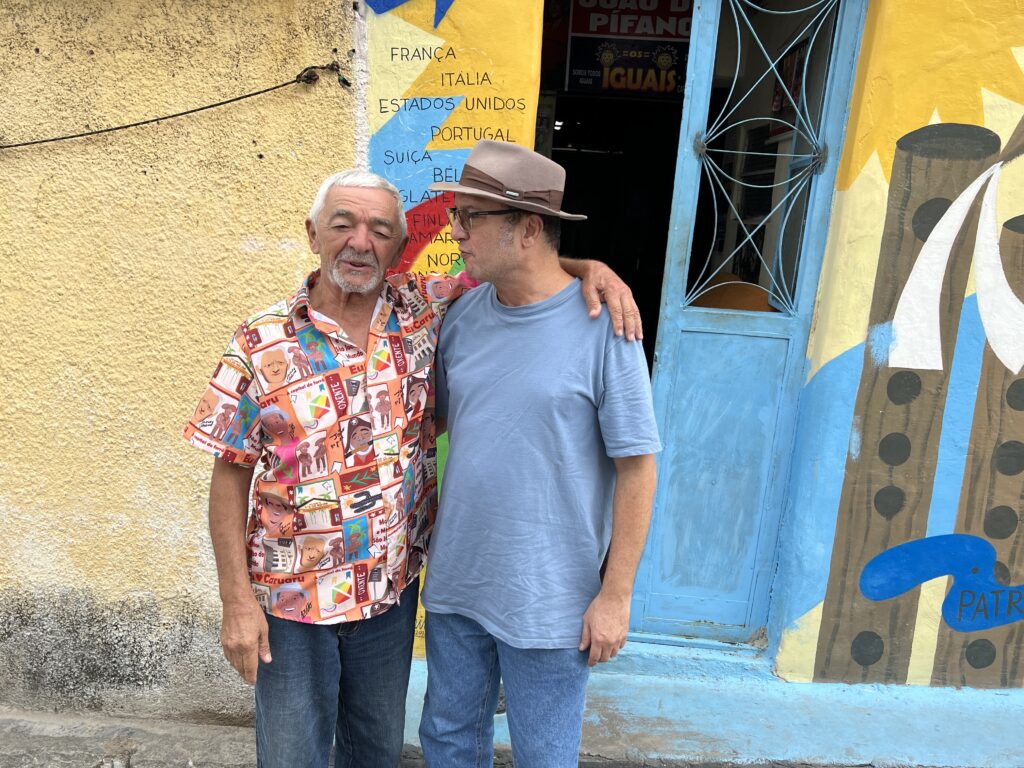


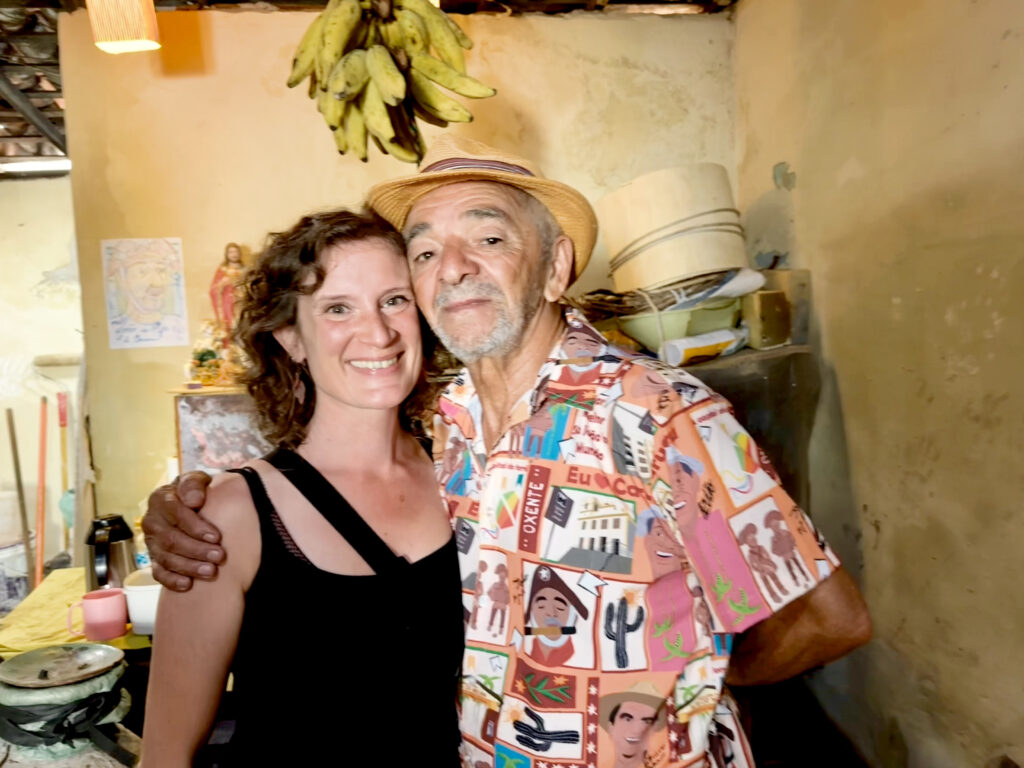
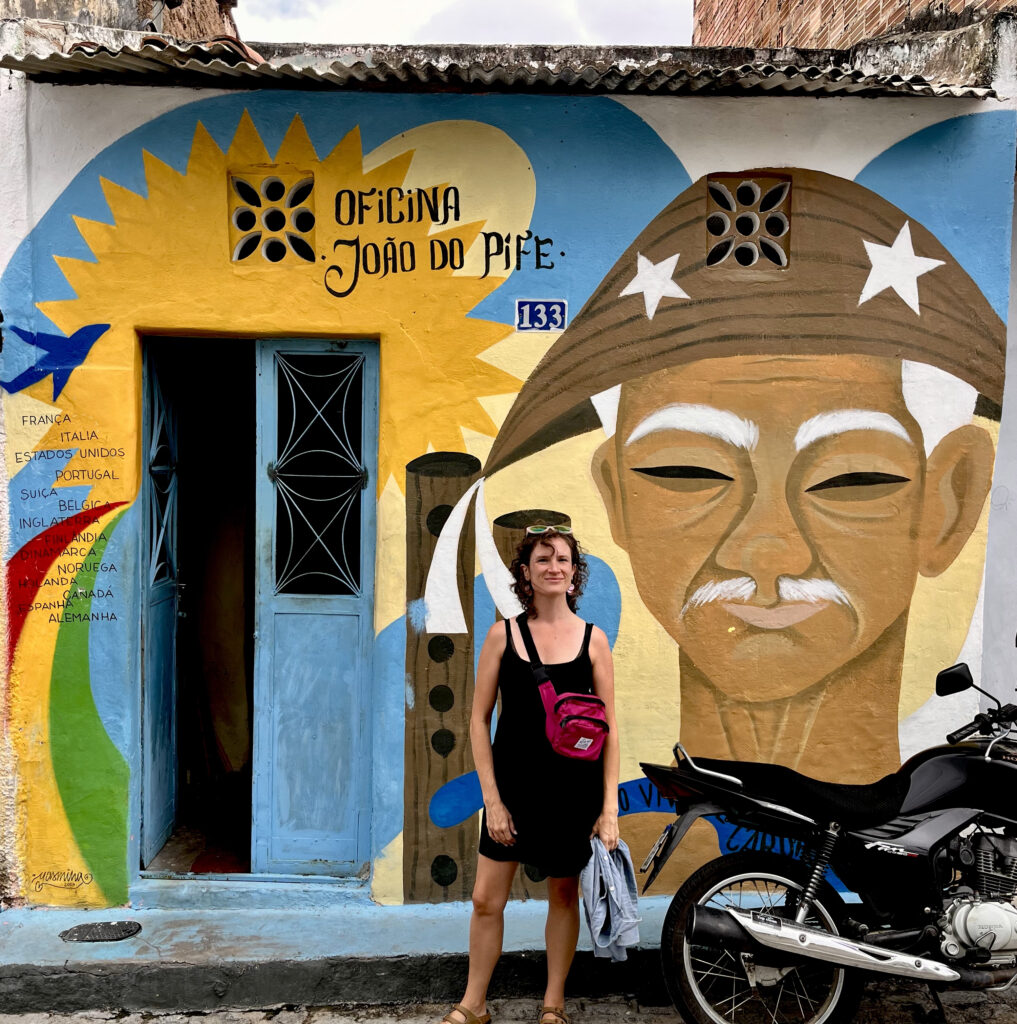
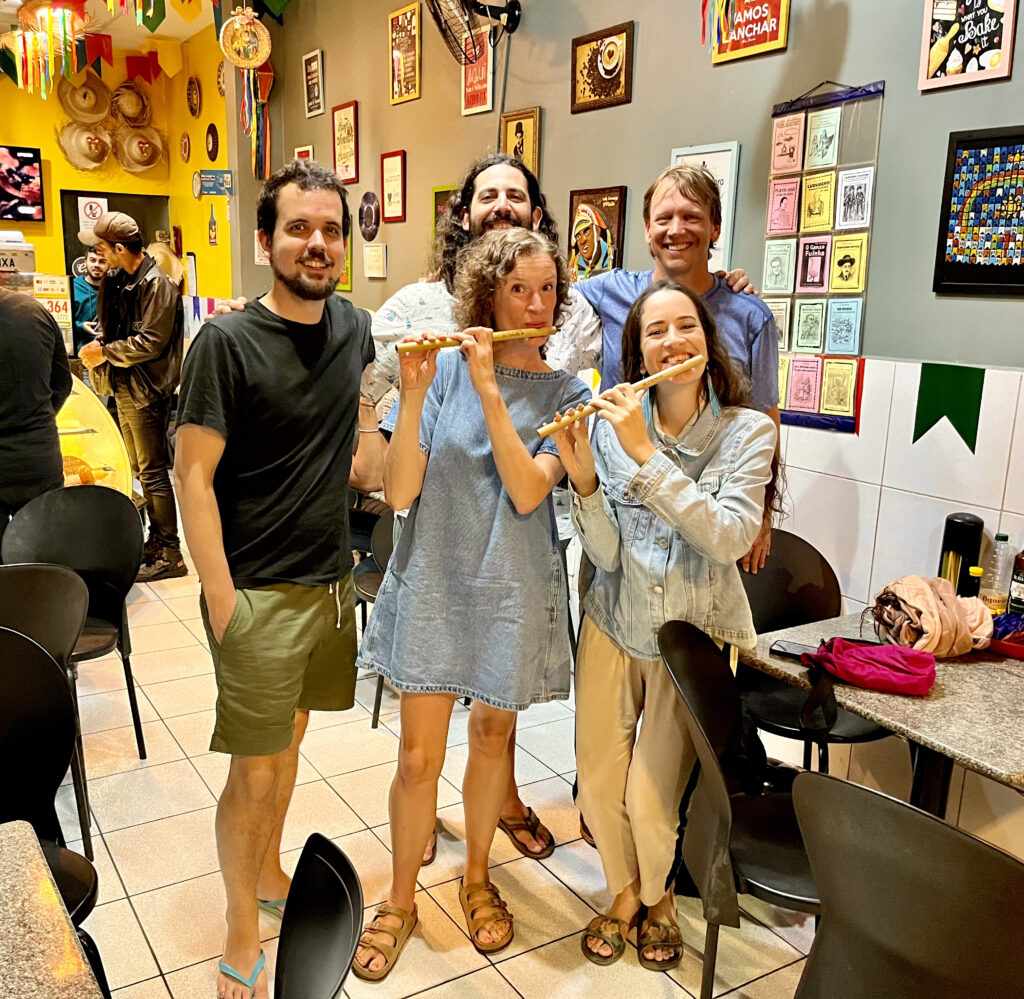
“Meeting and Playing with João do Pifano” – Entry by Natalie Smith
Stepping out of our car onto a cobblestone street in Caruaru, I first noticed the beautifully painted wall with a larger than life portrait announcing the “Oficina João do Pife.” Local legend pifano (Brazilian flute) maker João do Pifano came out to greet us, and he immediately welcomed our guide Herbert Lucena, a well-known musician himself, with warm hugs and smiles. I waited patiently for my turn to meet this master, but really I wanted to get right down to business: seeing João’s pifanos and hearing him play.
Inside was a room full of instruments handmade by João—many, many pifanos, but also many large drums that he skins and crafted himself. I loved seeing the instruments as well as the tools João uses to make them.
After some chit chat, João played for us. What a joy! It was evident right away that this music is in his blood. He said his father was also a pifano player and started the pifano band that João still leads today. I told him that I would like to purchase a pifano, and he immediately presented one to me. I played for a few seconds, finding my footing, then João picked up another pife (short for pifano) and began playing with me.
Magic! I tried my best to keep up with his intricate melodies, watching his fingers and feeling his rhythm. I wanted to take a pifano home immediately and get to work! It was such a joy to make music with this beautiful person. The next evening I would meet Vitoria do Pifano, João’ mentee and an all around wonderful person, who is carrying on this tradition of playing and making flutes in the Brazilian Nordeste. I’ll meet with her again next week to buy a pair of pifanos she is making for me. It’s an absolute honor to know and play with these brilliant musicians!

Update: Monday, June 10
“Day 3” – Entry by Philip Kohnen
Waking up to the sound of birds, rain, flute and guitar wasn’t getting old, but I was starting to get used to the cacophony. This was our first day to take it easy in the morning. Our typical breakfast had to wait for sleepy Bichos. After breakfast, we convened in the downstairs apartment for a long rehearsal. A tentative gig in Caruaru fell through, so we had the time and opportunity to rehearse for our larger gigs later in the week.
With a few solid hours of productive rehearsal under our belt, we concluded for the day and prepared for a Brazilian style Churrasco lunch. Rosa exceeded all of our expectations and made an absolute feast for our group. We learned about how Brazilians typically eat their biggest meal of the day at lunchtime since the sun sets around 5 p.m. most of the year.
Discussion of our day determined that we wanted to revisit the Borges Museum, as some of us missed the opportunity the previous day. As we pulled up to the small neighborhood in Bezerros, we saw a gentleman with a white cotton hat in a power scooter smiling for a photo. Then we saw a few more people ask for a photo. We soon realized that this was HIM, the artist Jorge Borges!
After photos and fun conversation, he invited us inside of the museum to tell us more about his work. We followed him around listening to him describe his life and how he came to create this style. We learned more about the Sertão, which is the desert region of the Nordeste (Northeast) of Brazil.
The people that live here have endured drought, endemic poverty, lack of infrastructure and political isolation from the South of Brazil for generations. Borges art depicts the dichotomy of existence in the Northeast; absolute beauty interrupted by drought and poverty. For this reason, many people in the Northeast have been forced to leave their home land to move to the south, bringing their music and culture with them. Without Luiz Gonzaga leaving the Nordeste, Bichos Vivos may have never come into existence. O efeito Borboleta.
Visiting with Jorge Borges was an absolute delight; his winding stories punctured by outbursts of laughter and intense hand gestures. Erica McCarthy, our beloved documentarian, bought a print of a Sanfoneiro (accordionist) and Borges was intent upon signing and dedicating the print to ME. Erica bought it as a gift and he personalized it for me. This was completely unexpected and very much appreciated. I was beaming as we said goodbye to Borges, having stayed more than 30 minutes past closing time.
The sun had set and most of us decided to get back to the Verde Valle home to prepare for our departure the next day. A small cohort broke off and drove back in to Caruaru to meet Vittoria do Pifano, as Natalie Smith described in her previous entry. She was a delightful person who shared her story with us, describing her ascension as the only female Pifano maker, an acolyte of João do Pifano. We said goodbye to Vittoria and to Caruaru, heading back to Verde Valle for a movie night with Robert Moser, our Lead Singer. We watched a movie called “Bacurau,” which was set in the Brazilian Northeast and follows the tradition of Cinema Novo. (Cinema Novo was a revolutionary Brazilian film movement in the 1960s and 1970s that challenged traditional cinema by focusing on social equality and intellectualism, inspired by Italian neorealism and the French New Wave.)
The next morning would bring unfortunate news…
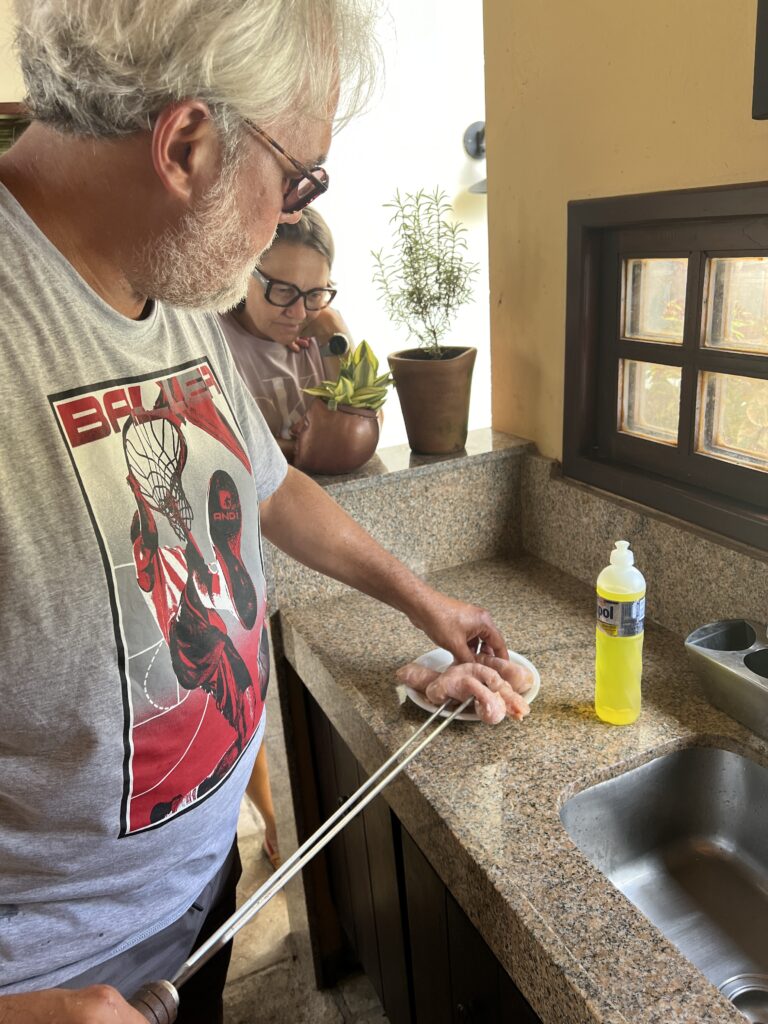

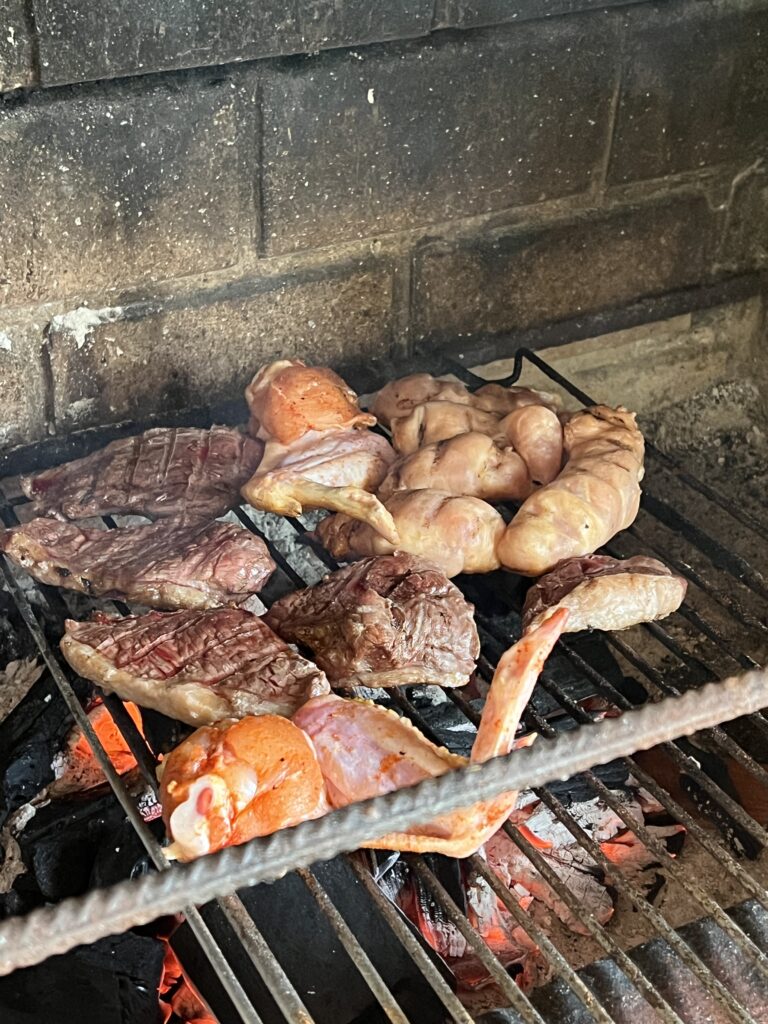


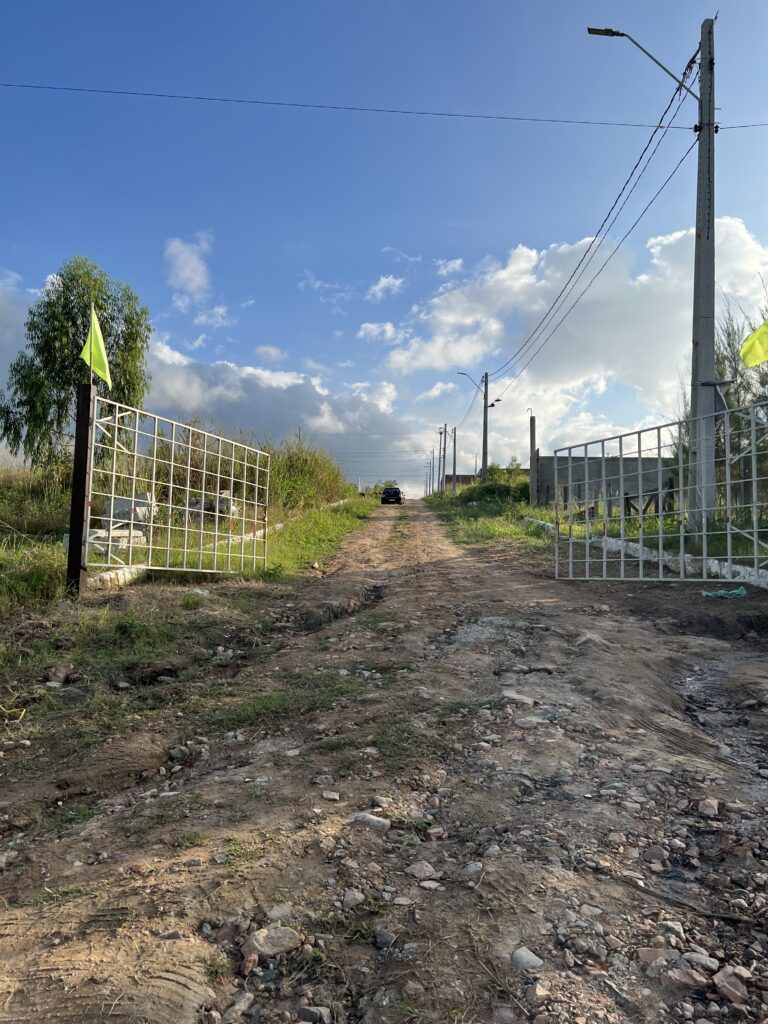

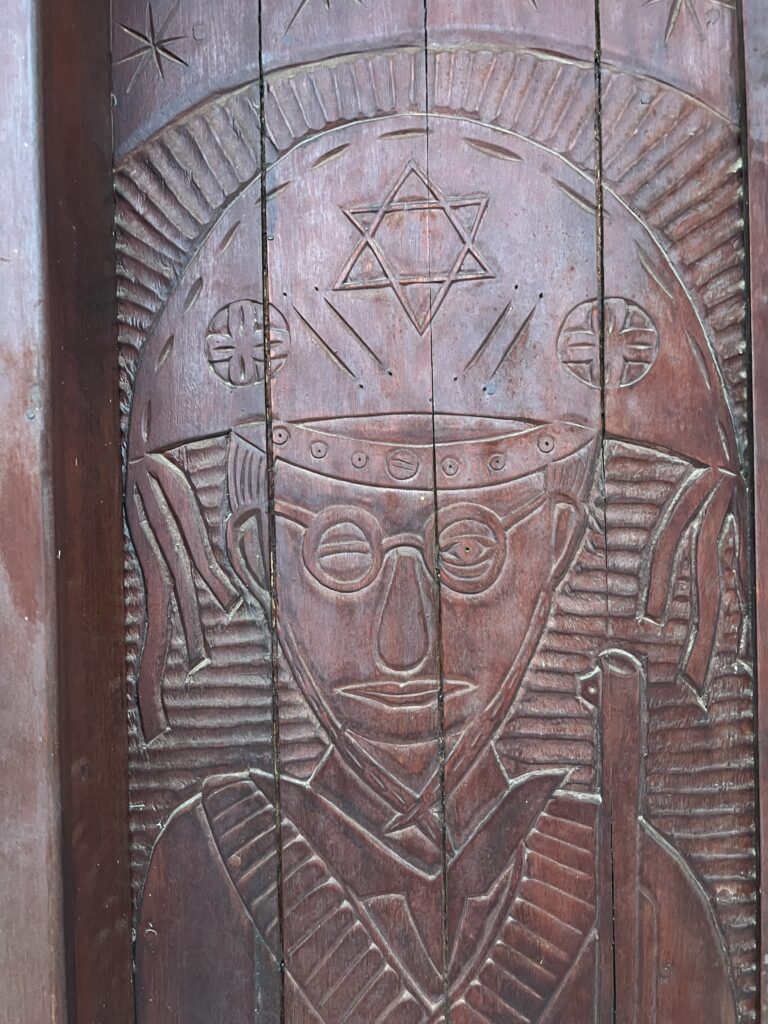
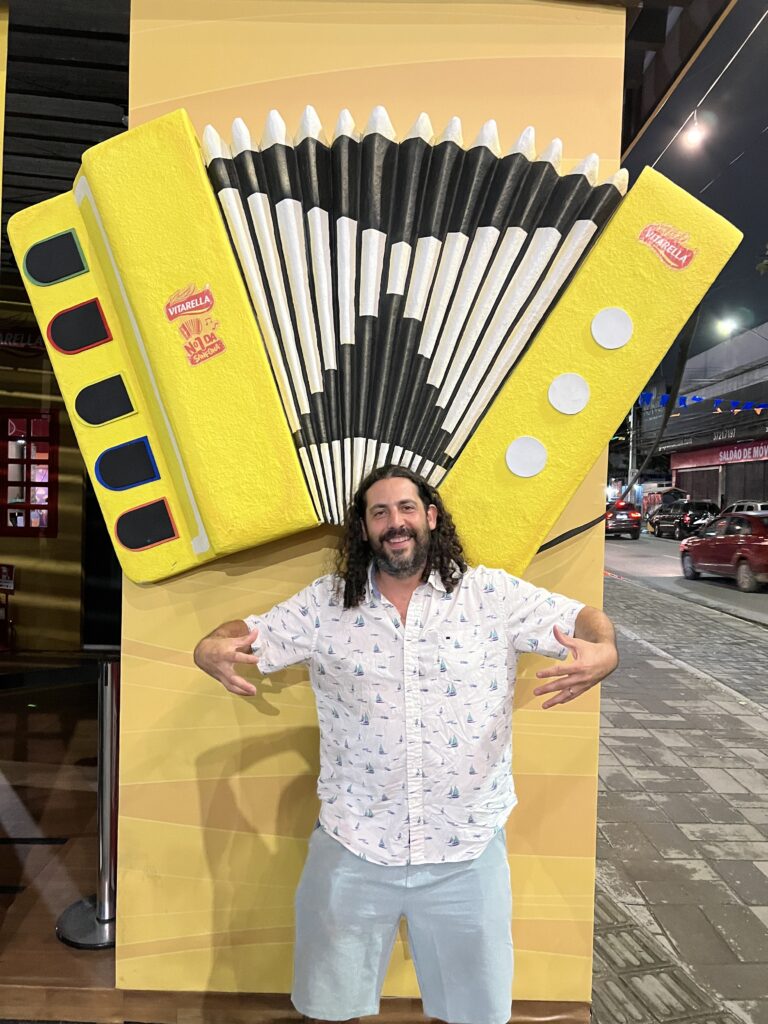
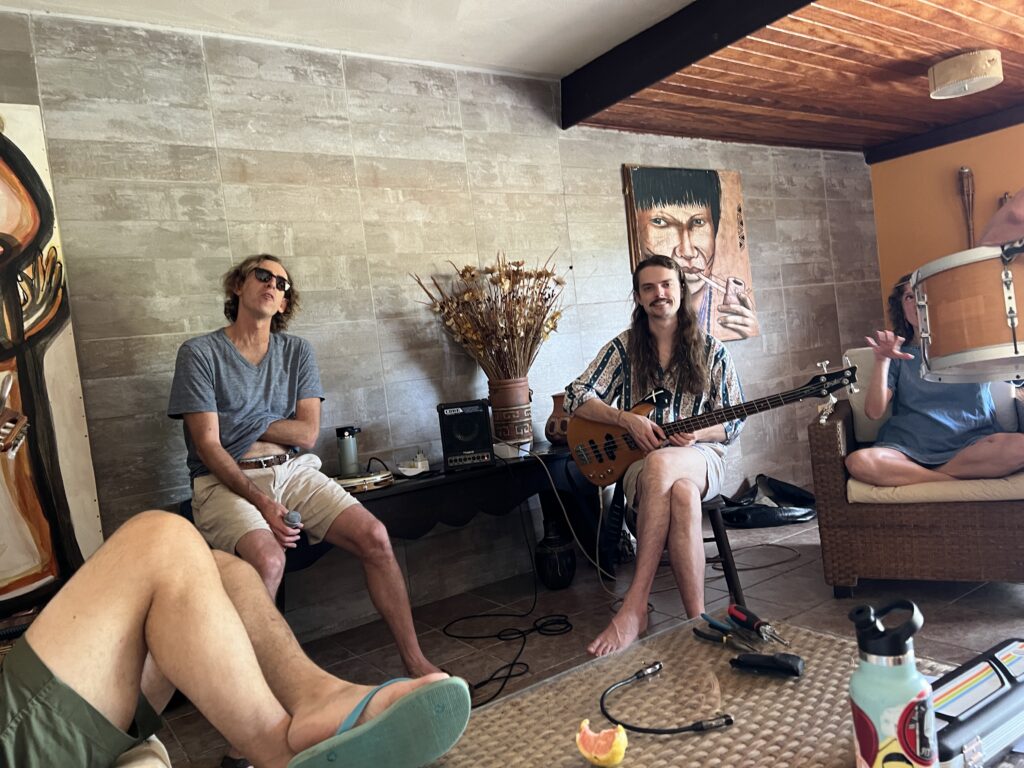


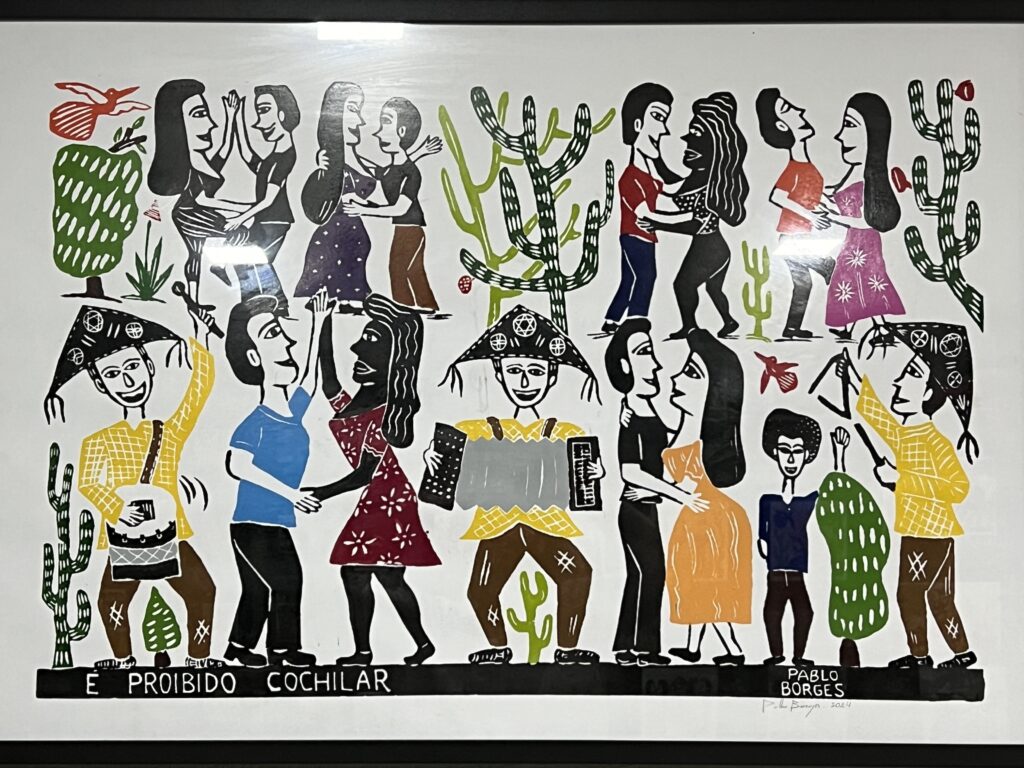

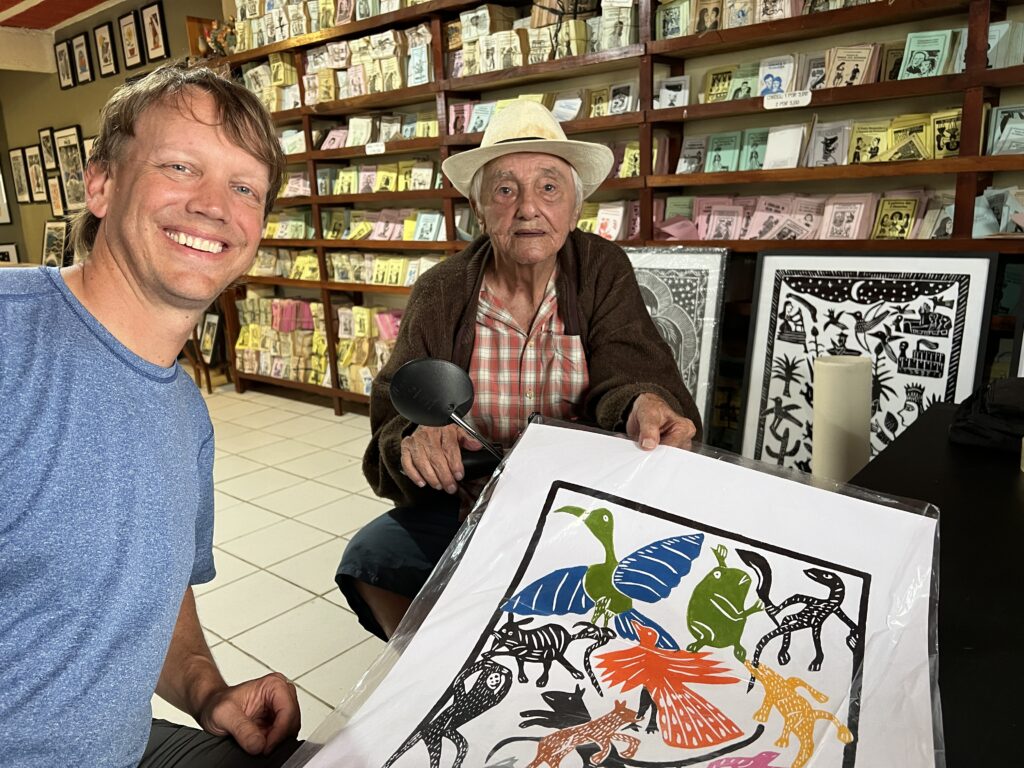
Update: Tuesday, June 11
“Day 4” – Entry by Philip Kohnen
The clouds were darker than usual when we awoke, quickly dropping their contents on the valley below. Bright sunshine peeked through, rapidly spreading and reconquering the blue sky from the grey clouds.
A band meeting was organized before breakfast. Our beloved lead singer, Robert Moser, was experiencing health issues and would not be able to continue on the trip with us. Our time in Caruaru for São João was extremely special, and we were grateful to have that time with him in Brazil. After breakfast, we hugged and kissed Robert, thanking him for helping to organize the trip and bidding him safe travels.
Soon after his departure, our bags were packed for the IRL Tetris game that Lucas and Todd played. Each time we packed the cars we had more stuff procured at markets and shops in Caruaru. Just like Tetris, it gets harder each time you level up.
The rest of the day was comprised of travel from Gravatá to João Pessoa. We stopped in Recife to upgrade the rental cars, knowing that we had lots of driving ahead. We finally made it to our house in João Pessoa, exhausted from a full day of travel.
As soon as we arrived, we unloaded the cars and immediately left to meet our tour manager, PC, for dinner and a meeting. This was the first time that most of had the opportunity to meet PC, so we did the classic Brazilian introduction of hugs and warm greetings. We discussed how we would be moving forward with our set given that our lead singer was not going be performing with us. Over the next few days, a plan would emerge.
Reading up on history before bed, I learned that the city was renamed “João Pessoa” in 1930 in honor of the state president João Pessoa Cavalcanti de Albuquerque, who was assassinated that year. His death was a significant event that contributed to the Brazilian Revolution of 1930, which led to Getúlio Vargas becoming the president of Brazil.
In English, “João Pessoa” literally means “John Person,” which became an ongoing joke in the band. We all said good night and settled in to our first night in João Pessoa, a large city on the coast of Northeastern Brazil. The bustling cityscape contrasted the rolling hills of Gravatá, promising many new experiences with music, food and people.
Update: Wednesday, June 12
“Day 5” – Entry by Philip Kohnen
Alongside the birdsongs and pattering rain, we woke up to a bustling city filled with cars, buses, motorcycles and people. Our first gig would happen later that night, so we agreed that we would be spending a majority of the day rehearsing and getting our set tight. But first, we had to go to the beach. Rehearsal could wait.
Since we had to call an audible on our original set, we started working out which of us would sing certain songs. My vocal range fit “Don’t Think Twice” by Bob Dylan and “Morena Tropicana” by Alceu Valenca. Nic Wiles and Natalie Smith would sing “Jackson” by Johnny Cash. Tony Oscar and Todd Mueller would be singing backup on many of the songs. Lucas Tavares and William Freeman Leverett would sing everything else. We had 32 songs ready, so we felt confident and prepared. More than anything, we missed Robert Moser and Keiko Ishibashi (violin), our missing band members.
After a long rehearsal and lunch, we starting packing up the instruments to head to the venue, a small club near the Universidade Federal da Paraiba called Recanto Da Cevada. Entering the venue was magical, traversing out of João Pessoa and into a tropical wonderland. Flowers hung from the trees above, with moonlight peeking through and shining onto our table. The first band started playing and we were blown away by their performance. This would happen frequently as the trip progressed.
After the second band concluded their set, there was an announcement made in Portuguese that said “Our next band comes all the way from the United States, and they are playing Forro!” The audience was equally confused and amused. We set up our equipment quickly, thankfully using some of the instruments from the other band. Natan Nunes was so graceful to let me use his accordion, an amazing Scandelli. Natan (IG @natannunes.sanfoneiro) quickly became a friend that I would see many times over the next few days at each of our gigs.
After a lightning fast sound check they gave us the green light. We all looked around at each other in disbelief. Here we were, in Brazil, onstage in front of a massive crowd watching with palpable anticipation. We were ready, so we started our first song. The crowd did not know what to think of these gringos playing their “country” music. It took a few songs before we truly won them over. The dance floor was moving again and we saw smiling faces. When we started “Take On Me” by AHA, the crowd became wildly excited, phones blazing to record this crazy band of Americans. We played a short set, and they demanded an encore. “Mais Um! Mais Um! Mais Um!”
We concluded and thanked everyone for their kindness. As we were breaking down, someone said “Did that just happen?” It turns out that phrase would be used many times over the next few days. We hung out with the other musicians outside of the club when it closed down, sitting on a grassy hill sharing beers and laughs. Finally, we headed home. Good night, John Person.
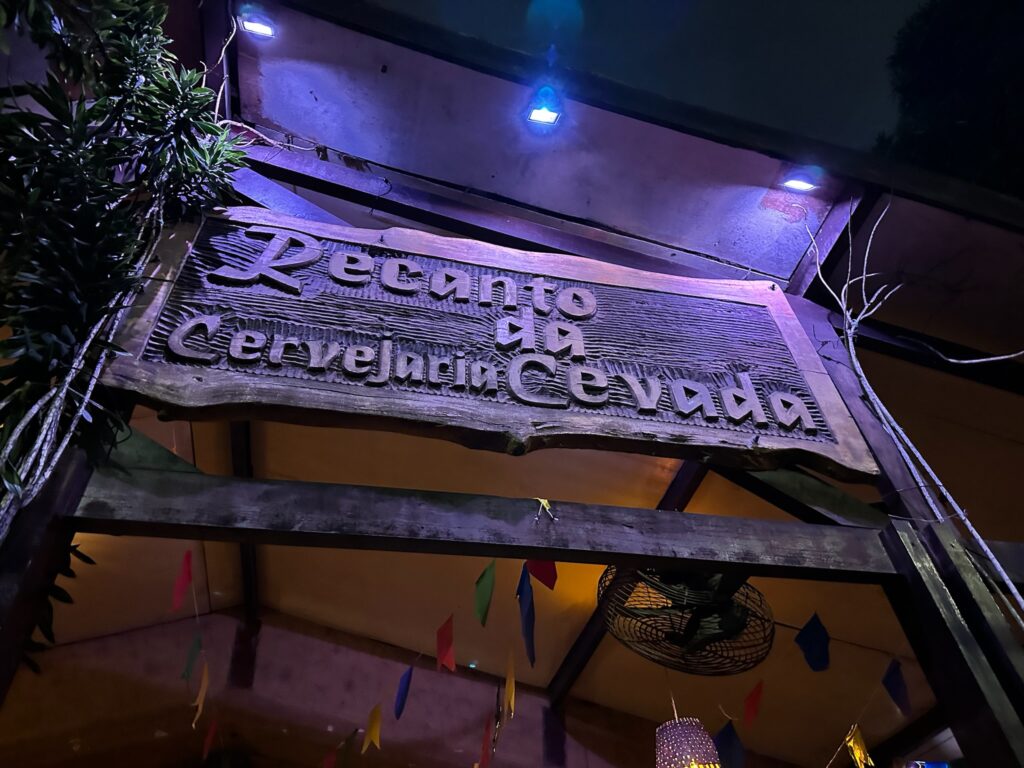
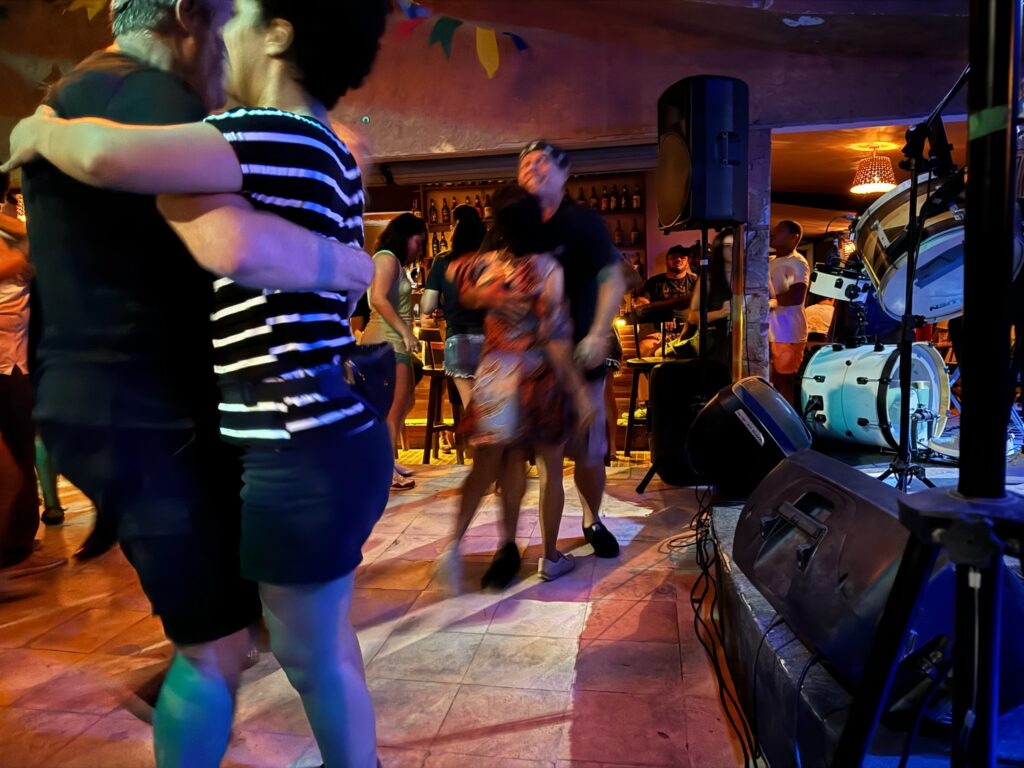
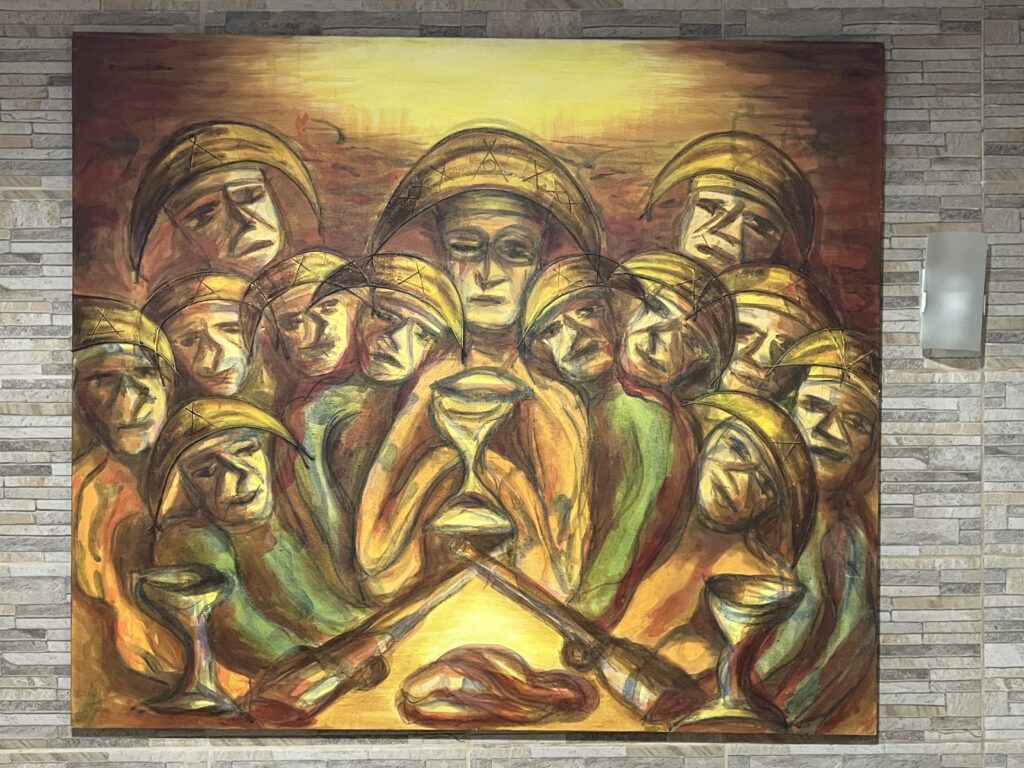
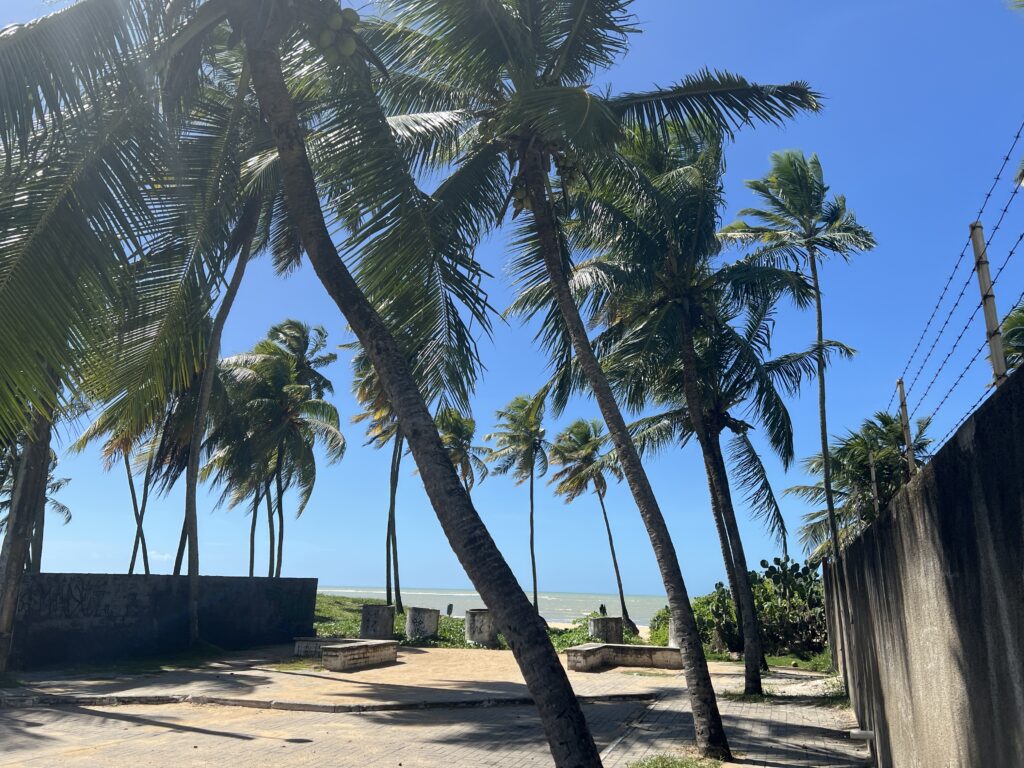

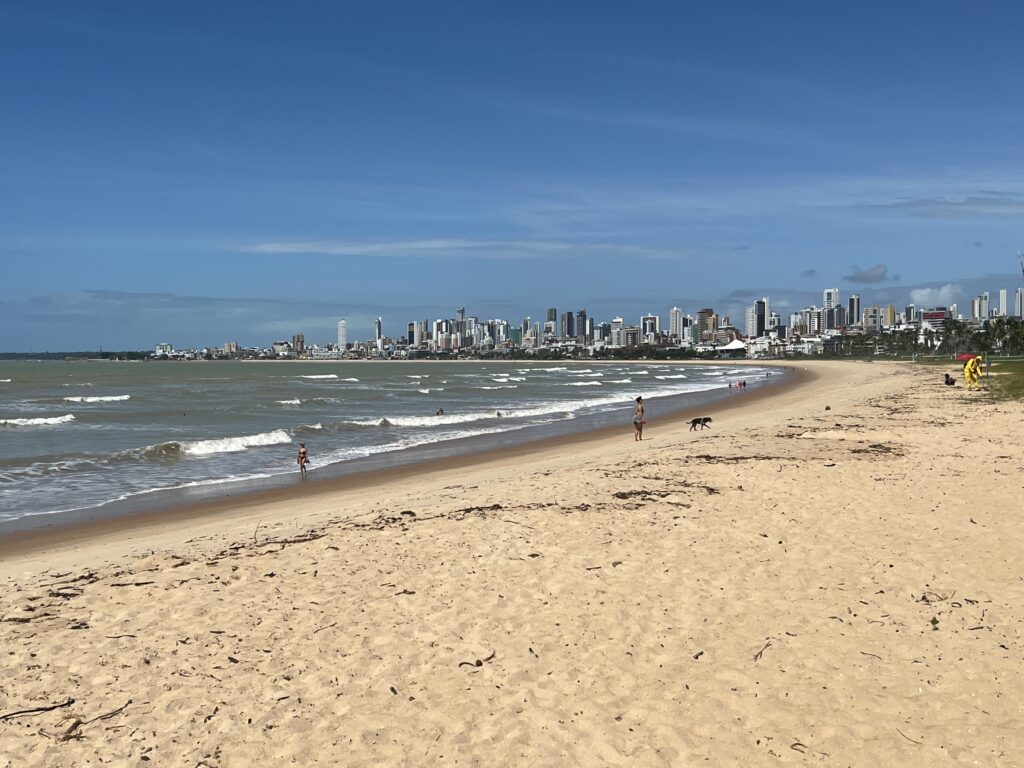

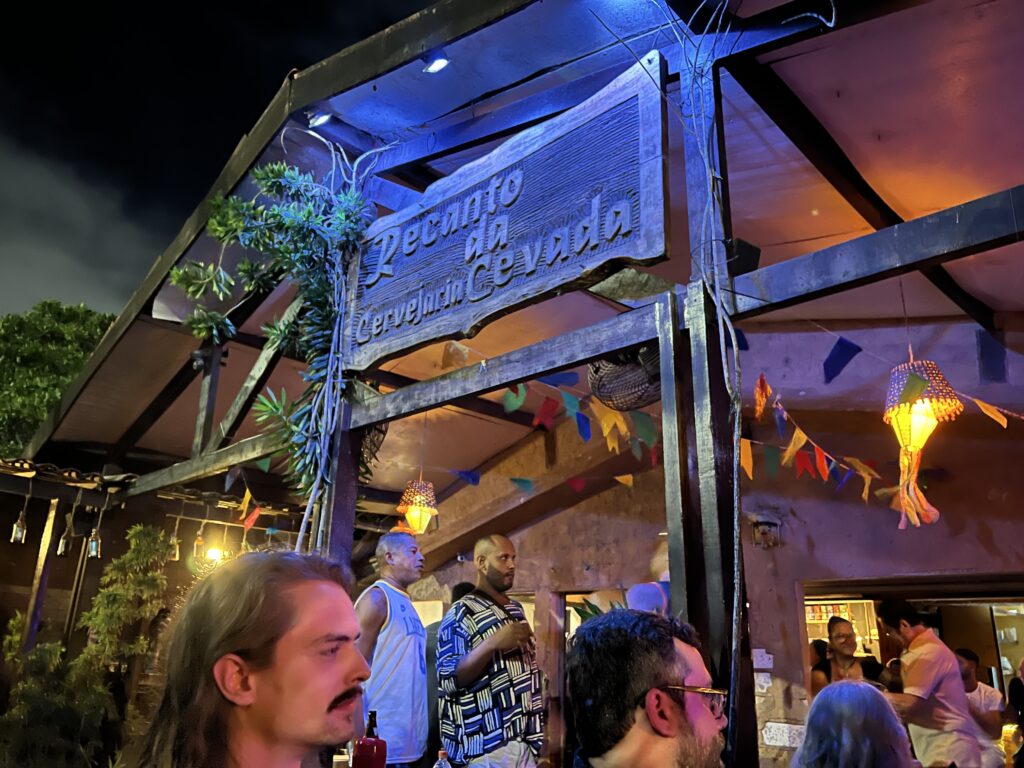



Update: Tuesday, June 18
“Day 6” – Entry by Philip Kohnen
Still in disbelief from the previous night, we slowly coalesced at the table outside, sharing hot coffee that Erica and Natalie had brewed. More rehearsal was scheduled, as we had a gig later that night. After running through our set, seeking cracks in the facade, we packed the instruments and headed to our interview at Radio Tabajera 105.5 FM.
We arrived at the station, the security door slowly creaking open, revealing Tony Leon’s smiling face. He guided us to a small waiting room with a red light above that said “On Air” in Portuguese. We talked with Tony Leon, learning about his life in the entertainment and radio industry in João Pessoa. He asked if he could play the guitar we had while we waited, revealing a truly talented style of playing and singing both Brazilian and American music. The red light turned off, and a group of people shuffled out of the studio, saying hello in the warm Brazilian manner we had all adopted. Hugs, handshakes and kisses were all on the menu.
It was finally our time to go in, meeting the interviewer and producer of the show. They thanked us for coming, and reviewed our story with us again, making sure they knew all of our names. The interview was conducted solely in Portuguese, so band members Lucas and Tony were doing the heavy lifting while we all listened intently, trying to understand the conversation that was seemingly accelerating. Tony and Lucas introduced the band members, then we were prompted to pick up our instruments for an on air performance. The interview concluded a few minutes later as the “On Air” light faded. “Did that just happen?”
Our gig for the night was close to the radio station, so it was easy to make it to the venue early for our next interview. Bright lights, fancy cameras, big microphones and 20 questions. Natalie, Tony and Lucas did an excellent job in the spotlight. Natalie was interviewed in English, which was a first for the group. We wondered if the interview would really be aired on TV? Days later, Roberto Férias Leite (our knight in shining armor) would send us the link to the interview.
After sound check and a quick bite, we noticed more and more people shuffling in to the venue. We watched as Natan’s band set up and sound checked. These guys were the real thing, and Natan’s virtuosity inspired me to work harder at my instrument. It was our turn to take the stage. Shuffling up and taking our spots, we all looked at each. “Everybody ready?” Natalie scanned the stage with her lips to the flute, poised to begin as soon as everyone gave the affirmative.
“Did that just happen?” We asked ourselves this ever familiar question as we shuffled off the stage. The audience was receptive, couples bouncing in time with the music, singing along. We had the pleasure of inviting a guest singer, the owner of the establishment, onto the stage to sing a few songs. She was an amazing singer, her presence and command of the microphone was obvious, and her voice was magical. This was a highlight for all of us, recognizing the power of a song to bring people together that have never met before tonight.
Still reeling from the experience and enjoying conversation with new friends, we recognized that the establishment was closing and that we would need to go somewhere else. Some of our crew chose to back to the house to rest, while some of us followed some of the new friends to another show in a historic district. Finding the venue was quite difficult, because it was essentially hidden. Deep inside the historic district, a small gate was guarded by security, with illumination and the sound of a crowd on the other side. After a short discussion, we were granted access.
Walking through the gate transported us into a surreal environment that didn’t look that far off from a night in Athens. We had clearly stumbled upon the hip after-hours club in João Pessoa, and we were about to see one of the best bands we would hear during the entire trip. On Zabumba was Thiago Melo, an extremely talented musician whom we would see perform many times in the coming days. On Sanfona was Helinho Medeiros, an amazing talent and kind person. I was intimidated to speak with him after witnessing one of the most technically impressive performances that rivaled Natan’s virtuosity. Talking with Helinho, leaning in closer to decipher his lighting fast Portuguese over the sound of tattoo guns whirring along, he explained that he needed to head home so we said goodbye and see you soon.
Finally exiting through the small gate leading back into the quiet historic district, we marveled at the view from the top of the hill near where we parked. This was an amazing experience that would draw us in further to the rich culture of Brazil’s northeast, proving to us that this music was alive and thriving. The clock struck 3 a.m. as we finally made our way back to our house, exhausted but still in disbelief from the myriad experiences throughout the day.
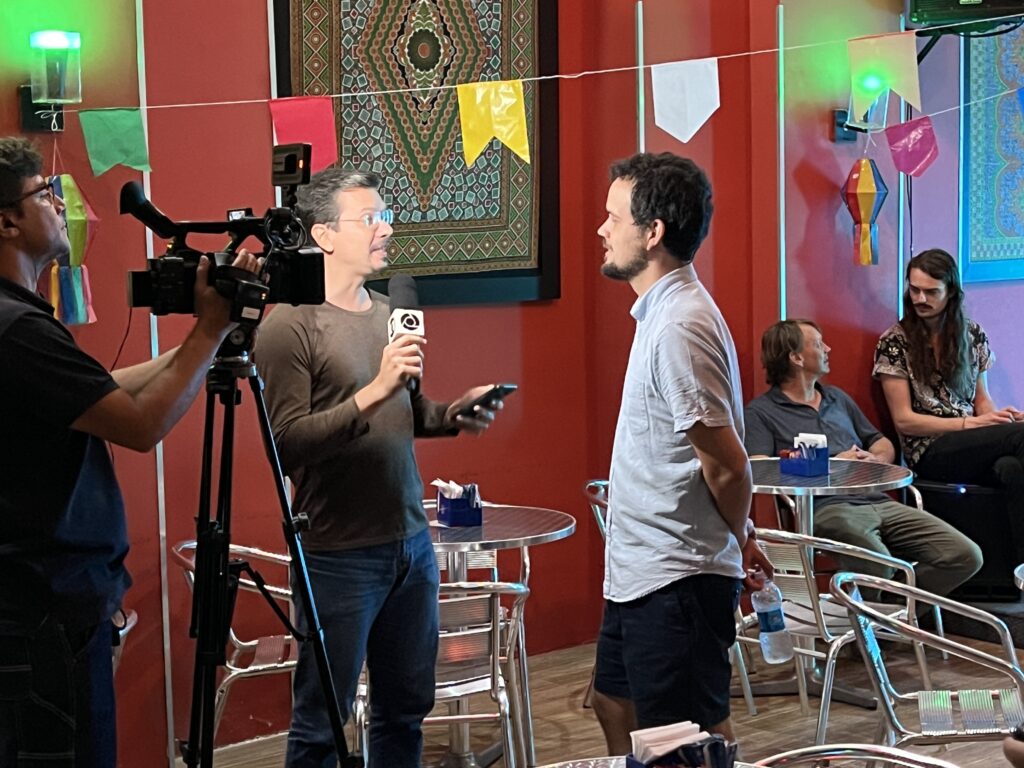

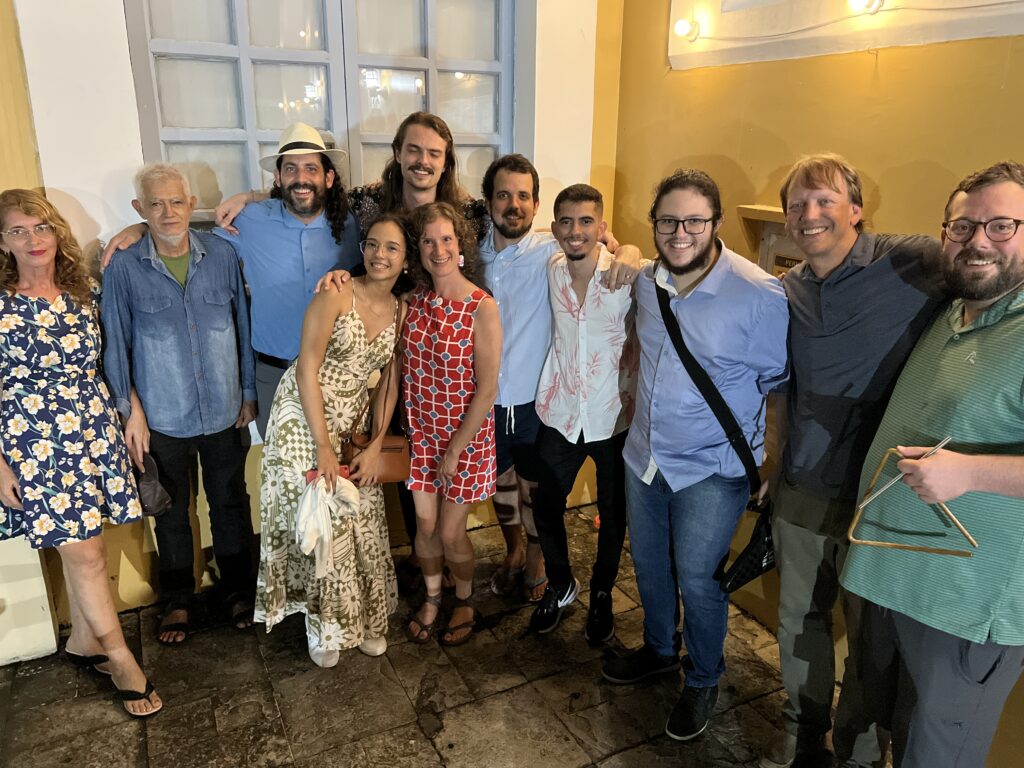
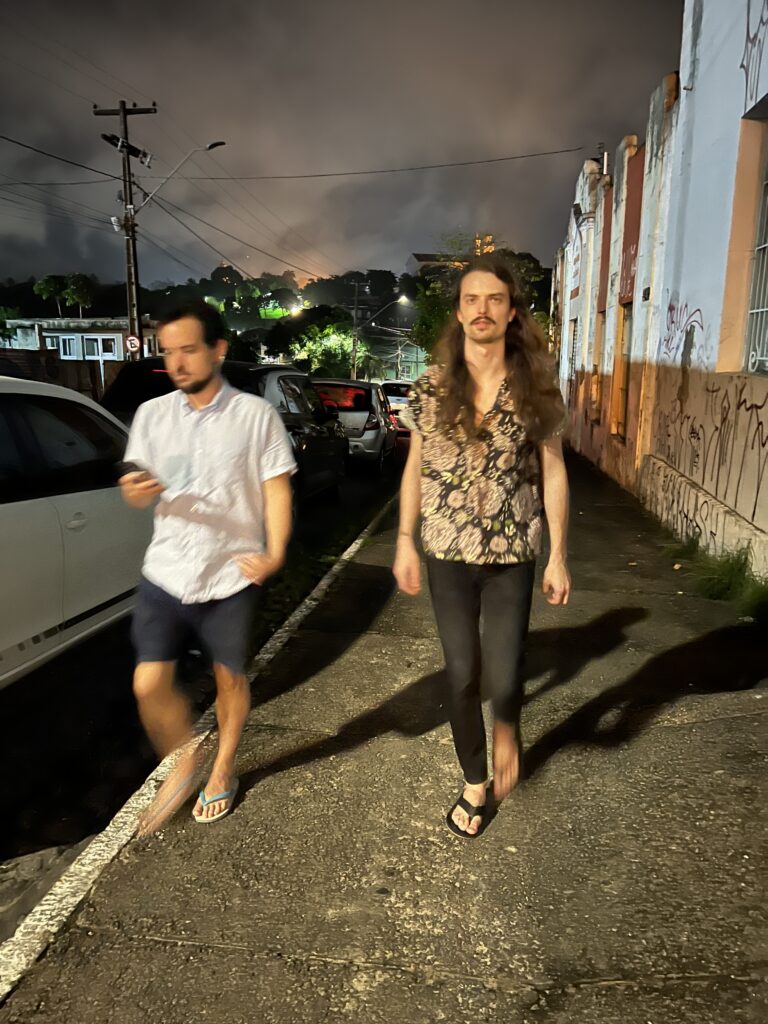
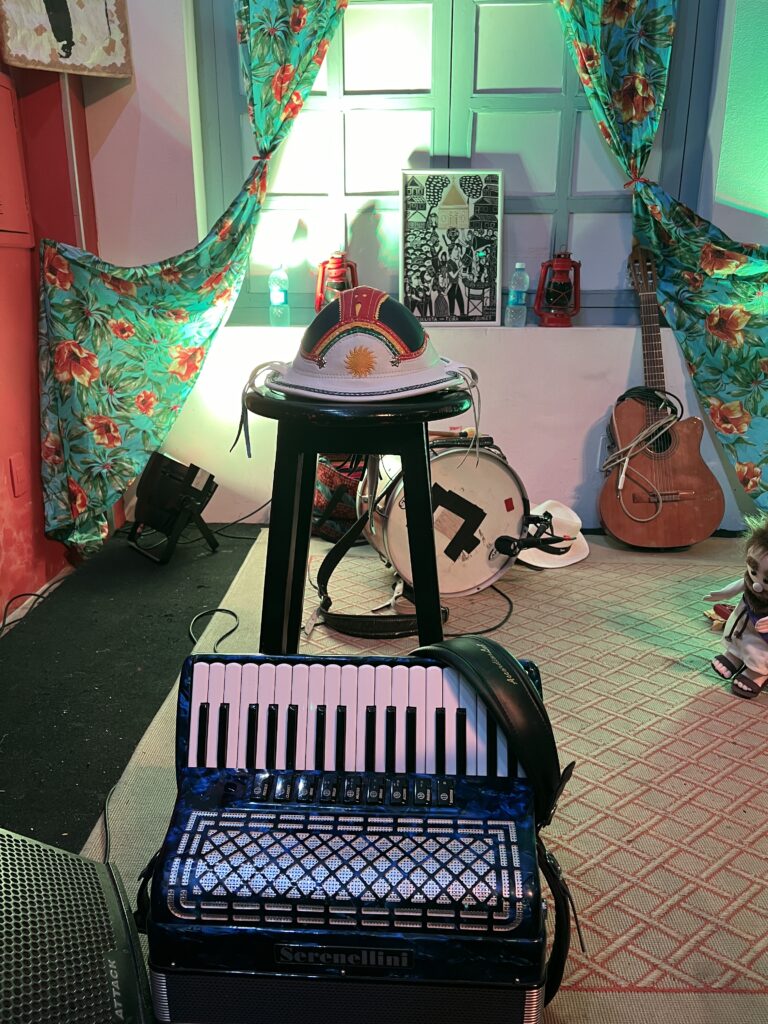



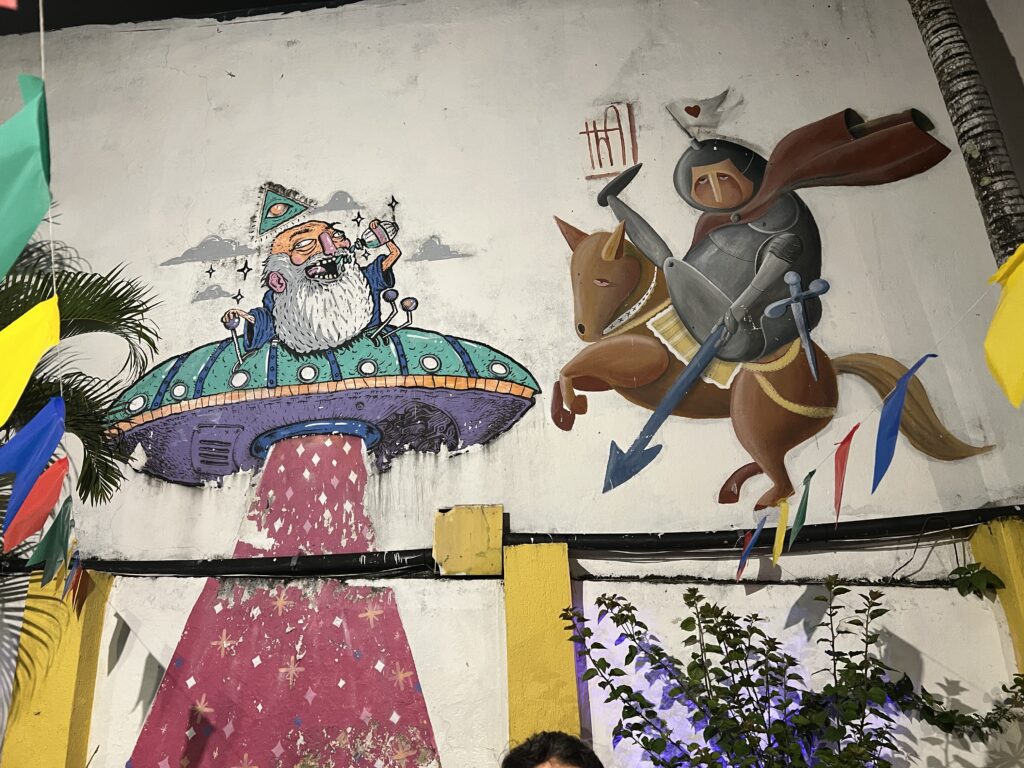
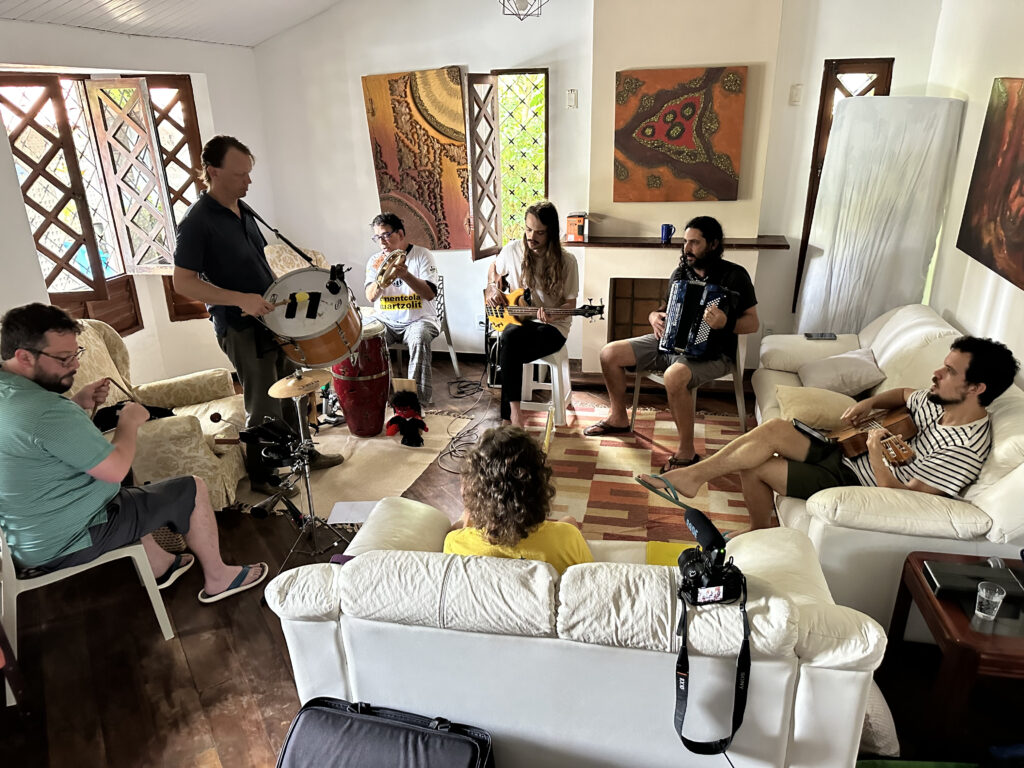
Update: Wednesday, June 19
“Day 7” – Entry by Philip Kohnen
Sleepy Bichos this morning. Some of our crew were habitual Dawnwalkers, others Noonwalkers. Every once in a while we would say “Boa Tarde” to someone who had just woken up. Day 7 was one of those days.
Rehearse, break for food and beach, and rehearse again. This was the way, because we had another opportunity later that evening to sit in with a show at Bessa Grill, a well-known restaurant and music hall in the Bessa neighborhood of João Pessoa. We would be joining in somewhere during a break for Diana Miranda, the Headlining act for the night, who also happened to be Paulinho’s sister.
Our host was Paulinho DiTarso, lyricist and co-author of our song “Que Verde É Esse.” Diana’s set was magical; couples dancing and fans singing every word. She moved around the hall, holding people’s hands and gaze. For one song, she even passed the microphone to a very talented singer, whom I presumed she knew, and continued schmoozing around the room. She called a break for her talented backing band, and announced in Portuguese something along the lines of “All the way from the United States, here’s a group of gringos here to learn from the birthplace of Forro!”
Bichos Vivos and Paulhino DiTarso opened the set with our version of Peter Gabriel’s “Mercy Street,” Paulinho’s strong voice and airy classical guitar leading the way. The dance floor still had a few folks left from Diana Miranda’s first set, but soon there would be many more people dancing and marveling at the gringos that nearly imitated their music, in an uncanny valley sort of way.
Diana Miranda’s second set was intricate and varied, showcasing her talent. Eventually, a conga line formed, and many of us joined in, naturally. The conga line made it’s way up to the stage, and a large group of dancers were boogying, including Natalie! Soon after, we had to say goodbye to Paulinho and Diana because we were planning to meet friends at “Manga Rosa,” which translates to Pink Mango. Amongst those friends was the father of Daniel Pina, who quickly became a friend to our whole group with his charm and charisma.
Daniel Pina and Maria Kamila were absolutely instrumental in the organization of this trip. Along with Roberto Farias Leite, our welcome in Brazil was unparalleled and seemingly unbelievable at times. The amount of contacts, press, gigs, management and general help from Daniel and Maria’s friends was humbling. Roberto Farias Leite and his wife Ana Farais were our North Star during our first night, checking in to the house for us and gathering necessary details for our days to come. They need to be thanked, over and over again. Daniel Pina and Maria Camila also need to be thanked, over and over again.
OK, back to the Manga Rosa before we conclude for the night. Helinho Medeiros, the Sanfona wizard described in the last post, was playing songs by Zé Ramalho with Elon, an excellent singer and artist in João Pessoa. We enjoyed their music while getting to know Daniel’s father. Eventually, the night was wrapping up so we bid farewell to our new friends, thanked the band and Helinho for their music, and started the short trek back home. Tomorrow was a new day, to be filled with rehearsal and performance. So it goes.
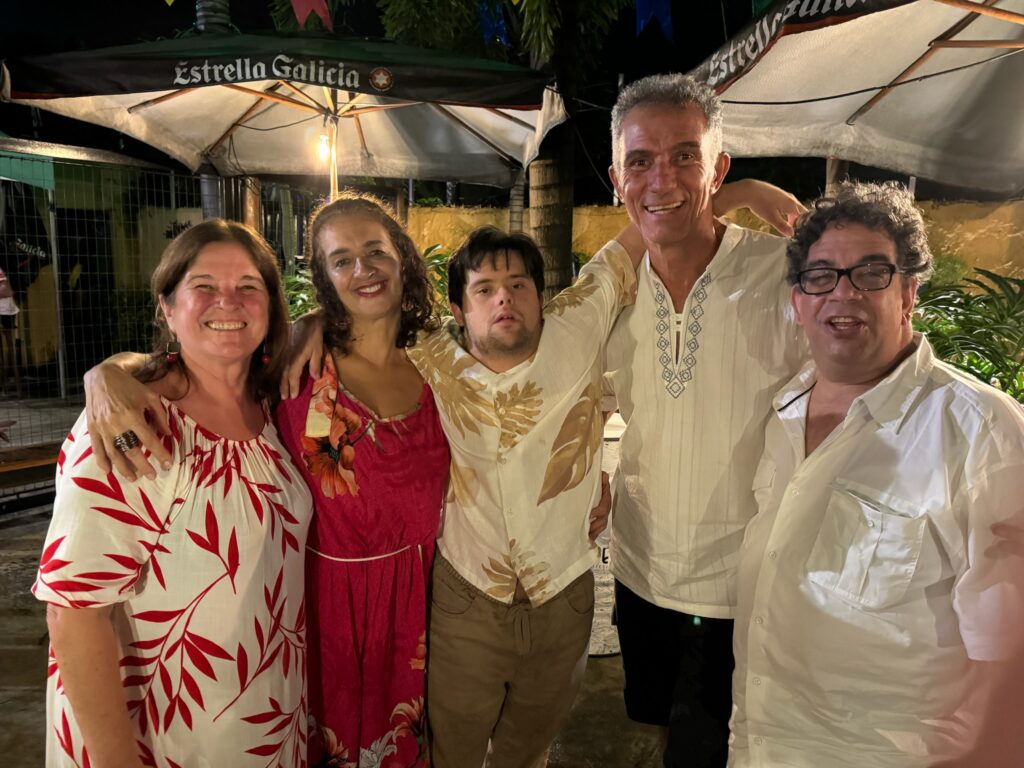
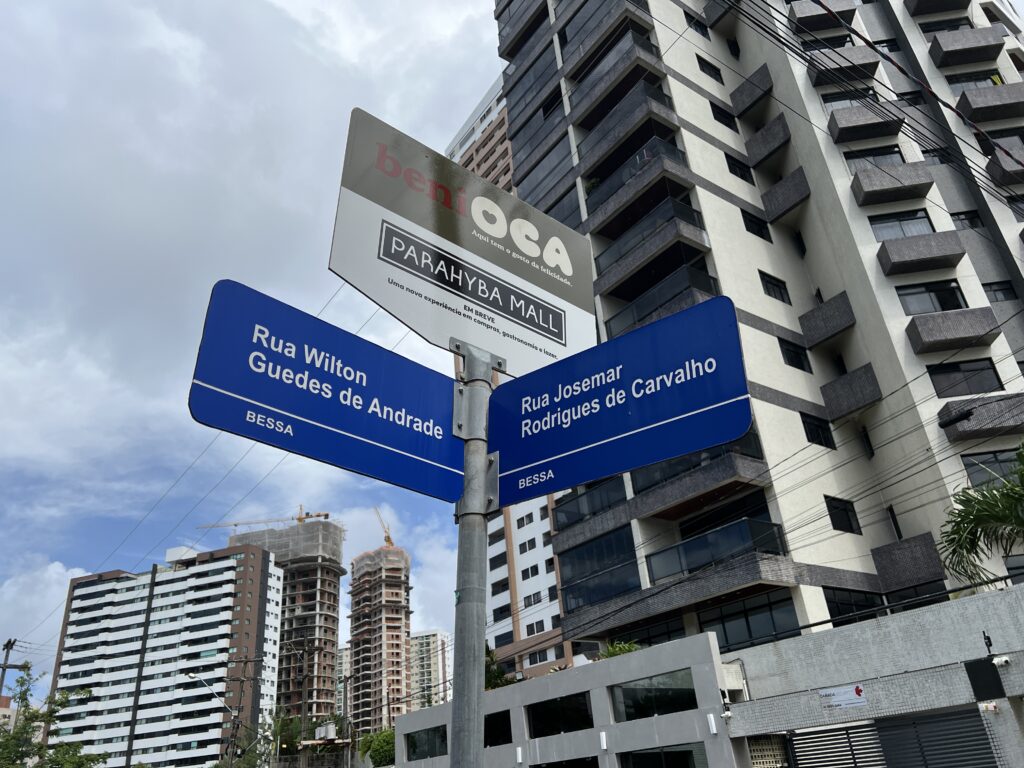



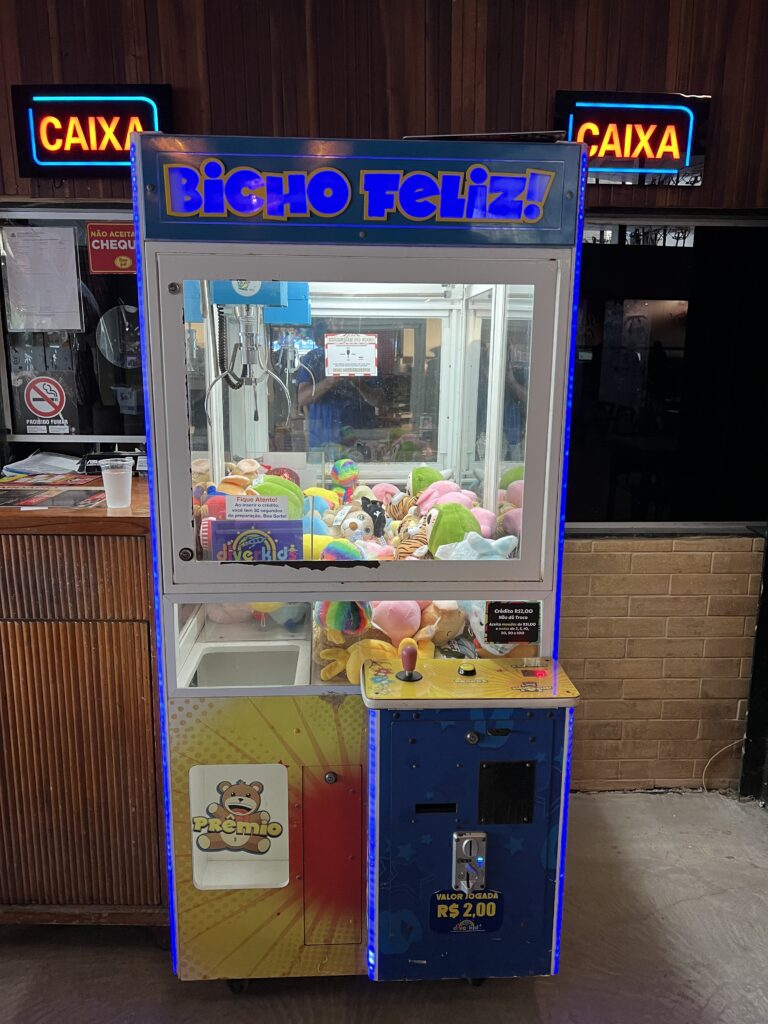
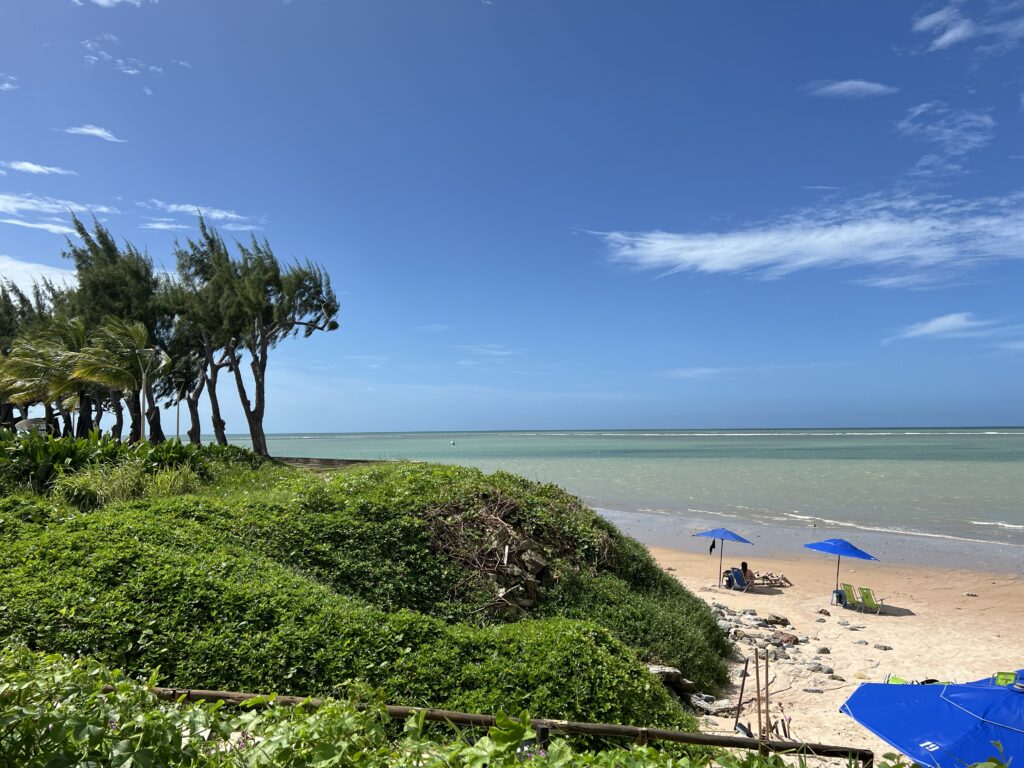
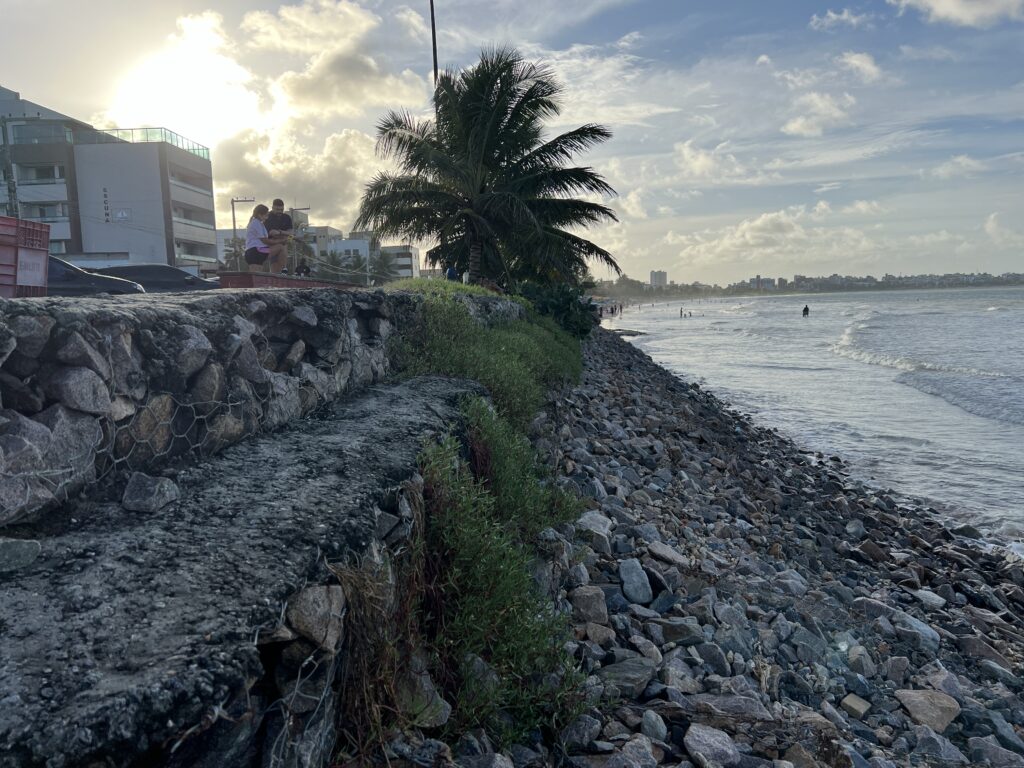
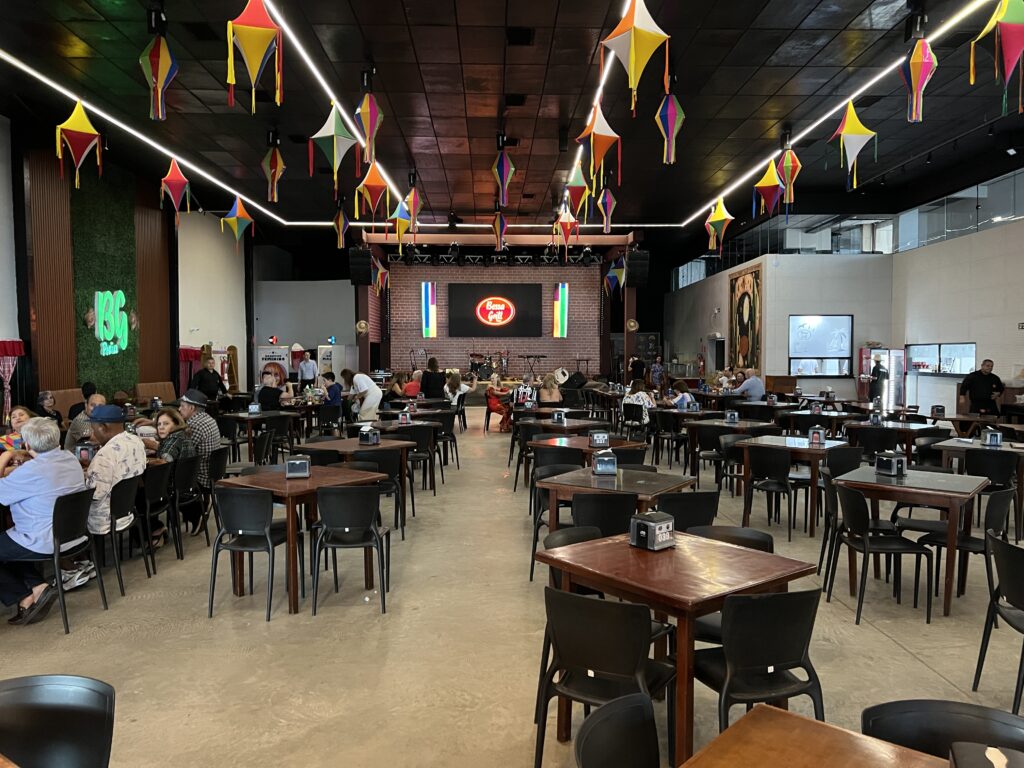
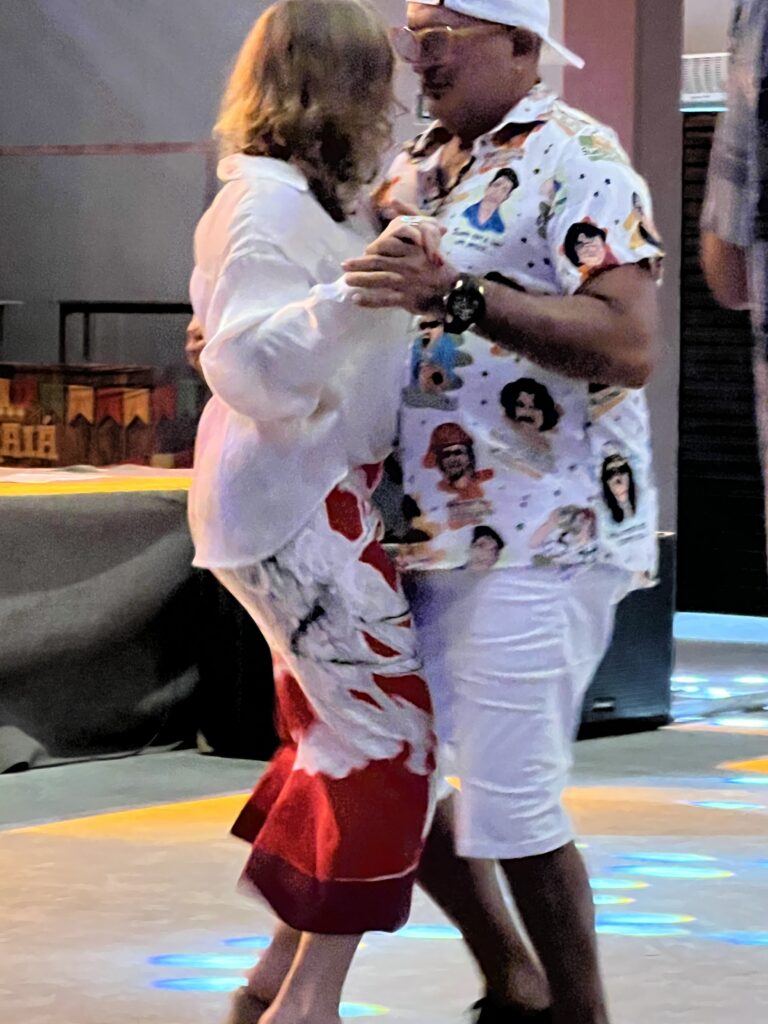

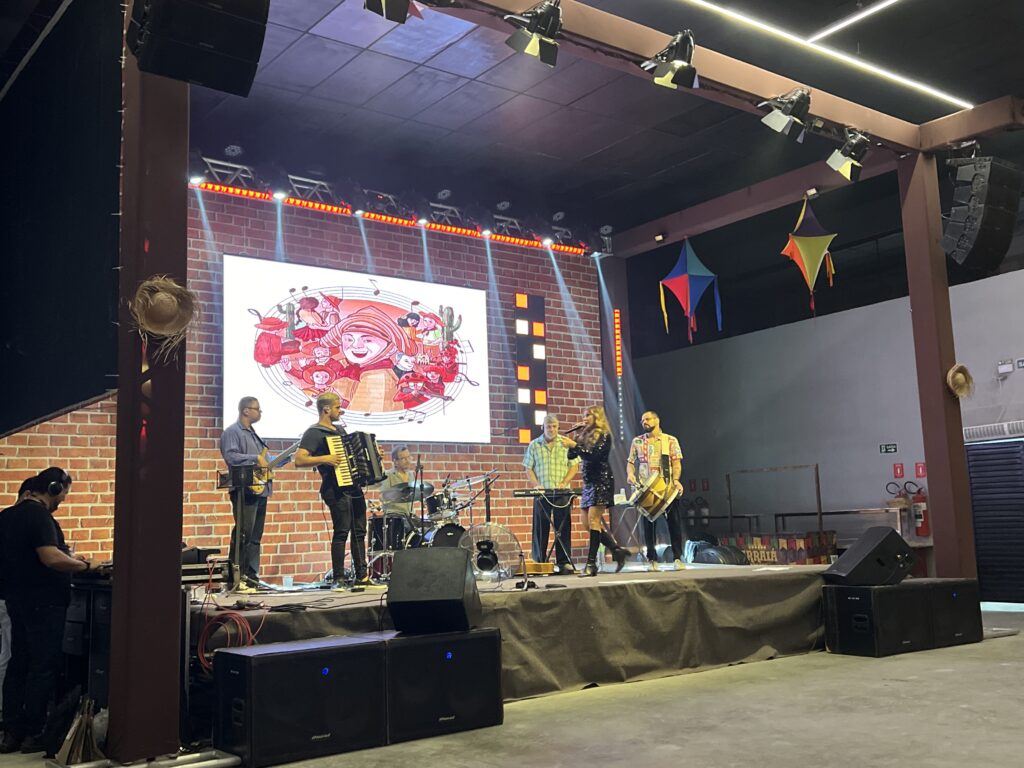
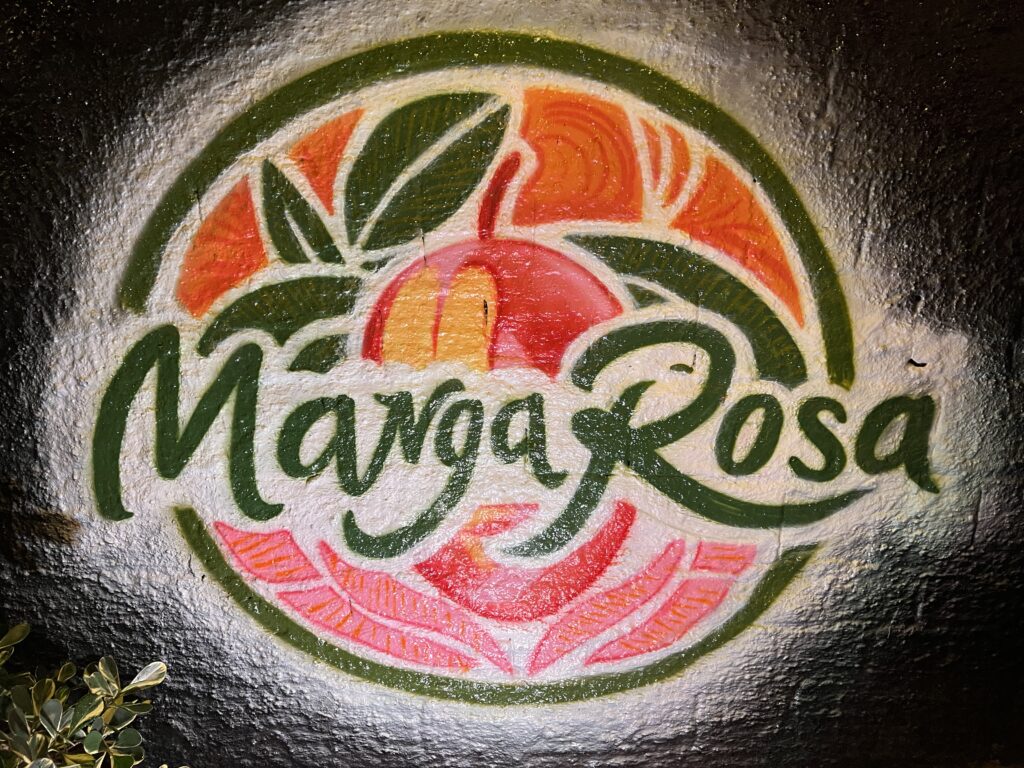


Update: Thursday, June 20
“Day 8” – Entry by Philip Kohnen
We finally had a day to chill and explore João Pessoa. We didn’t have a gig today, but we had to prepare for our “gauntlet,” which would be a show in Serra Da Raiz starting at 11 p.m., and then an all-night drive to Olinda where we would have about two hours to sleep before our 8 a.m. morning show at Marista School.
We had lunch at the same buffet we had found a few days prior, where everyone could get something they enjoyed. Afterwards, we rehearsed again, this time running our entire set to make sure we had everything right.
Then it was time to go check out the Ferinha de Artesanato de Tambaú, an artisan market in central João Pessoa. Tiny stalls surrounded a plaza, offering many different iterations of clothing, goat leather goods and lots of souvenirs. We all searched and discovered many different gifts for our families and friends.
Rested and recharged, we went to bed early in preparation for the gauntlet.

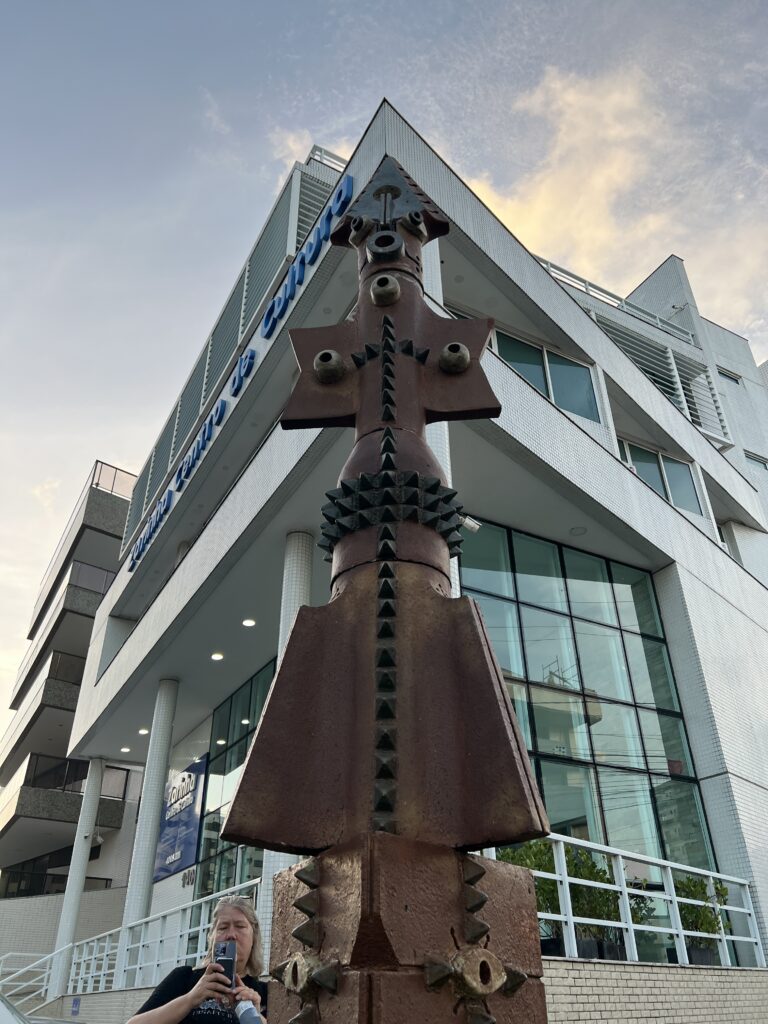
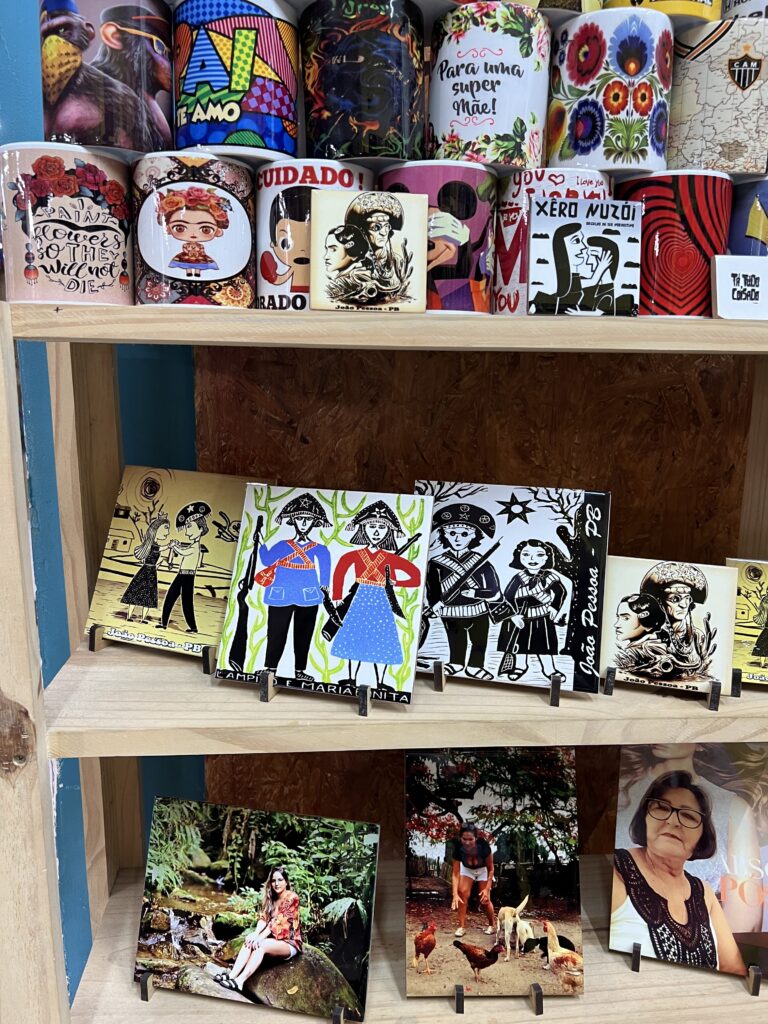


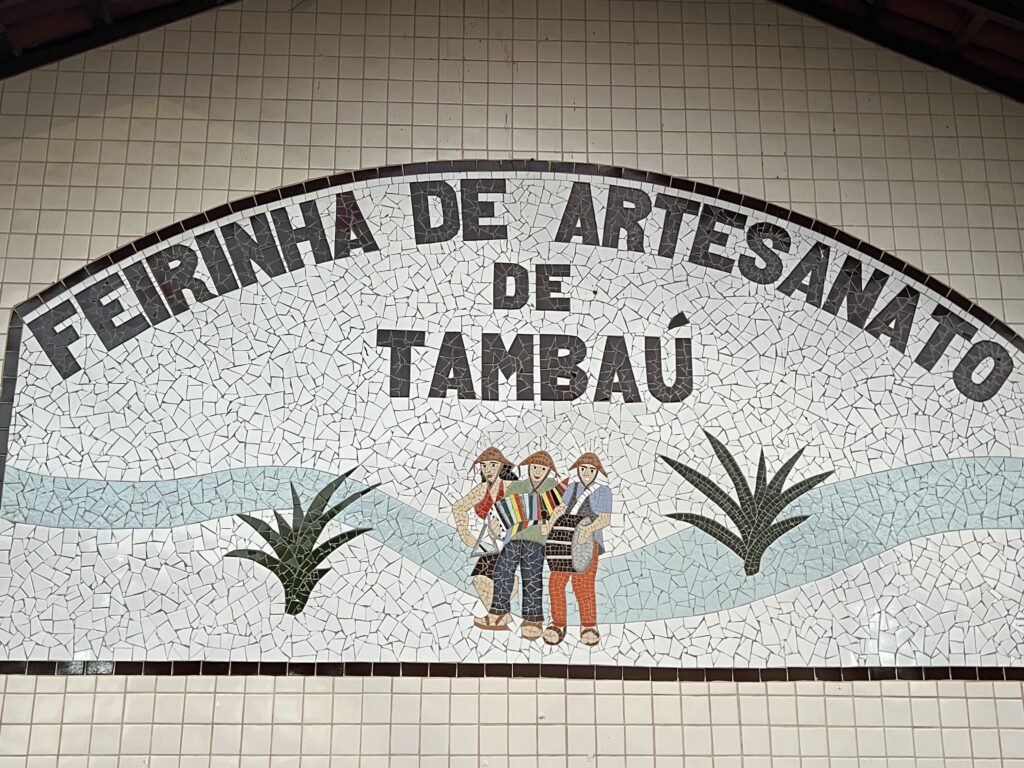
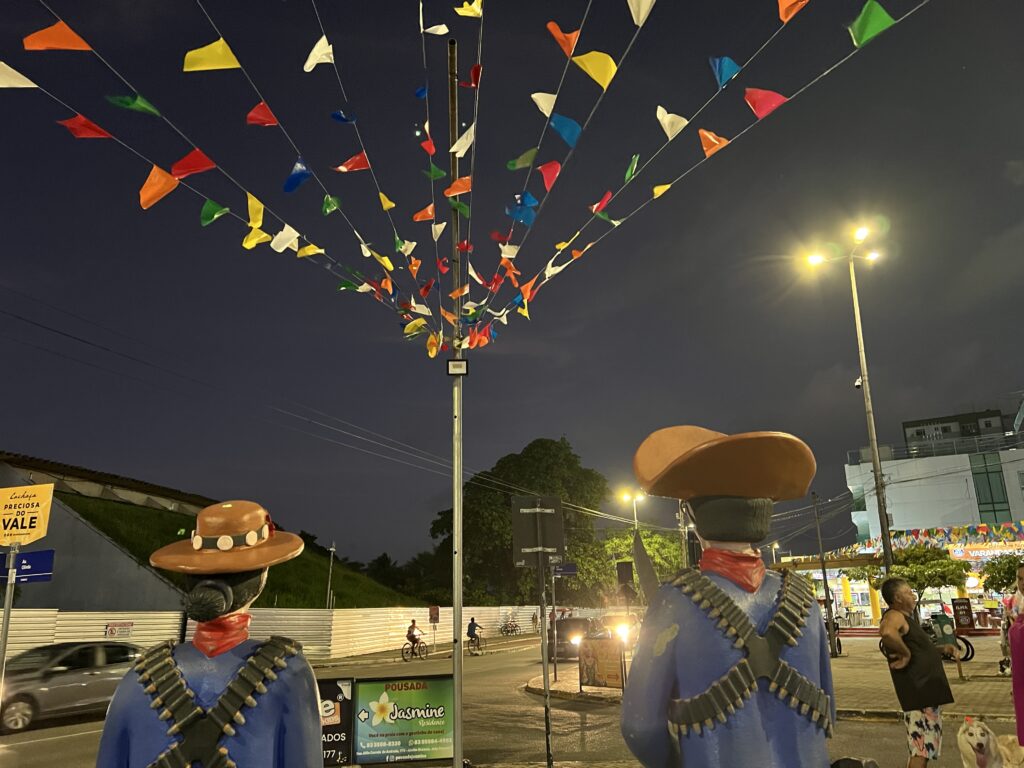
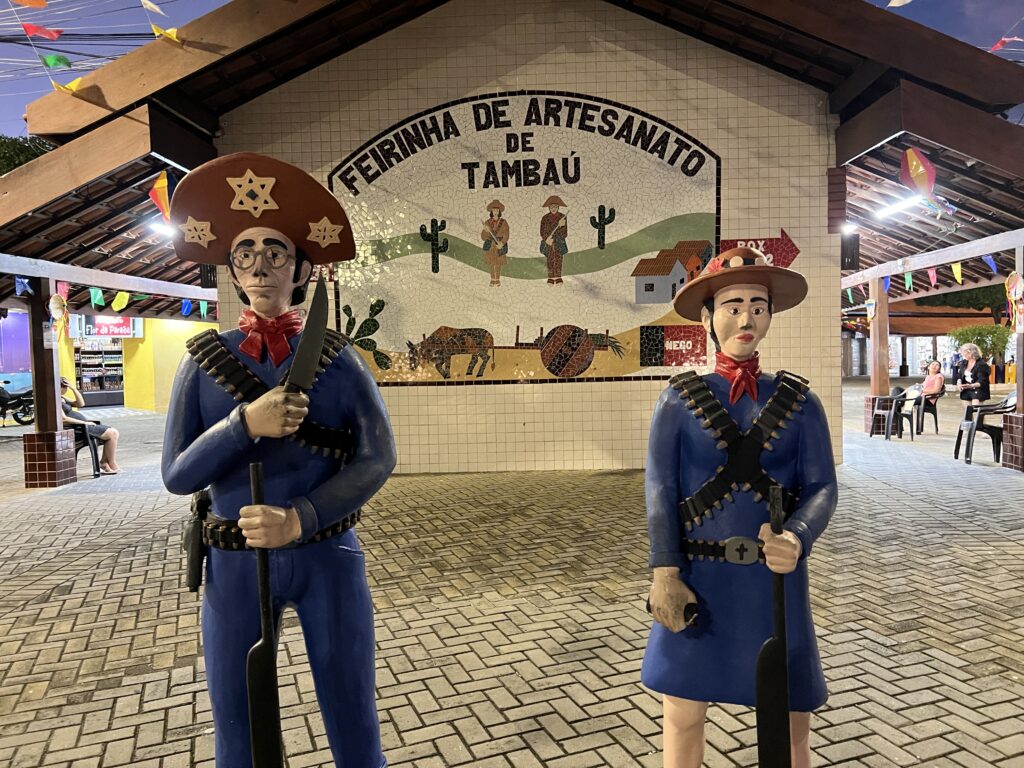


Update: Friday, June 21
“Day 9 & 10” – Entry by Philip Kohnen
The Gauntlet, Part 1
We said goodbye to our home in João Pessoa and hit the road for a small town atop a large hill. Leaving the city and heading into the interior felt familiar. We enjoyed an absolutely stunning drive, through small towns on the side of the highway, to even smaller towns on the state roads. Passing through these communities was a treat for us; the locals glaring in disbelief at this rag-tag bunch of gringos.
Rolling into Serra Da Raiz was completely surreal. The town was a living time capsule; a church at the top of a hill, with a town square below. The signature multi-colored flags for Sao Joao blanketed the town. We were greeted by our tour manager, PC, the concert organizer and producer.
After a quick sound check, we were led into the green room where they had loads of cakes, pastries and drinks for us. We greeted the other musicians who came in and out of the green room, and seeing that most of the bands had a “uniform” that they were revealing at their showtime. Some of us went out to capture photos of the sunset over the festivities, absorbing the pink sky and bright moon over palm trees.
We saw Natan again, this time as part of a Sanfona Orchestra. This was a group of 12+ accordionists, all gathered together, playing with a Zabumba, triangle, flute, percussion and a singer. A conductor led the orchestra, and it was one of the most amazing musical performances I have ever witnessed. The scale and complexity of the whole operation just gave me chills and transmitted rapid fire inspiration across every synapse in my brain.
As the next band started to play, I realized very quickly that these musicians were the best of the best, and that the audience at this festival was going to be expecting the same caliber of performance from us. I’ve not experienced stage fright like this before. Not only was I about to perform for a large crowd, but I was in THEIR home, playing THEIR music, on THEIR stage.
Hidden away on the back porch behind the green room, I practiced some of the chords to the new songs we had learned, secretly engaging in classic neurotic overthinking. Nic came to check on me and let me know that our call time was nigh. So it goes.
We gathered on the stairs behind the stage, listening to the hosts introduce us, asking “Can you believe there is an American band here in Serra da Raiz to play Forró?” I suppose we were asking ourselves the same question throughout the trip. I know I was.
Taking the stage, we focused on getting started as quickly as possible. Priority number one was to impress quickly and not stop for more than a few seconds. In a flash we were off to the races, banging out songs like a blacksmith with a hot hammer. They were dancing! They were smiling and truly enjoying our set. I guess this was a surprise to me. Not only were they dancing, but all of a sudden I felt at home. The audience was moving and shaking, spontaneously starting conga lines and dance tunnels, just like at Hendershot’s and beyond in Athens.
It was the music that mattered, not the nationality of the band. Any remaining concern about our cultural appropriation of Forró dissolved in my mind; I felt accepted and encouraged in the musical homeland. We already had two Brazilians in the band, but each passing day made me feel more like an honorary Brazilian. We even got to sign a petition to make Forró a national heritage form of art, contributing our signatures to protect the music that we had come to love.
Packed, loaded and almost ready. Some schmoozing was in order, as Freeman had been asked to sing an a cappella version of “A Natureza das Coisas” to send to Flavió José, the author of the song. Finally we hit the road for a 4+ hour drive, slated to arrive in Olinda by 4:30 am or later.
The grapefruit colored sunrise was starting to peek out as we shuffled into the apartment in Olinda. First peeking at the ocean and sunrise, I decided to sleep for two hours. We were slated to perform at a K-12 school in three hours…
The Gauntlet, Part 2
Alarms buzzed, a collective groan in unknown unison. Packed and ready to go again, we drove towards Recife to meet our youngest audience yet.
We were greeted by Marilson, the organizer of the show and former full time teacher at the school. We were brought to the headmaster’s office to meet and greet, and then we were led into the first auditorium. These were seniors in high school so we naturally expected blank stares and disinterest. We were very wrong.
While still technically in a zombie like state of sleep deprivation, all of our spirits were lifted like boats at high tide from the energy spouting forth from this audience. These people were really digging it! They knew the songs, they were singing along, and they were really enjoying hearing Freeman surprise them, busting out his perfect Portuguese pronunciation. Lucas joked that there would be many diary entries later that evening.
We were on the last song, saying thank you to the crowd, and when we finished, they demanded “Mais Um, Mais Um, Um.” Then the strangest thing happened… They spontaneously started rhythmically chanting “Os Bichos Vivos” over and over again. It was magical and heartwarming. Erica sent a Go Pro camera out into the crowd, capturing the perspective of these high schoolers watching an American band play Forró.
Our next performance would be in about half an hour, so we had a quick turnaround time for setting up on the main stage in the outdoor auditorium. Different class groups were shuffling in, the brave students trying out their English with us, only to shy away when they didn’t understand our response. I explained in my broken Portuguese that what mattered was to try, and that I crash and burn habitually when speaking another language.
I had been speaking to my wife and children each day, FaceTime and all, but it was hitting me pretty hard at that moment. These kids were the same age as mine, and I was really missing them more than ever.
The rest of the classes lined up, and our sound check was complete. It was time to go. At this point, having performed and rehearsed so many times in the past few days, we had our set down like clockwork, breaking out the blacksmith’s hammer again and keeping the songs coming. I didn’t know what to expect from the kids, but they did not disappoint. They were full of energy, again lifting our spirits and challenging us to up the ante of our performance. They were relentless; the chant slowly started again, reaching a crescendo. “Os Bichos Vivos,” they sang, clapping and demanding more music. We obliged, playing one more “Pagode Russo” for the road.
After our performance, we were invited back up the headmaster’s office and into a conference room. Cakes, croquettes, coffee, and Coca-Cola lined the tables, Marilson handing each of us a thank you gift bag and asking us to eat as much as we could. We made a plan to hang out with Marilson at the beach a few days later, and then made our way out, thanking everyone as we left the school.
A collective sigh was released as we left the school, knowing that all of our scheduled gigs had been completed. We were relieved, yet simultaneously feeling instant “Saudade.” Exhaustion quickly overtook us, and we all took the afternoon to rest.
After a short siesta, Todd and I were awake and wanting to explore, so we started walking up the hill and found the Convent of Saint Frances of Olinda two doors down from our apartment. This building was constructed in 1535, and housed the largest collection of Portuguese tiles from the 17th and 18th century. These was something special about entering a building that was older than most classical music, Todd explained. After moment upon moment of awe and wonder, we finally exited the monetary and walked up the remainder of the hill.
We found one of the most amazing views I have ever seen at the top of the hill, overlooking Olinda and Recife to the south. Old world architecture and a modern city skyline merged into one vista, encapsulating Brazil’s duality of historical heritage and ubiquitous modernity.
In this moment, I had a strong feeling of appreciation for all of the people that made this moment happen. Our band had been dreaming of this trip for years, never really expecting it to come true. However, against all odds, here we were. We had come to absorb and learn, but didn’t anticipate how much growth we would all experience, both musically and culturally. I felt an overwhelming sense of joy, recognizing how lucky I was to be part of a group of musicians that felt like family.
Turning in early for the night was easy knowing that we had some more tourist activities planned for the next day. Goodnight Olinda!
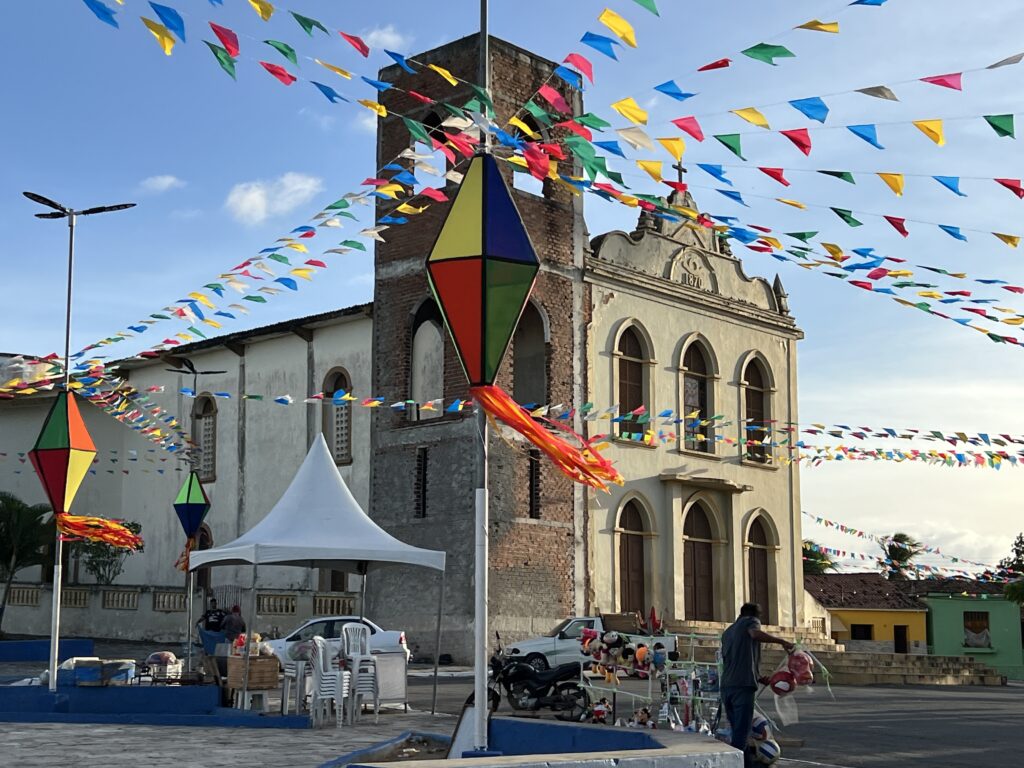


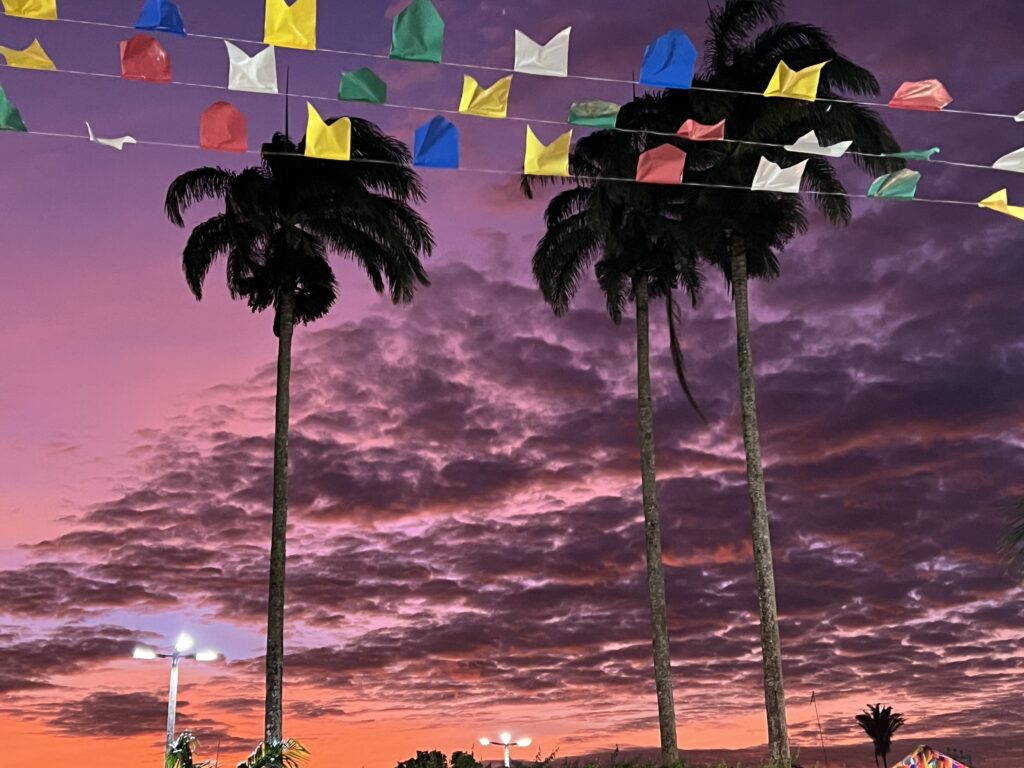

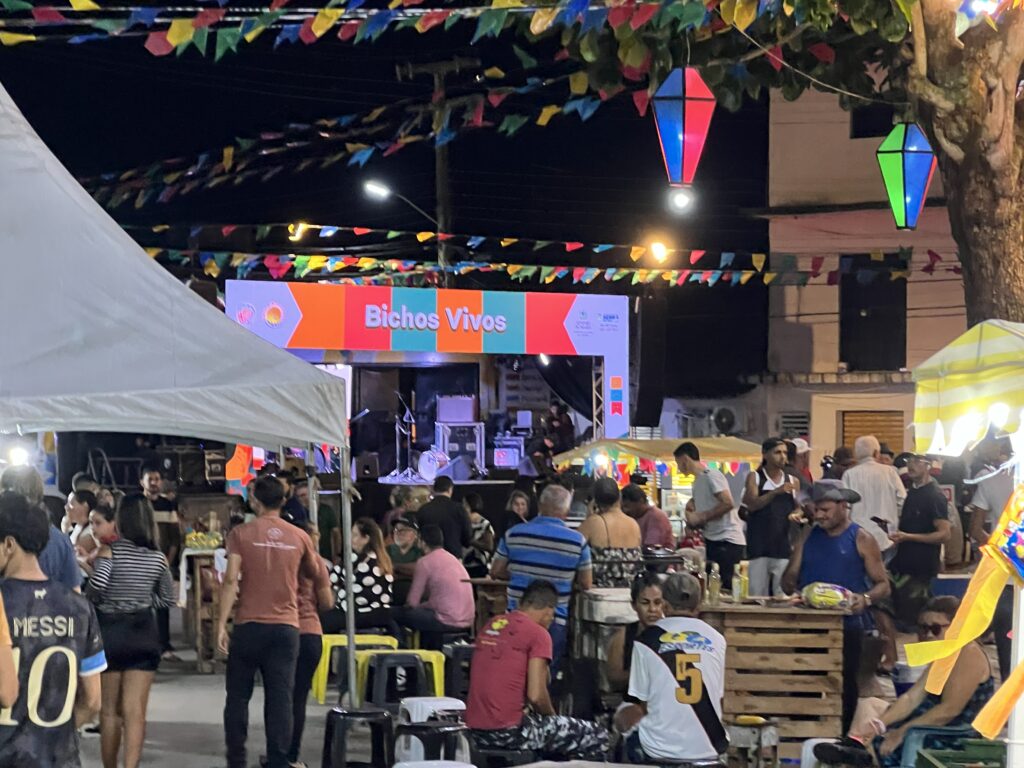
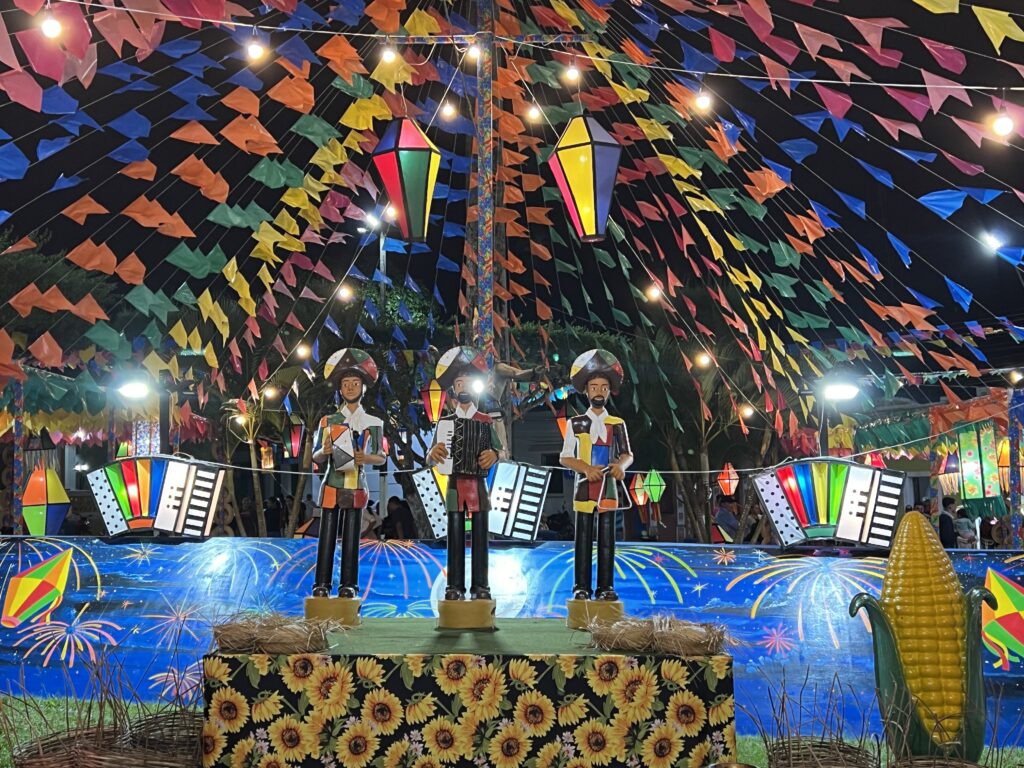
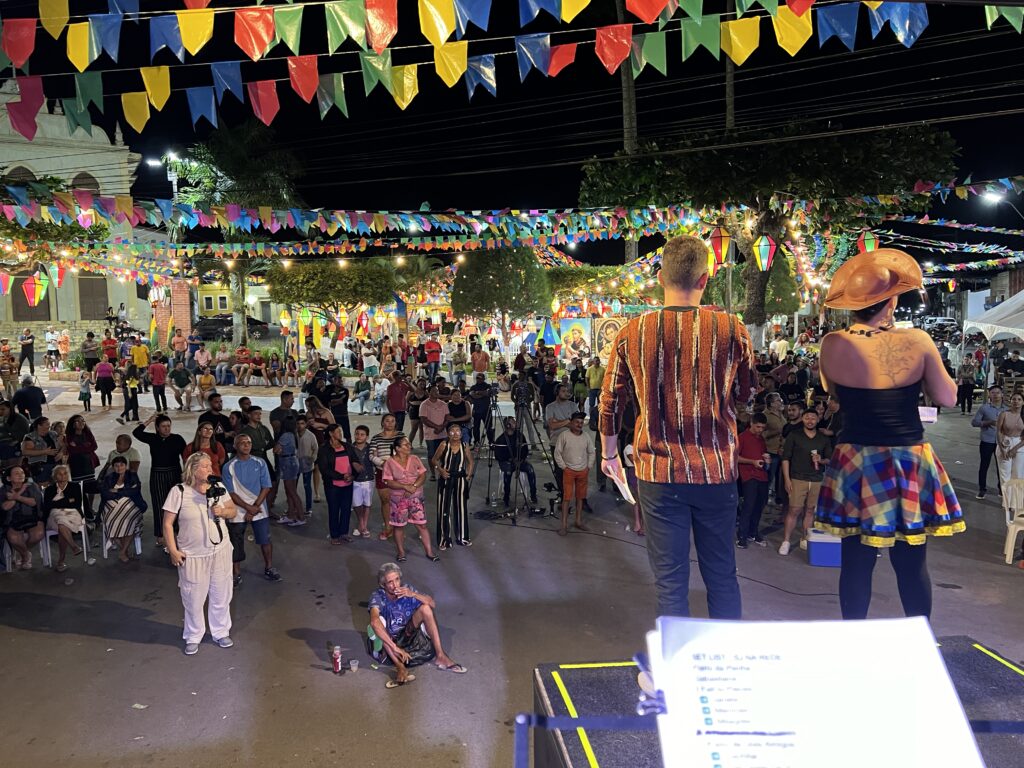
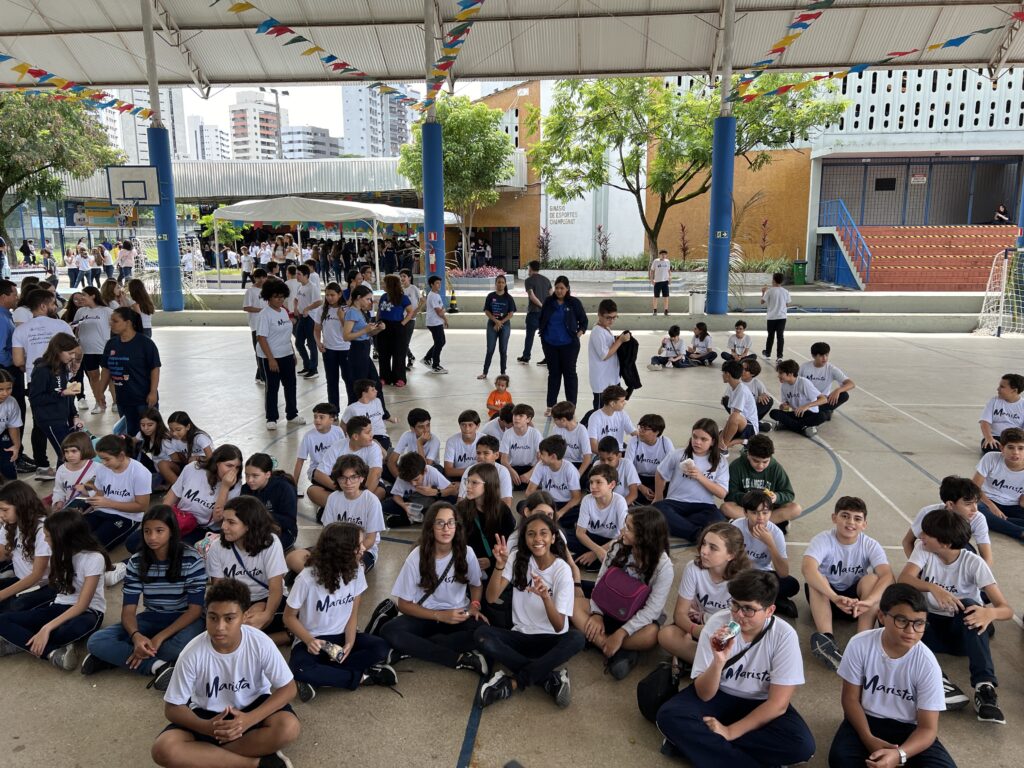
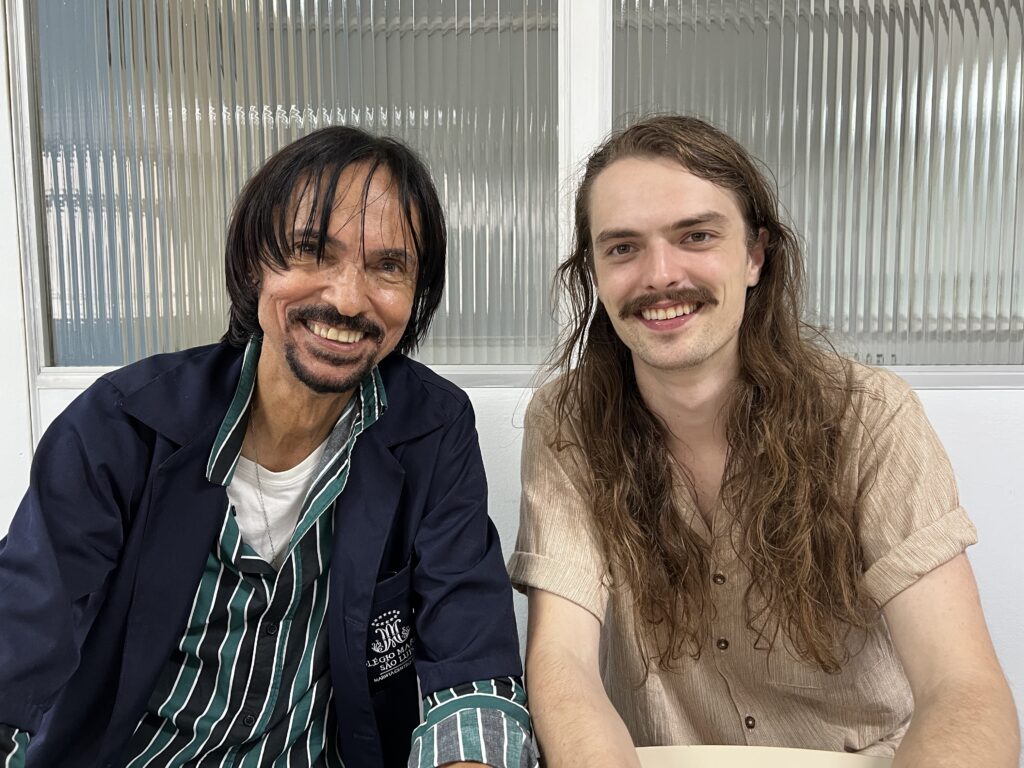
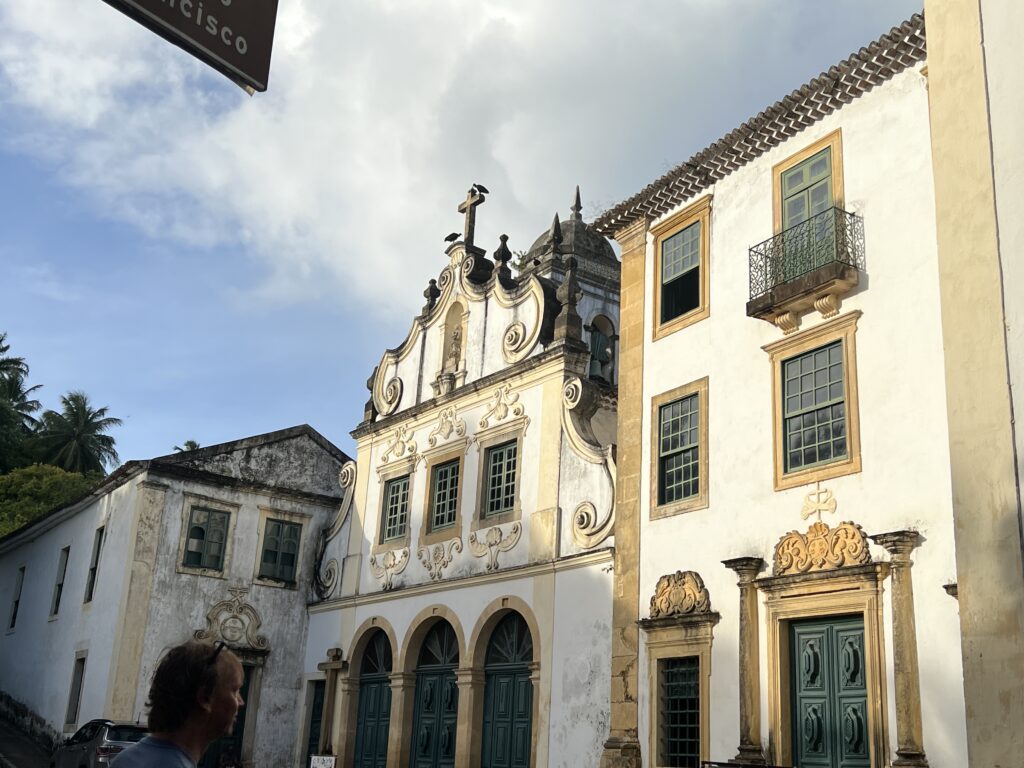


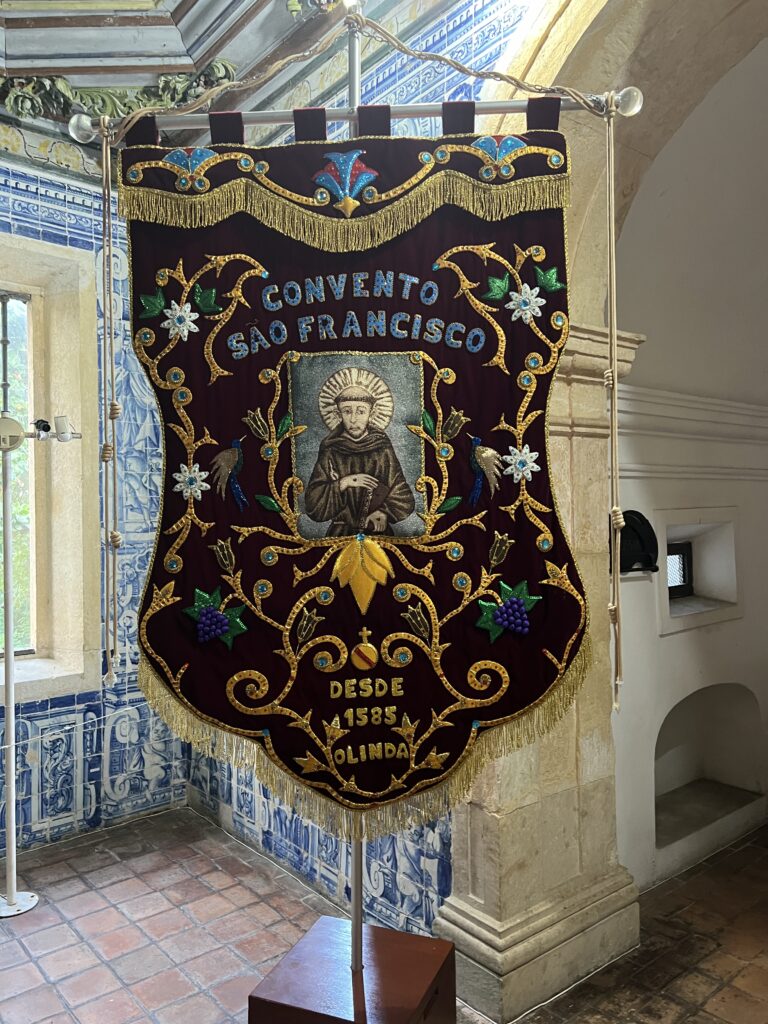
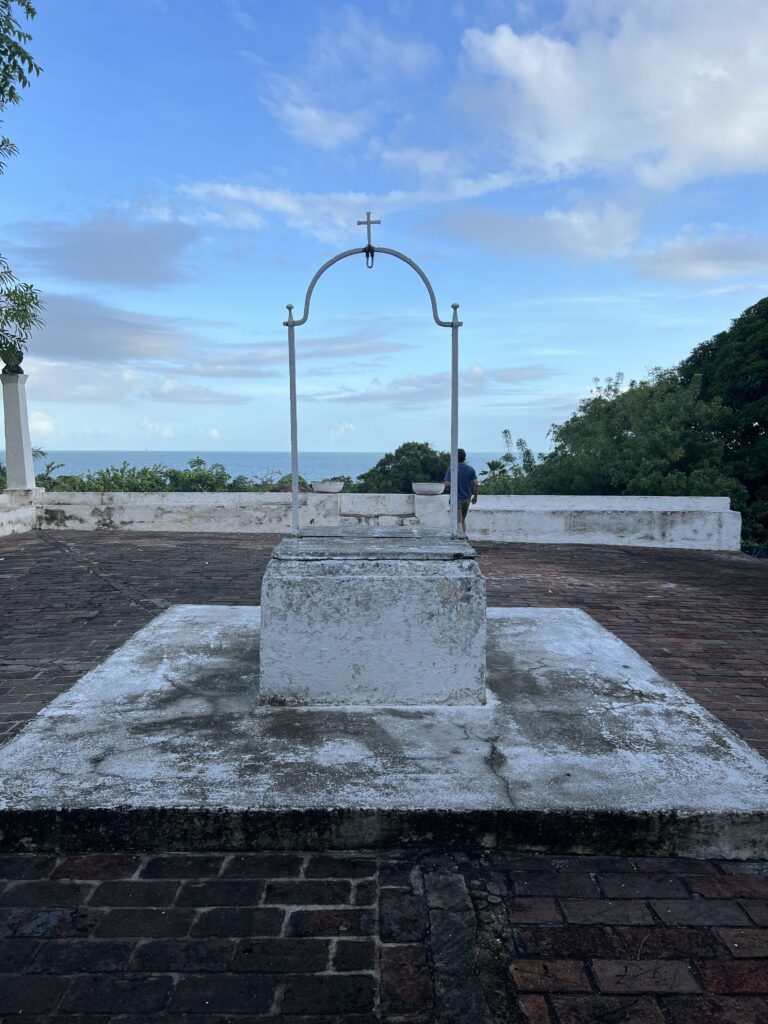
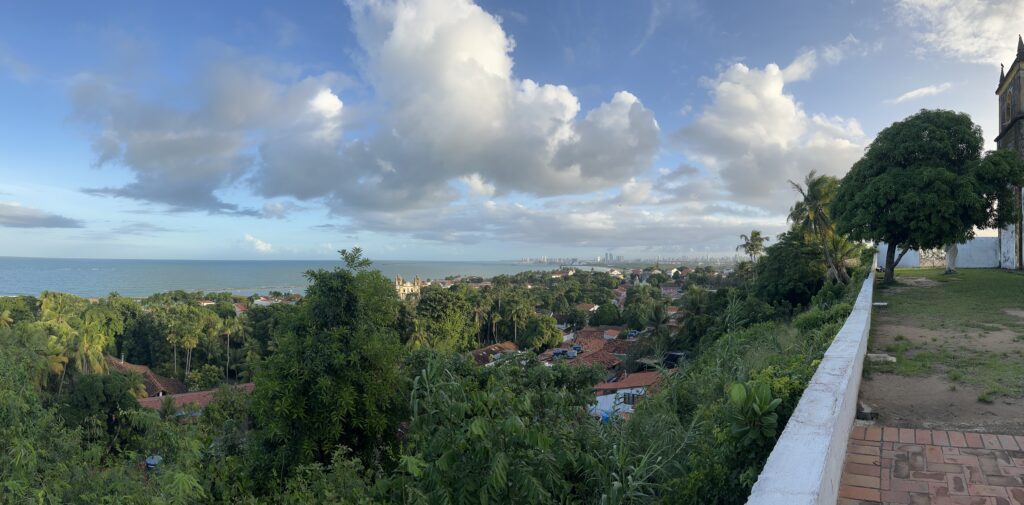



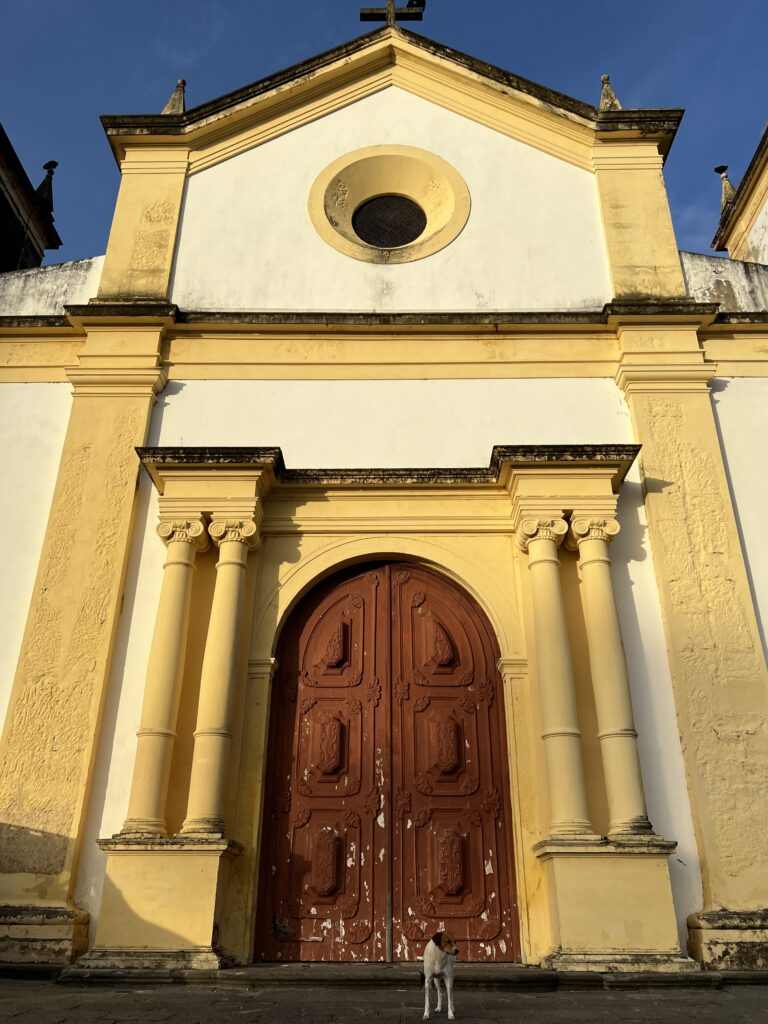
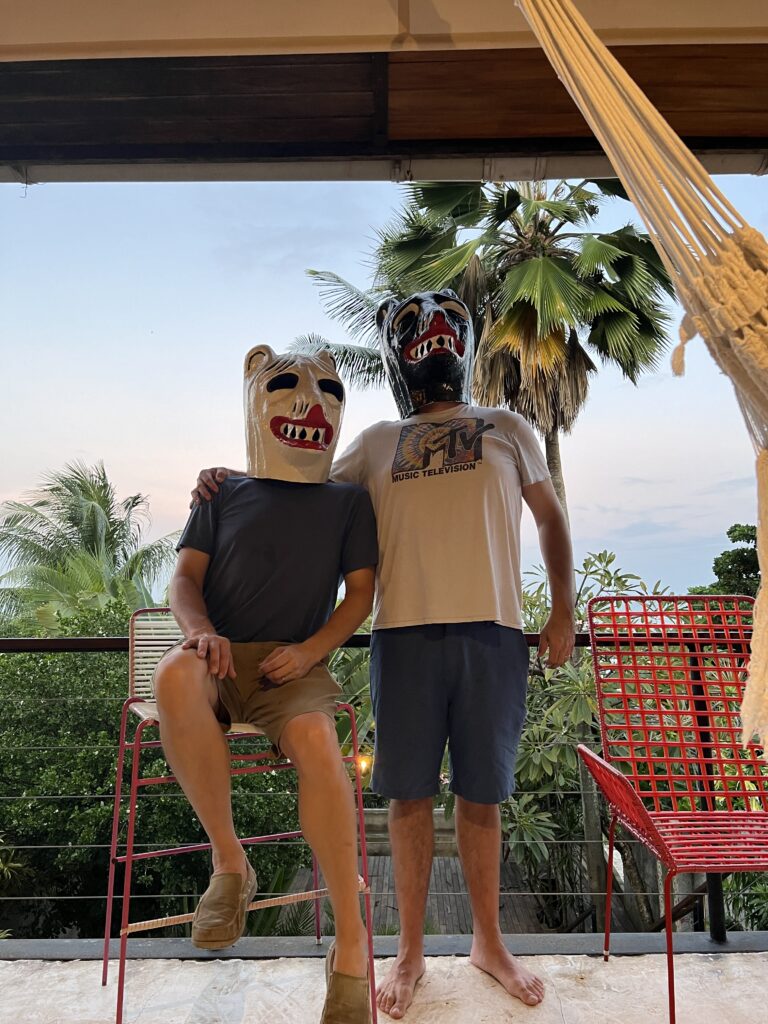
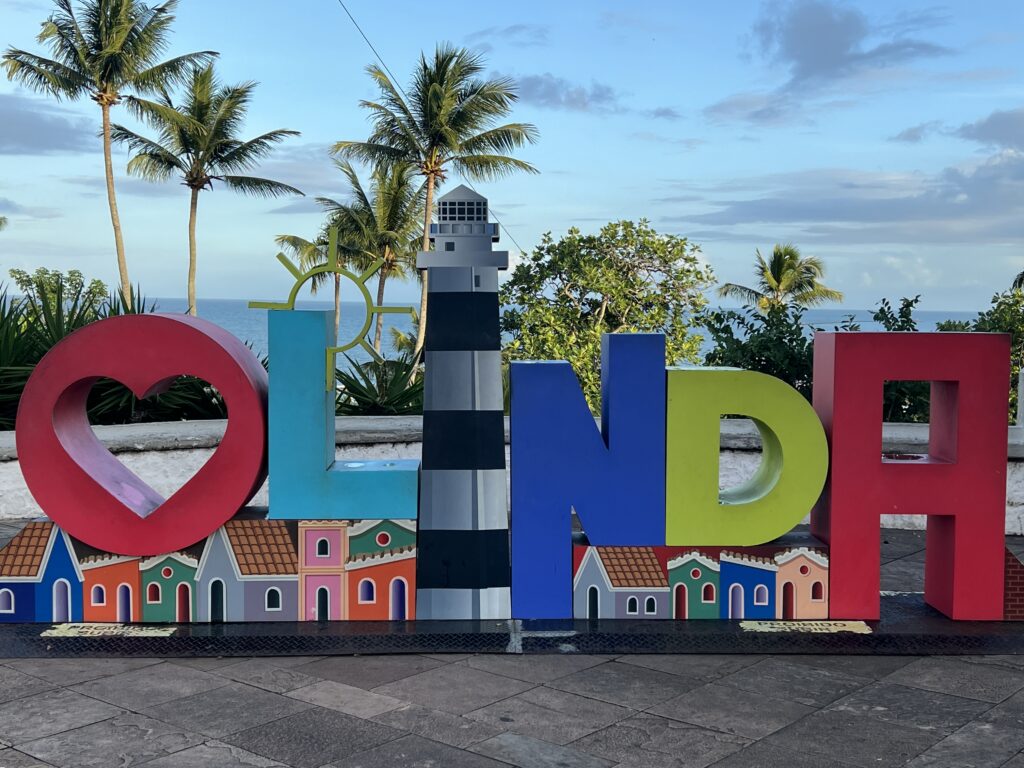
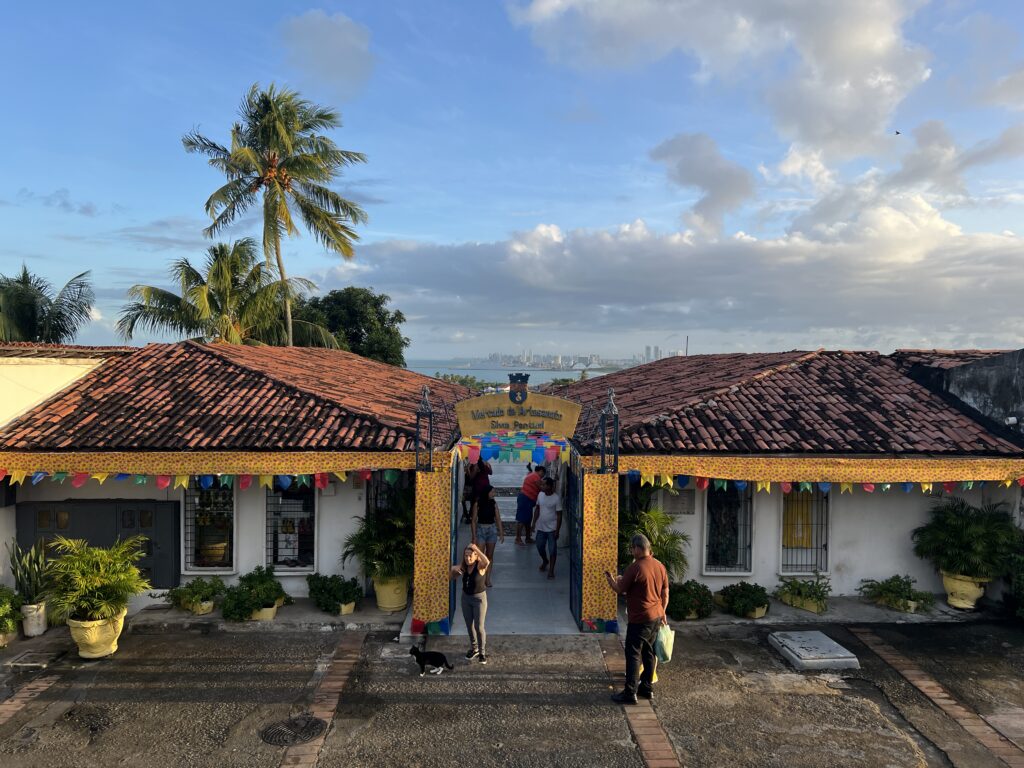
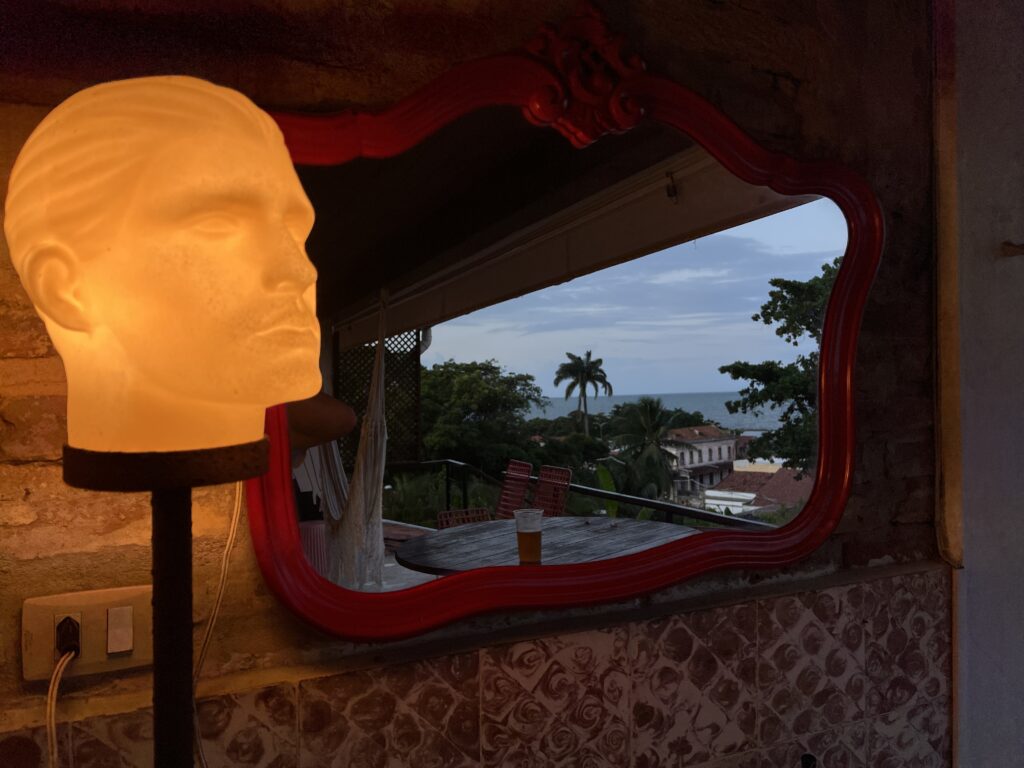
“Day 11” – Entry by Philip Kohnen
Designated as a UNESCO World Heritage site, Olinda was founded in the 16th century by the Portuguese, just north of the city of Recife, a major port for the exportation of sugar cane from Brazil. Rebuilt after the looting of the Dutch occupation, Olinda grew in importance as a cultural and religious center of the Kingdom of Brazil, an integral part of the Portuguese Empire.
Today, we would be tourists. As a group, we trekked up the hill once more, saying hello to the horse chilling by the monastery back gate, looking at the ocean. We toured the Catedral da Sé (Igreja de São Salvador do Mundo), a 16th century Church at the top of the hill. Stunning views and old world architecture held hands, peering out onto the ocean horizon below.
We explored Olinda, popping in and out of street side shops, hunting for souvenirs, T-shirts and figurines. After drinking fresh, cold coconut water, we chose to have lunch at a restaurant with a beautiful view of Olinda and Recife (fried shrimp and all). On our way back down, we saw a friendly horse roaming around the Monastery entrance, the same fine equine we had seen enjoying the views of the sea.
Later in the evening, Natalie led a cohort of the group back to Caruaru to see Vittoria Do Pifano perform on the main stage, while some of us stayed and enjoyed Nic’s Churrasco feast. Today, we were tourists, and we really appreciated the opportunity to unwind.
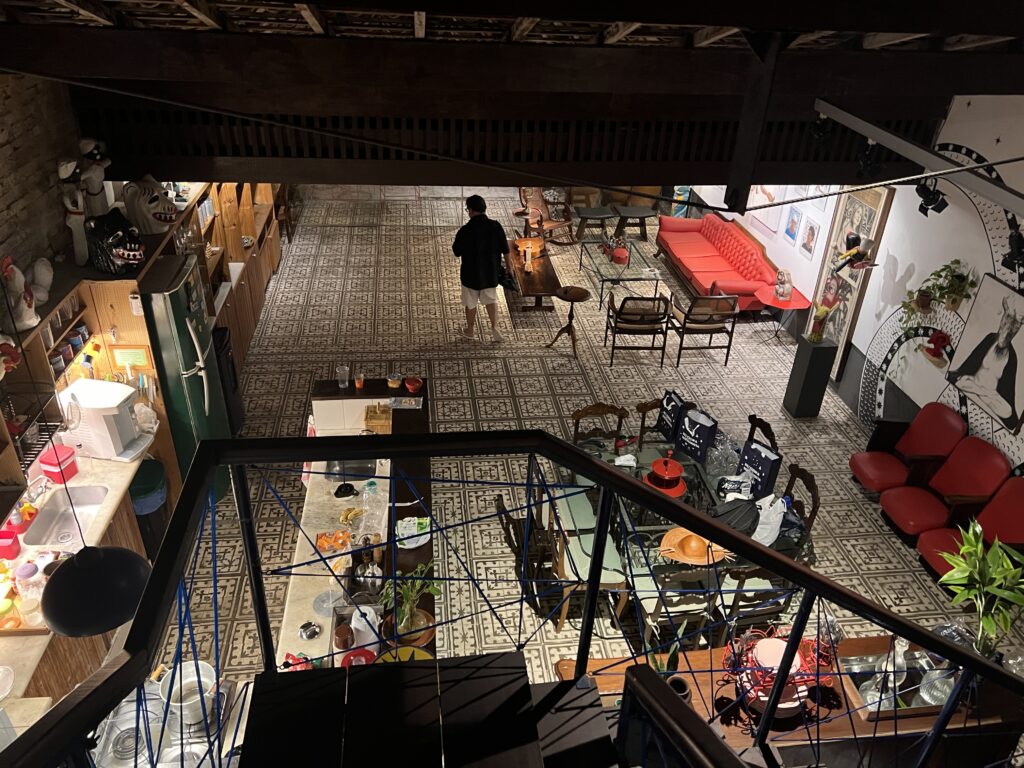
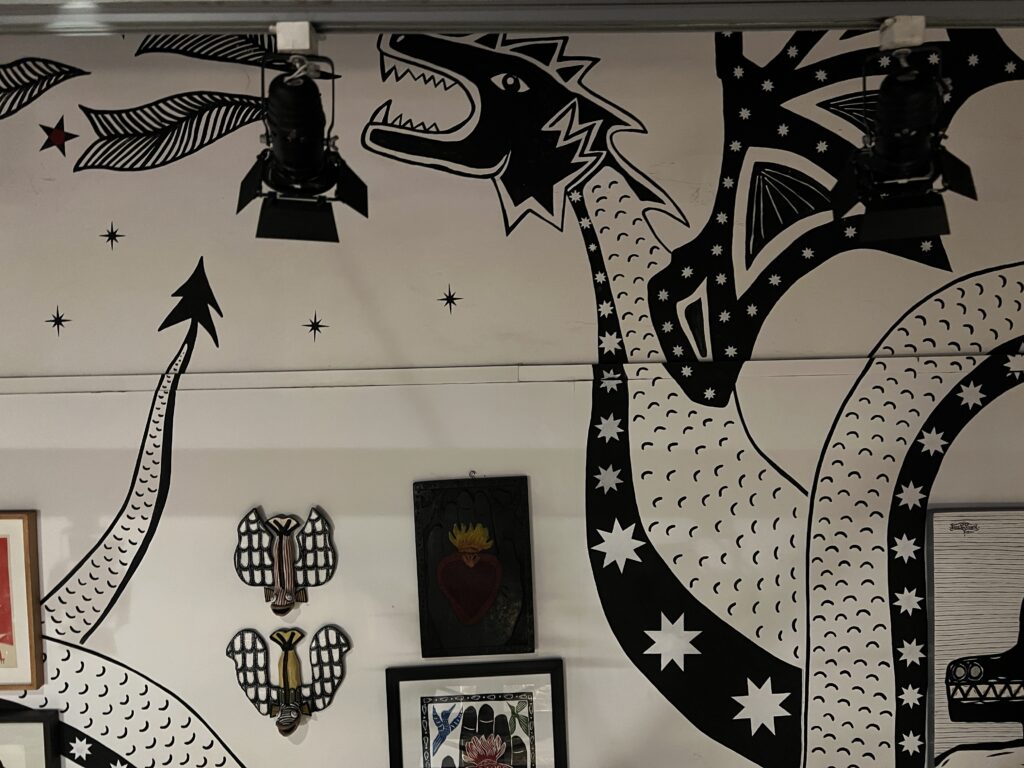

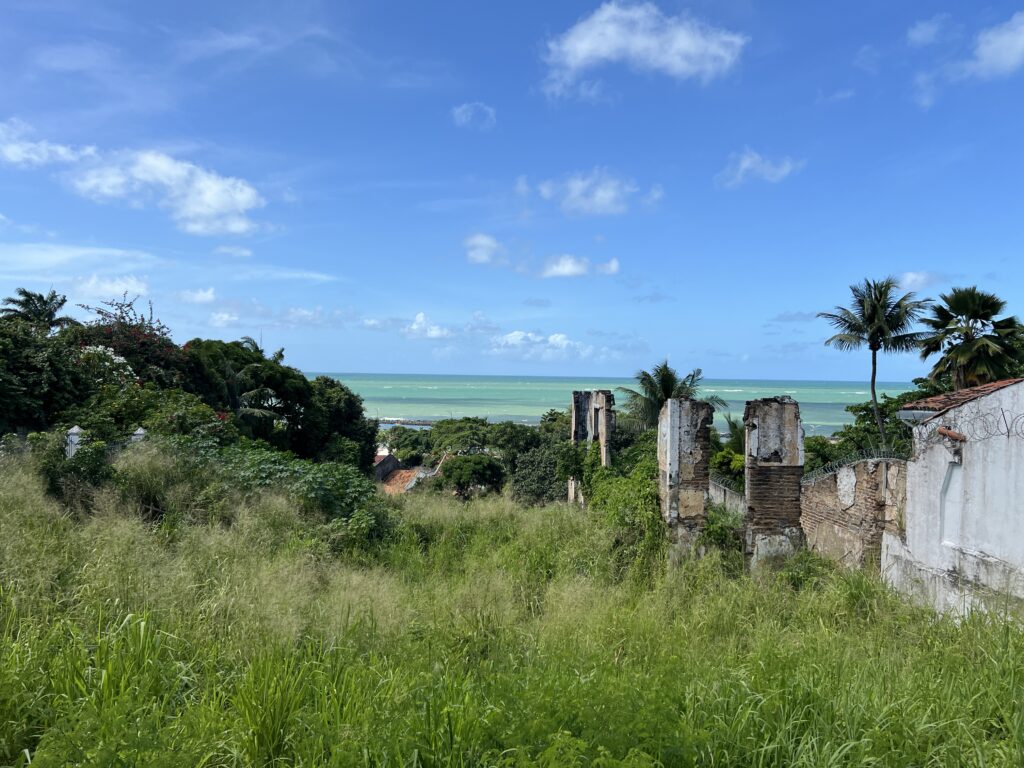





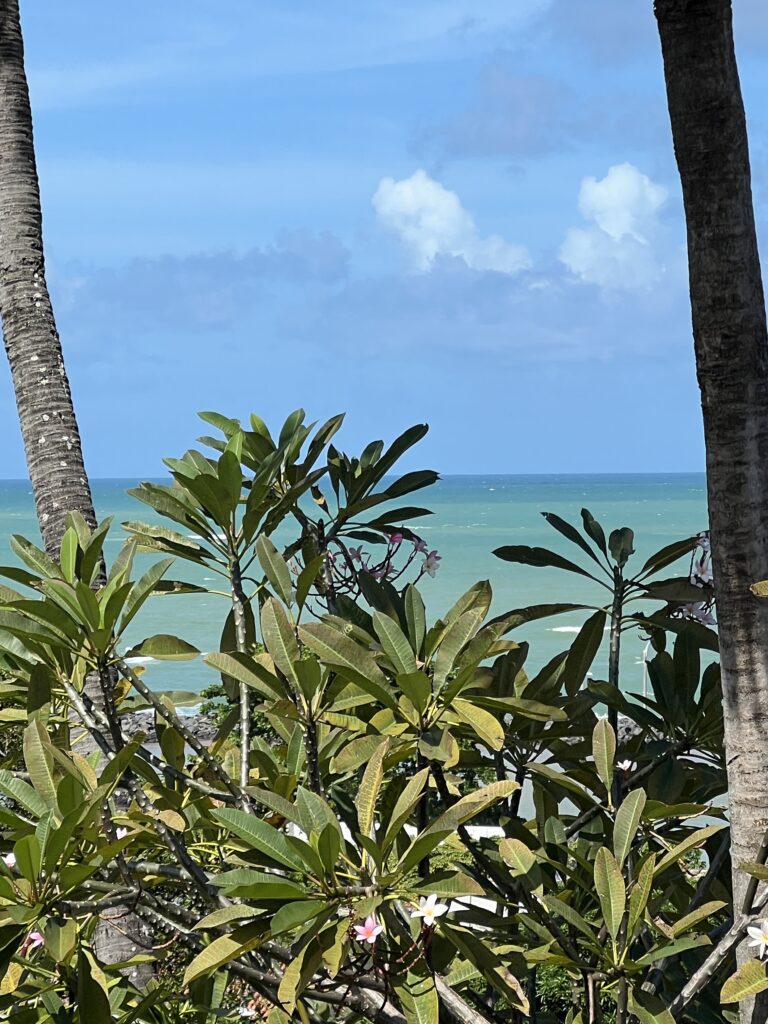
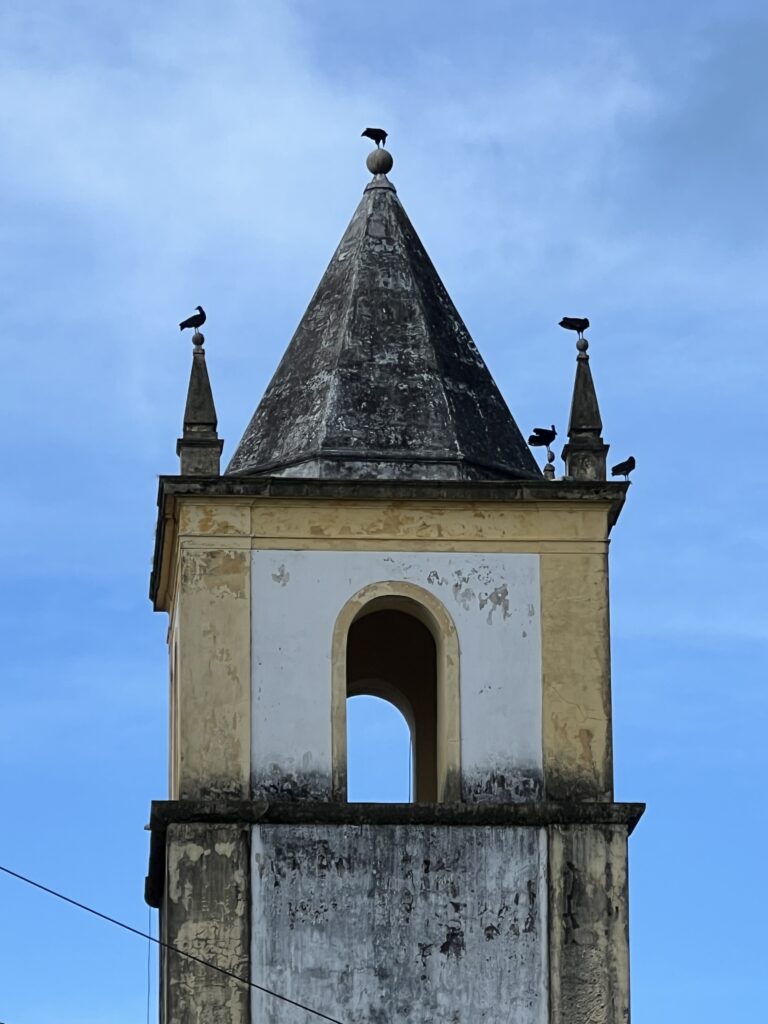

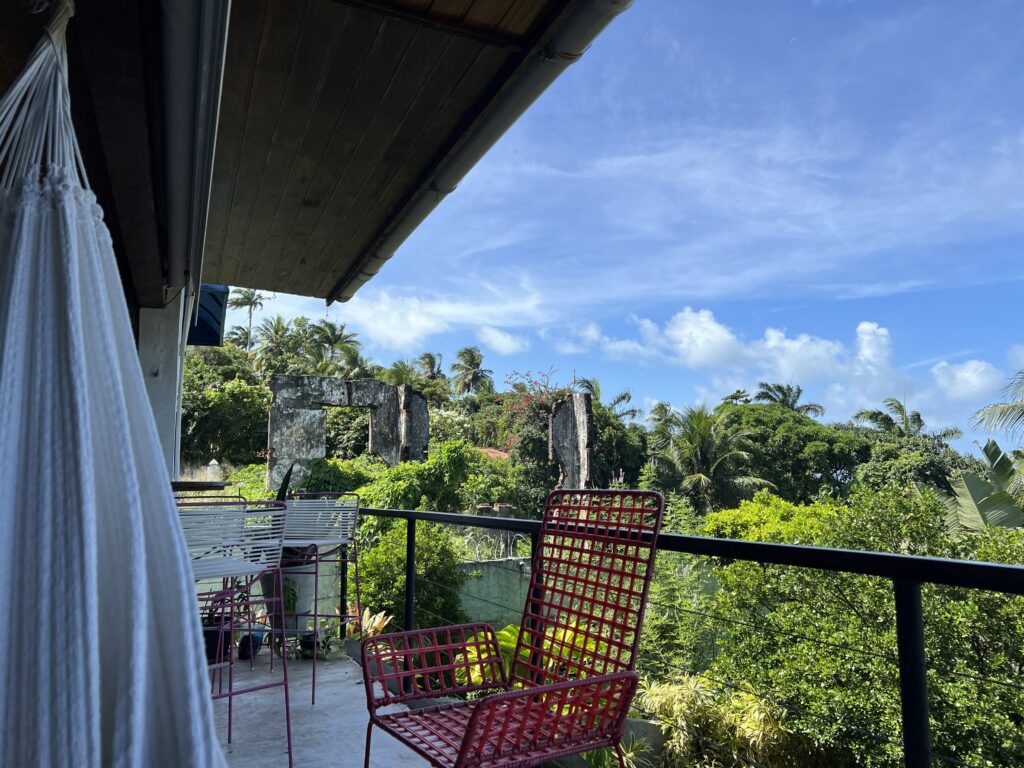
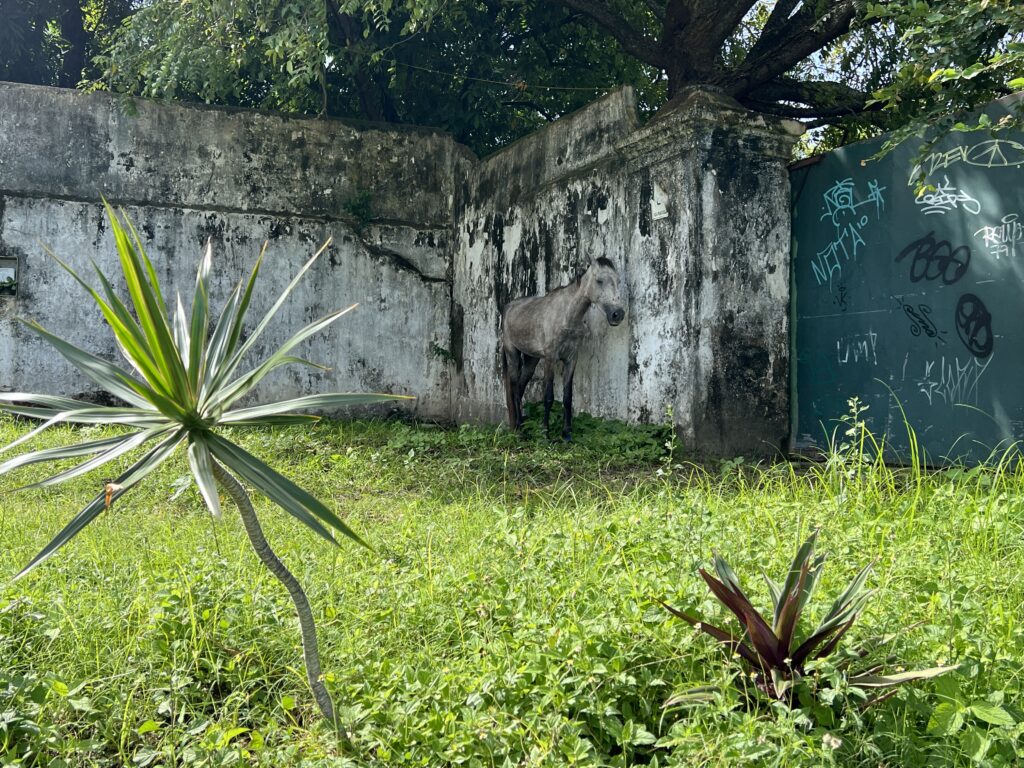
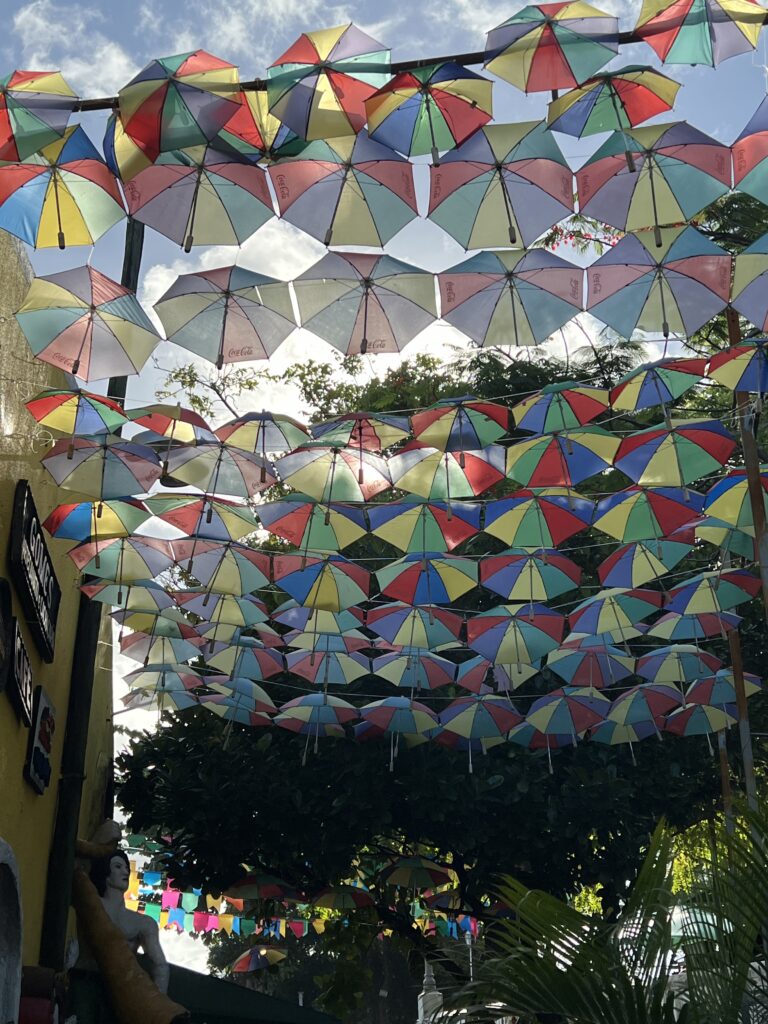


Update: Sunday, June 23
“Day 12: The Final Day” – Entry by Philip Kohnen
If you have ever seen Terry Gilliam’s Brazil, then you can imagine the theme song, and the tormented search for someone you have loved in your dreams. Past the ducts, the steam and the struggle, you fight your own final samurai boss (your own ego) and reunite with Robert DeNiro before he zip-lines out of the frame. “We’re all in this together.”
I was having some strange dreams in Olinda. The oddity and quirkiness of our apartment was a welcome surprise compared to our previous digs. This place was cool, and we felt cool being there. This felt like the imagined Brazil that I had been chasing; an experience that I was following through the darkness. The sunlight hit my eyes, waking me up from a deep, comfortable sleep.
Anticipating word from Marisol, we prepped to head into Recife. I was quite vocal about my desire to visit “Sinagoga Kahal Zur Israel,” the oldest synagogue in the western hemisphere. Luckily, I had willing participants to join, including Natalie Smith, who braved the driving in Brazil time and time again.
Walking through the historic district leading up to Kahal Zur was reminiscent of a stroll through Amsterdam on a beautiful day. Built during the Dutch rule of Brazil from 1630 to 1654, the neighborhood was a safe haven for Jews (whose ancestors had fled Portugal during the Inquisition, settling in Amsterdam). Having a knowledge of Portuguese, Dutch and Hebrew, they were integral in the expansion of Dutch mercantilism. When they came, they brought their religious practices with them.
Visiting the synagogue was truly a special moment for me. I love archeology and history, and this site had both! It was rediscovered in 2004 after centuries of being hidden from the world, adding a new chapter to Brazil’s history that had been lost when the Portuguese recaptured Brazil from the Dutch, again enforcing Christianity.
The Jews that lived in Recife were forced to flee, and became the first Jews to be admitted to New Amsterdam. Some groups stayed and converted, while others fled into the interior of Brazil, hiding in the Sertão to maintain religious freedom. Did the Star of David imagery seen in some of the Cangaceiro hats have anything to do with this? I finished up the tour and stepped out onto the sidewalk.
The rain slowly stopped, and sunshine was quick to follow. I felt at home, as if I had already been here a million times. I sat down, enjoying bird songs, refracting light and city hustle bustle. I could see the ocean through an alley. The cobblestones in the road were asking me to give them a try. Wait…
I was soon joined by the rest of our group, quickly dipping into the nearest cafe for Pao de Queijo and Coffee, coconut cakes and lemon soda that I thought was water.
Our feet hit the cobblestones, headed toward the Praça do Marco Zero, a plaza on the waterfront. Very picturesque, we agreed. Very European.
Next, Marilson and Boa Viagem greeted us with open arms. Sporadic rain and sunshine alternated, taking turns saying hello. Our beach valet came to our rescue when windy rain came, blocking every angle with umbrellas, ensuring our peace was not disturbed.
After bidding farewell to Marilson, we returned back to the apartment and planned one more dinner in Olinda’s historic district. Visiting Cafeteria Arte Mache was really cool; the wonderful owner suggested a Japanese restaurant called Latash Restaurante. We also met the owner of this establishment, and she was a gem, an absolute guiding light for our last meal as a group.
Our trip had come to an end. We had one more sleep, followed by an early departure to ensure we would catch our flight. We all said goodnight, smiling and happy that we had this experience and that we would all return to our friends and family very soon.
Muito Prazer, Brazil. Muito obrigado.
We’re all in this together.


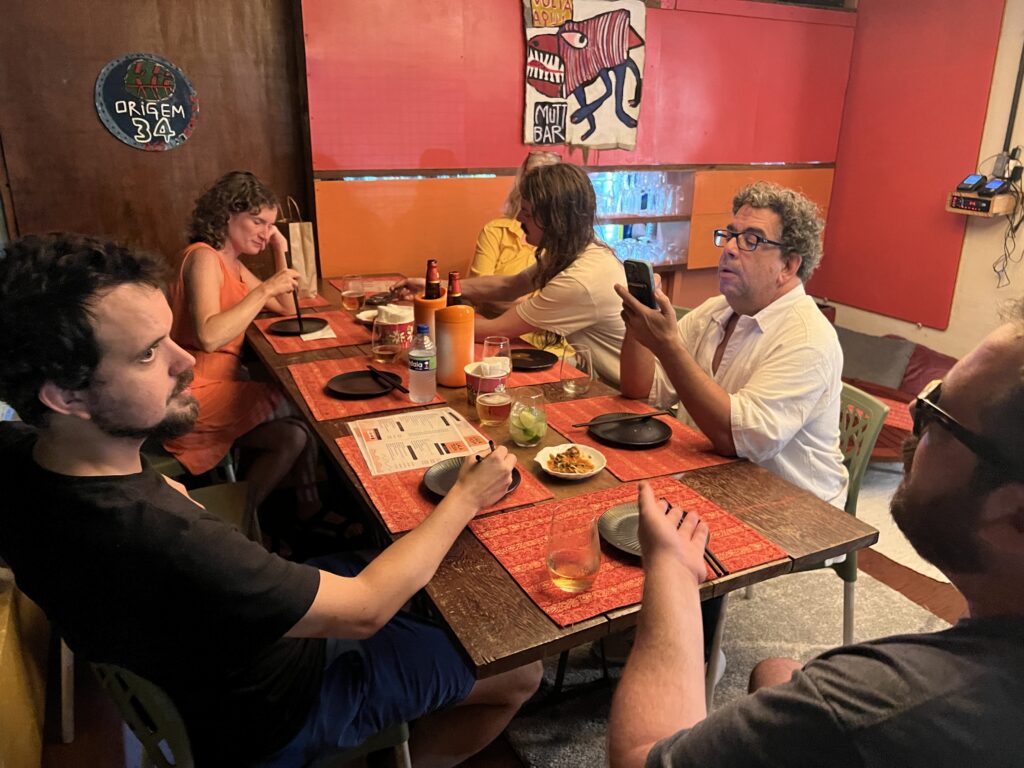
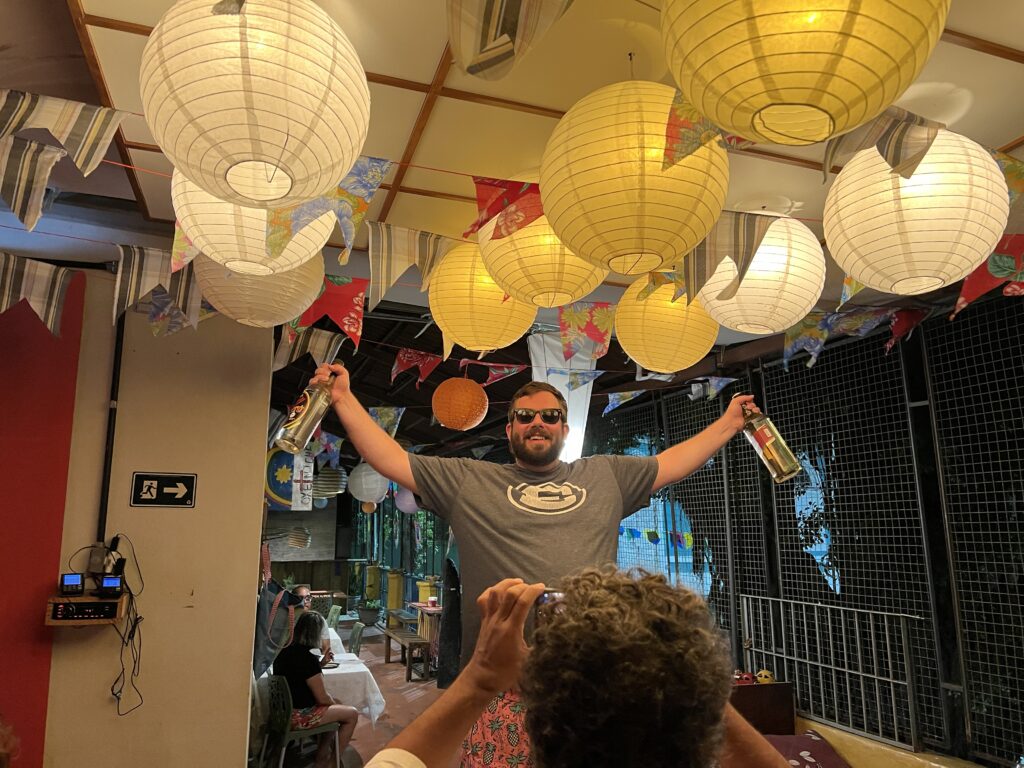


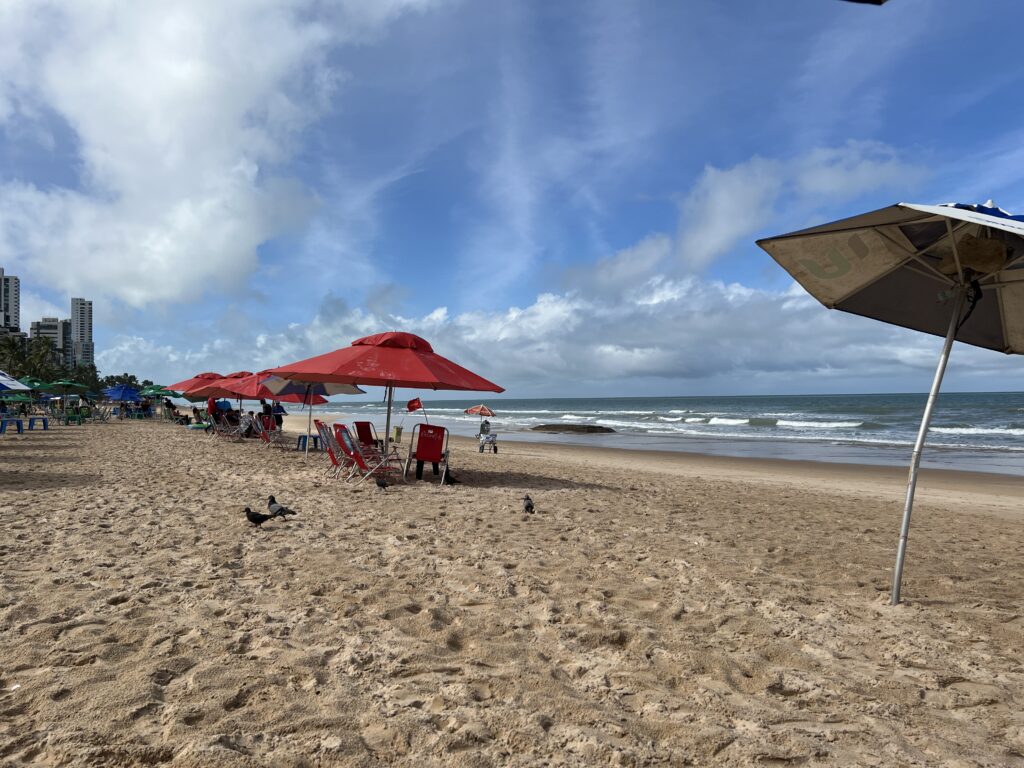
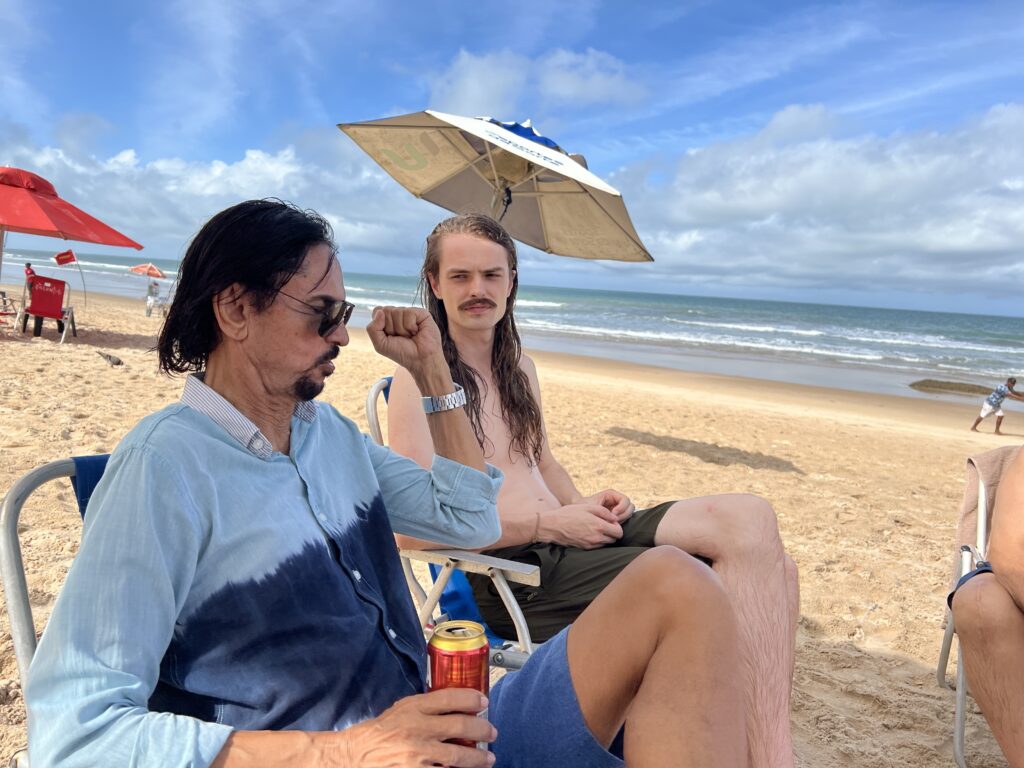

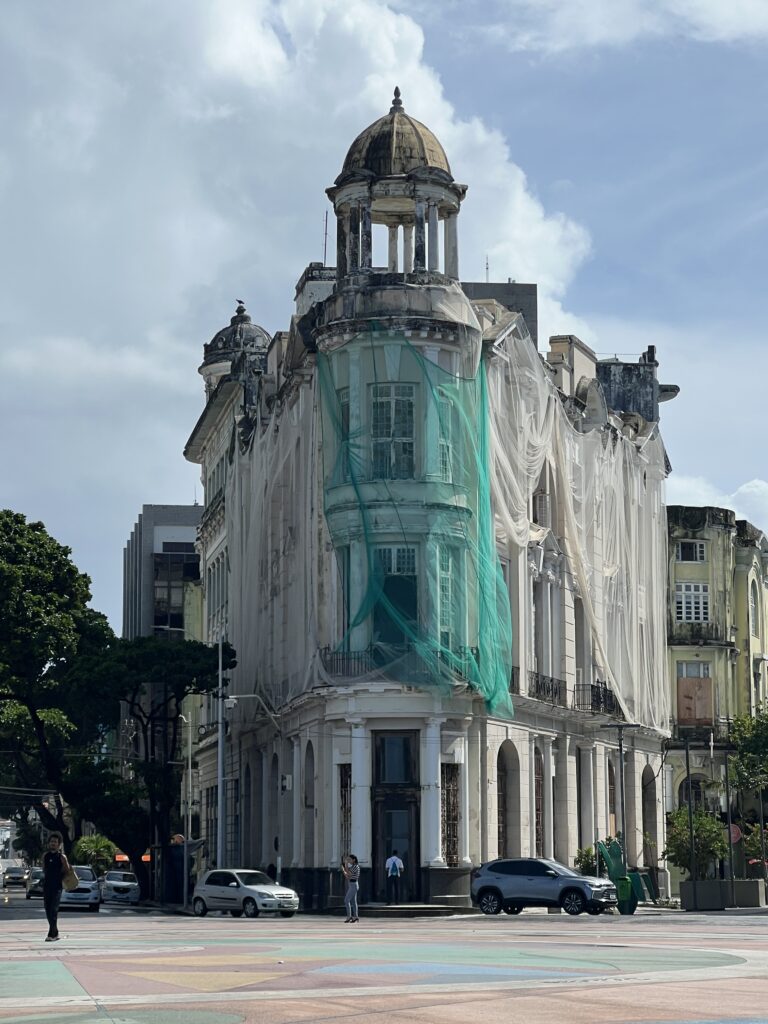

Like what you just read? Support Flagpole by making a donation today. Every dollar you give helps fund our ongoing mission to provide Athens with quality, independent journalism.





